- Skip to primary navigation
- Skip to main content
- Skip to primary sidebar
- Skip to footer
Yacht Cruising Lifestyle
Everything fun you can do from your yacht

20 Blue Water Cruising Catamarans Under $100k
October 13, 2021 by Martin Parker 1 Comment
The debate between single-hull sailboats and blue water catamarans has raged since the beginning of time, and it’s unlikely ever to end! Both types of yachts have dedicated followers who are unlikely to ever be swayed by the benefits of the other. A lot of this is based on misconceptions and the influences of the people around them, though. We recommend that if you’re considering a blue water catamaran, get in a few good hours of sailing through varied conditions before making a decision.
What Makes Blue Water Catamarans Great for Cruising?
Stable platform s.
Bluewater catamarans offer fantastic stability, despite what you may hear from single-hull yacht owners. There’s no high lean angle when sailing into the wind and no need to strap everything down to prevent it from moving. Add to this little or no rolling when moored, and a catamaran is a lovely place to be.
Additional Space
An excellent beam to length ratio is essential on bluewater catamarans, and a 40-foot yacht will usually have a 20-foot beam. That gives you a 20-foot bridge deck, plenty of space on the hulls, and even more space forward on the netting.
Cruising Speed
The amount of wet surface area on a catamaran is significantly reduced compared to a monohull yacht. Without the need for a prominent, heavy keel for ballast, the catamaran can easily outperform a single hull yacht.
Shallow Draft s
Shallow draft boats allow easy navigation through shallow waters and exceptional stability for maximum comfort. You are far less likely to make mistakes with tide height predictions when sailing on a cat.
Enclosed Cockpit s
Bluewater catamarans virtually always have an enclosed cockpit. Not only does this shield you from the sun in winter, but the elements in winter making cruising far more comfortable.
Safety
The enclosed cockpit makes sailing safer, plus of course, when you need to get out on the deck, the stable catamaran is not pitching and rolling.
Our Top Choices For Blue Water Catamarans Under $100,000
Designed and built by Rajen Naidu, the Rayvin 30 is a 29.5-foot cruising catamaran built for comfort. With a draft of just one meter, there are few places you can’t go on the Rayvin. The hull is constructed of epoxy glass fiber, but carbon-kevlar has been used for added strength below the waterline.
Inside, you’ll find three cabins, plenty of space, and even a bath! These are great value blue water catamarans with excellent performance.
Prout Snowgoose 37
Probably one of the most well-known blue water catamarans available, the Snowgoose 37 was designed and built by Prout and Sons in the United Kingdom. With a displacement of 6 tons, this is not a light boat, but the 600 square feet sail area gives a healthy hull speed of up to 10 knots. Many people have completed a circumnavigation in a Snowgoose.
It has a cutter design, but the overhang is substantial, leaving it susceptible to bridge slam, particularly on a close reach.
Over 500 examples were built, with plenty available under the $100,000 mark.
Prout Quasar 50
Sticking with Prout, the Quasar 50 was the largest catamaran designed and built by the company. The company was still making the Quasar until its closure in 2020, so you can find plenty of examples.
Constructed with fiberglass, the cutter design has a displacement of 10 tons and a sail area of almost 1185 square feet, giving a maximum hull speed of around 14 knots.
It has to be said the Quasar is not a pretty boat, but it makes a perfect large cruiser.
Catalac 12M
Catalac was a British boat building company owned by Tom Lack, hence the Catalac name. Over 600 examples of Catalac’s (9M, 10M, 11M, and 12M) were built. All around, they’re known as solid boats that handle well.
Designed as a sloop, the 12M displaces almost 9.3 tons. With a sail area of just 700 square feet, this cat offers a relatively slow hull speed of 9.5 knots.
An interesting point is the double thickness hulls, designed to withstand the North Sea weather.
Maldives 32
The Maldives 32 is a more modern design by Joubert-Nivelt. It features a short overhang with a netting deck to avoid bridge slam, initially built by Fountaine Pajot in 1988. The Maldives has a light displacement of 3.3 tons thanks to the fiberglass and foam sandwich construction. Add in a sail area of 592 square feet, and the Maldives can cruise at up to 11 knots.
The Maldives 32 is an excellent basic boat readily available well under our $100,000 price point.
Edel Cat 33
Thanks to the fiberglass construction, the Edel Cat 33 is another light boat, at just 3.6 tons and with a shallow draft of just 2.6 feet.
The Edel was designed by Yvonne Faulconnier and built by the Edel company in France, with the first bots being produced in 1985.
The 635 square feet of sail is enough for a good turn of speed for such a light boat without over-powering the hull.
A notable feature is the very short bridge hull, avoiding almost any bridge slam problems.
Endeavourcat 30
Designed by Cortland Steck and built in America by the Endeavour Catamaran Corp, the Endeavourcat 30 is a lightweight 30-foot catamaran constructed using fiberglass with a foam core.
It has to be said; the Endeavourcat is not pretty, but you get a lot of space for your money. Another issue is the enclosed bridge deck, making this suitable for gentle cruising only.
The sloop-rigged catamaran is a good, reasonably priced starter boat for taking the first dip into blue water catamarans.
Island Packet Packet Cat 35
If you are looking for comfort with a bit of style, then the Island Packet Cat 35 could be it. Designed by Robert K. Johnson and built in the USA by Island Packet, the Cat 35 makes the perfect boat for cruising the Keys.
The displacement of 6.25 tons gives the boat a solid, dependable feel, while the 2.6-foot draft allows you to explore water-restricted areas.
Inside there’re acres of room, but the fully enclosed bridge deck will cause issues in heavy weather.
Gemini 105MC
The Gemini 105MC is a sloop-rigged boat designed by Tony Smith and built by Performance Cruising in the United States. It was in production for over 27 years, and they delivered over 1000 boats, so there are plenty available to suit most budgets.
An interesting design feature is a lifting centerboard, giving excellent stability when down but a draft of just 1.65 feet when lifted.
A displacement of 4 tons combined with 690 square feet of sail area gives the 105MC outstanding performance characteristics.
With 760 examples of the Lagoon 380 produced, there are plenty on the market at reasonable prices. Built by Jeanneau, it is one of the most popular bluewater catamarans ever made.
The distinctive vertical windows offer maximum internal space, and it has a spacious interior, but the tradeoff is a displacement of 8 tons, so performance suffers a little. You can cruise comfortably at 7 knots, and with the short bridge deck, you won’t suffer too much bridge slam.
If you can track down a Dean 365, it’s well worth a look. You can find these solidly built boats for $50,000 upwards. Designed by Peter Dean and built by his company, Dean Catamarans, they have an excellent reputation.
For a 36 foot boat, the 6-ton displacement is not light, but it does benefit from twin engines, and with the sloop rigging, it can sail downwind at up to 11 or 12 knots. With the genoa providing the main sailing power, sailing into the wind is not great.
Sold as a self-build design, the Tiki 38 is a solid cruising catamaran designed by James Wharram. There are plenty available, but all will be different depending on the builder. With a displacement of around 6 tons, it’s not the lightest, and the cruising speed is about 5 or 6 knots.
With a ketch rig, using two 30-foot masts, the sail area is around 730 square feet, but you can also use a 530 spinnaker. The draft is shallow at 2.5 feet.
The Tiki makes an interesting – perhaps quirky choice.
Crowther Spindrift 40
If you are more interested in performance than interior space, the Crowther Spindrift 40 could be an excellent choice. Designed by Lock Crowther, the Spindrift features narrow hulls, reducing the wet surface area and increasing your sailing speeds. The downside is a lack of space.
The sloop rigging gives you a total sail area of 791 square feet combined with a light 4-ton displacement, making the Spindrift excellent in light winds.
MacGregor 36
Three hundred of the Roger Macgregor designed 36-foot boats were built, so there are plenty available. It’s built as a racing catamaran, so space is at a premium. There is only a trampoline between the two hulls, but the weight saving makes the displacement just 1.4 tons, and with the 534 square feet of sail, you can achieve speeds touching 28 knots.
Accommodation is restricted to the two hulls, but there are bunks for four people and a galley in the starboard hull.
The Flica 36 was designed by Richard Wood is a proven design capable of crossing oceans. A displacement of 5 tons gives a good balance between speed and stability, and the cutter rigging allows for a main and two foresails.
The hulls have been made from ply and fiberglass, which accounts for the slightly heavier weight and strength. The bridge deck offers plenty of space with a small overhang but will suffer from bridge slam in heavier weather.
Mirage Yachts 37
Only a few of the open deck Mirage 37’s were produced, but consider them in your search. Designed by David Feltham and built by Thames Marine, the ketch-rigged boats are sturdy and safe.
At 7.3 tons, it’s heavy for a 36-foot cat, and the small sail area of just 548 square feet makes it slow, with a hull speed of only 7.4 knots. As a coastal cruiser, it certainly makes sense to give you a comfortable base for exploring.
Simpson 35 Wildside
The Simpson 35 Wildside is an excellent cruiser, with three double cabins, two of which are across the bridge deck. Roger Simpson is the designer, and he’s well known for his sturdy, reliable boats.
The Bermuda rigged sloop design features a fully covered bridge deck, so expect bridge slam if you sail in anything more than slight to moderate conditions. With a displacement of 5
tons, and a small sail area, the performance will never be exciting, but it’s okay for coastal cruising.
Gemini 3400
The Gemini 3400 is the predecessor to the Gemini 105 mentioned earlier. If you can’t find a 105 at your price, then a 3400 is a good alternative. Although weighing the same as the 105, at four tons, the sail area is smaller at just 490 square feet, giving a reduced performance.
As with all Geminis, the 3400 features retractable centerboards for better tracking when on a close reach, without increasing the draft.
The 3400 was designed by Tony Smith and built by Performance Cruising in the US, who still produce catamarans now.
Seawind 850
Originally built in Australia by Seawind Catamarans and designed by Scott Jutson, the 850 is a 28-foot cat featuring fractional sloop rigging. At a relatively light displacement of 2.4 tons, the 350 square feet of sail gives good performance and comfortable cruising.
The short bridge deck overhang is filled with a trampoline, allowing the 850 to sail in rougher weather without too much bridge slam. The Seawind makes an excellent cruiser despite its 28-foot LOA.
Aventura 23.5
Our last catamaran is the smallest in the review. The Aventura 235 is just 23 feet long, has a light displacement of only 0.77 tons, and a sail area of 312 square feet. Two cabins offer four berths despite its diminutive size, making it a comfortable cruiser for a small family.
There are, of course, compromises, with just a single outboard engine on the centerline, and internal space is limited. But with its lightweight design, easy handling, and shallow draft of 1.8 feet, it is a perfect first step into catamaran ownership.
Blue Water Catamarans Are a Fantastic Budget Option
Remember: When buying a bluewater cruising yacht for less than $100,000, compromise is inevitable.
The best advice for buying a boat is to be truly honest with yourself by defining your needs and separating them from your desires.
Need more advice on buying great blue water catamarans? Get a conversation started on our community forum by leaving a question or comment!
If you found this article helpful, please leave a comment below, share it on social media, and subscribe to our email list., for direct questions and comments, shoot me an email at [email protected].
Sharing is caring!
Reader Interactions
July 2, 2022 at 2:52 pm
Surprised you don’t list the PDQ 32.
Leave a Reply Cancel reply
Your email address will not be published. Required fields are marked *
Save my name, email, and website in this browser for the next time I comment.
MB #20512 PO BOX 480 Sevenoaks Kent TN13 9JY
Tel: +44 56 0386 9163
Keep In Touch
Thank you for reading.
Join our online crew and find more about the #boatlife
Yachting World
- Digital Edition

4 best bluewater cruisers of 2022
- Toby Hodges
- March 28, 2022
Thinking of heading off on a world-girdling cruise or just want to cross oceans in style? Here's the best bluewater cruisers of 2022 that will help you se off on a new life at sea

The results are in from the European Yacht of the Year Awards as the judges have announced their top four bluewater cruisers of 2022.
The European Yacht of the Year awards are well regarded as the definitive yacht awards in the world a variety of categories are judged by the panel from best luxury cruisers , to best family cruisers to performance yachts .
But for those looking to liveaboard their yacht, making plans to do some ocean crossings, or looking to undertake some long distance passage making, the best bluewater cruisers will likely be the category that draws the eye.
There were a brilliantly diverse and interesting collection of new designs for this category – a celebration of French ingenuity. For those planning long term cruising, would you choose a robust aluminium build for higher latitudes sailing, shoal draught to tuck into the shallows (a mix of both?), sustainable living or reliable comfort, or the ability to log sustained high speeds to outrun weather systems? This selection gives you all those choices and more.
Best bluewater cruisers of 2022
The new flagship Allures 51.9, for example, is a no-nonsense adventure cruising design built and finished to a high standard. It retains Allures’ niche of using aluminium hulls with glassfibre decks and superstructures, which, the yard maintains, gives the optimum combination of least maintenance and less weight higher up. Priorities for this design were a full beam aft cabin and a spacious, long cockpit. Both are excellent, with the latter, at 6m long, offering formidable social, sailing and aft deck zones.
It likes some breeze to come to life on the wheel, but I appreciate that it’s designed to take up to five tonnes payload. And I like the ease with which you can change gears using the furling headsails and the positioning of the powerful Andersen winches inboard. The arch is standard and comes with a textile sprayhood or hard bimini.
Below decks you’ll find abundant headroom and natural light, a deep U-shape galley and cavernous stowage. For those who like the layout of the Amel 50 but would prefer aluminium or shoal draught, look no further.
Allures 51.9 price: €766,000
The Ovni 370 is another cunning new aluminum centreboard offering, a true deck saloon cruiser for two. The designers say the biggest challenge was to create a Category A ocean going yacht at this size with a lifting keel, hence the hull had to be very stable.
Enjoyable to helm, it has a practical, deep cockpit behind a large sprayhood, which can link to the bimini on the arch. Many of its most appealing features lie in the bright, light, contemporary, clever, voluminous interior, which has good stowage and tankage allocation. There’s also a practical navstation, a large workroom and a vast separate shower. I particularly like the convertible saloom, which can double as a large secure daybed or pilot berth.
Potentially the least expensive Category A lift keel boat available, the Ovni will get you dreaming of remote places again.
Ovni 370 price: €282,080

There’s no shortage of spirit in the Windelo 50. We gave this a sustainability award after it’s founders spent two years researching environmentally-friendly composite materials, developing an eco-composite of basalt fibre and recycled PET foam so it could build boats that halve the environmental impact of standard glassfibre yachts.
The Windelo 50 is an intriguing package – from the styling, modular interior and novel layout to the solar field on the roof and the standard electric propulsion, it is completely fresh.
Windelo 50 price: €795,000
Best bluewater cruiser of 2022 – Outremer 55
I would argue that this is the most successful new production yacht on the market. Well over 50 have already sold (an equipped model typically costs €1.6m) – and I can understand why. After all, were money no object, I had this design earmarked as the new yacht I would most likely choose for a world trip.
Indeed 55 number one Sanya, was fully equipped for a family’s world cruise, and left during our stay for the Grand Large Odyssey tour. Whereas we sailed Magic Kili, which was tricked up with performance options, including foam-cored deckheads and supports, carbon crossbeam and bulkheads, and synthetic rigging.
At rest, these are enticing space ships. Taking one out to sea is another matter though. These are speed machines with the size, scale and loads to be rightly weary of. Last month Nikki Henderson wrote a feature for us about how to manage a new breed of performance cruising cats just like this and how she coaches new owners. I could not think of wiser money spent for those who do not have ample multihull sailing experience.
Under sail, the most fun was obviously reserved for the reaching leg under asymmetric, where we clocked between 11-16 knots in 15-16 knots wind. But it was the stability and of those sustained low teen speeds which really hit home – passagemaking where you really cover miles.
Key features include the swing helms, which give you views from outboard, over the coachroof or from a protected position in the cockpit through the coachroof windows, and the vast island in the galley, which is key to an open plan main living area. It helps provide cavernous stowage and acts as the heart of the entertaining space as it would in a modern home. As Danish judge Morten Brandt-Rasmussen comments: “Apart from being the TGV of ocean passages the boat offers the most spacious, open and best integration of the cockpit and salon areas in the market.”
Outremer has done a top job in packing in the creature comforts, stowage space and payload capacity, while keeping it light enough to eat miles. Although a lot to absorb and handle, the 55 offers a formidable blend of speed and luxury cruising.
Outremer 55 price: €1.35m

Best luxury yacht: Our pick of the top options
There are many categories in the European Yacht of the Year awards, from the best family cruisers to performance yachts. But some of…

Best yacht 2023: European yacht of the year winners
The European Yacht of the Year programme is a highlight of my year as it gives us jury members the…

Best family yacht: our pick of the best yachts for sailing with the family
There are many categories in the European Yacht of the Year awards, from the best luxury yachts to performance yachts. But some of…

Best performance yachts: Our pick of the top options
The European Yacht of the Year awards is the most thorough and impartial awards programme – the winners here are…
If you enjoyed this….
Yachting World is the world’s leading magazine for bluewater cruisers and offshore sailors. Every month we have inspirational adventures and practical features to help you realise your sailing dreams. Build your knowledge with a subscription delivered to your door. See our latest offers and save at least 30% off the cover price.
SEAWIND 1370
Light and nimble through meticulous design and advanced lightweight construction - but crucially, capable of being heavily loaded with the minimum of impact on performance, this cruising catamaran brings about a generational step forward in catamaran design. the 1370 is built to a well-defined balance of sea handling performance and live aboard comfort demanded by modern cruising sailors., designed for shorthanded couples, the perfect balance of performance & ergonomics.
Seawind Catamarans deployed countless thousands of man-hours in hull design and optimization, and spared no expense in refining the crucial sailing ergonomics suited to a modern cruising couple. The new 1370 catamaran model has the high aim of striking the perfect balance between performance and comfort in a 45’ bluewater cruiser – this catamaran is designed to be the best go-anywhere, live-aboard cruising sailboat available today. Our rigorous design efforts have produced a hull capable of truly thrilling light air and heavy weather speeds and impressive pointing ability while being easy to handle shorthanded or single-handed.
BLUEWATER CRUISING IN UNRIVALLED COMFORT
The best of both worlds high specification with craftsmanship.
This all-new catamaran is equipped with all of the modern necessities, while employing true boatbuilding craftsmanship at every level. The 1370 catamaran model is fitted with exquisitely crafted carpentry throughout, complimented by a well balanced saloon that is bathed in bright natural light and ventilating airflow thanks to Seawinds famed tri-fold door and essential fwd opening window system. The comprehensively equipped galley comes standard with bar fridge, large 130l chest freezer, and an abundance of storage, making it ideal for extended cruising and responding to sailing couples with varying needs for toys and equipment on their own unique voyage.
THE PERFECT BALANCE OF PERFORMANCE & LIFESTYLE
Open-plan living, with saloon, galley, cockpit and helms all on one level, this catamaran boasts incomparable open living area. But not content with ticking all of the boxes, the 1370 catamaran model advances one step further with another Seawind first – the innovative new breakfast (or evening) bar with integrated seating. It will make taking that first rest after a day of fast sailing a truly simple pleasure and serve as a coffee area in the morning when you’re ready to get going. The 1370 includes an integrated cockpit BBQ and sink, as well as foredeck and cockpit lounges.
SAFE & PROTECTED HELMS
This single-level cruising catamaran boasts Seawind Catamarans’ indispensable twin protected helms which offer skippers complete protection and 360 degree visibility. Sheets, reefs and halyards are all led aft to electric sheet winches at the helms making rough, offshore passages more comfortable and achievable from the safety of the dry and protected cockpit.
FAST & EFFICIENT HULL DESIGN
The perfect balance of performance & safety.
For this new catamaran model, striking a balance between performance and safe, comfortable sea keeping has been of utmost importance. The lightship boat weighs in at only 11 tonnes – incredibly light and nimble for a significantly spacious 45-footer, but crucially the 1370 is capable of being heavily loaded with only the minimum of impact on sailing performance. Countless hours have been invested in Computational Fluid Dynamic (CFD) studies in order to discover the best balance of speed, and comfort under sail enabling Seawind to favor robust systems such as mini keels and spade rudders whilst not sacrificing on cruising performance.
THE BLUEWATER CATAMARAN FOR ADVENTUROUS SAILORS
Adopting all of the best advances made in the last decade of catamaran designs, and incorporating countless innovations in hull dynamics, structural engineering, exotic composite materials and manufacturing methods, where other Seawind Catamarans have been built tough - the 1370 will be bulletproof.
We have taken the feedback of hundreds of existing catamaran owners and sailors, and combined them with the practical experience and build principles of our senior shipwrights, to create a sailboat design and structure that perfectly merged these two perspectives.
The impressive reverse bows on the Seawind 1370 aren’t just a show piece. They are central to this catamaran design, by way of targeting the wave-piercing aspect to their effectiveness in reduce pitching, this hull design provides enhanced sailing comfort and safety through a smoother and more stable ride.
Seawind 1370 ticks all of our boxes
A performance-oriented, safe, bluewater-capable catamaran that is large enough to carry a payload for extended cruising but manageable by two people... The Seawind 1370 ticks all those boxes..." - Sailing Yacht Ruby Rose on the announcement of the new Seawind 1370

SPECIFICATIONS
Overall length, 45' / 13.7 m, 24'11" / 7.6 m, 4'3" / 1.3 m, displacement, 24,250 lbs / 11 tonnes, diesel saildrives, 2 x 40hp yanmar, 155 us gal / 600 litres, fresh water, 1,248 sq ft / 116 sq m, 861 sq ft / 80 sq m, 387 sq ft / 36 sqm, recommended options.

DUAL YANMAR ENGINE CONTROLS - ELECTRICAL

A second engine control mounted at the stbd helm makes for easy maneuvering and makes the boat manageable from either helm. Combined with the upgrade to electronic actuators this makes for effortless control and simple switching between helms.

BATTERY LITHIUM UPGRADE (800AH)
Change from the traditional AGM battery system to a high capacity Lithium system from Mastervolt. This option not only upgrades the batteries but also modifies the entire charging system ensuring a total compatible system including upgraded mastervolt alternators and regulators, additional AGM start battery and DC/DC charging unit.

SATELITE PHONE/DATA WIFI ROUTER IRIDIUM GO
The Iridium GO! is a satellite wifi router/phone. Once installed in the boat the boat will have a wifi hotspot the same as any office/home and all devices (phones, computers, chartplotters, c-zone etc) can then easily be connected to the internet.

B&G forward Scan option
Explore poorly-chartered or unfamiliar waters confidently, avoid upcoming dangers or obstructions and set custom shallow depth alarms with B&G’s forward-looking sensor. With an effective range eight times the actual depth, ForwardScan® helps you avoid groundings or damage to keels and rudders while pinpointing the ideal spot for anchoring.

C-ZONE DIGITAL SWITCHING
The sleek CZone® touch screen digital switching system provides a lightweight sophisticated switching system enabelling control and monetoring of your vessel through the navigation tables touch screen display or through WiFi connection the system can also be controlled at the helm mounted chart plotter or wirelessly via tablet or smartphone.
- Seawind 1370 Hull 1 Test Report
- New Production Facility and European Service Center in Izmir, Turkey.
- Seawind 1600 Reviewed by Pacific Yachting
- Seawind Blog
- Charter A Seawind
- Find A Dealer
- Français ( French )
Tel +84 28 3873 3630
Sales Enquiry:
Customer Service Enquiry:
© 2024 Seawind Group Holdings, Pty Ltd. All rights reserved.
Privacy Policy
- BOAT OF THE YEAR
- Newsletters
- Sailboat Reviews
- Boating Safety
- Sailing Totem
- Charter Resources
- Destinations
- Galley Recipes
- Living Aboard
- Sails and Rigging
- Maintenance
- Best Marine Electronics & Technology

Best Cruising Catamarans
- By Cruising World Editors
- Updated: July 1, 2021
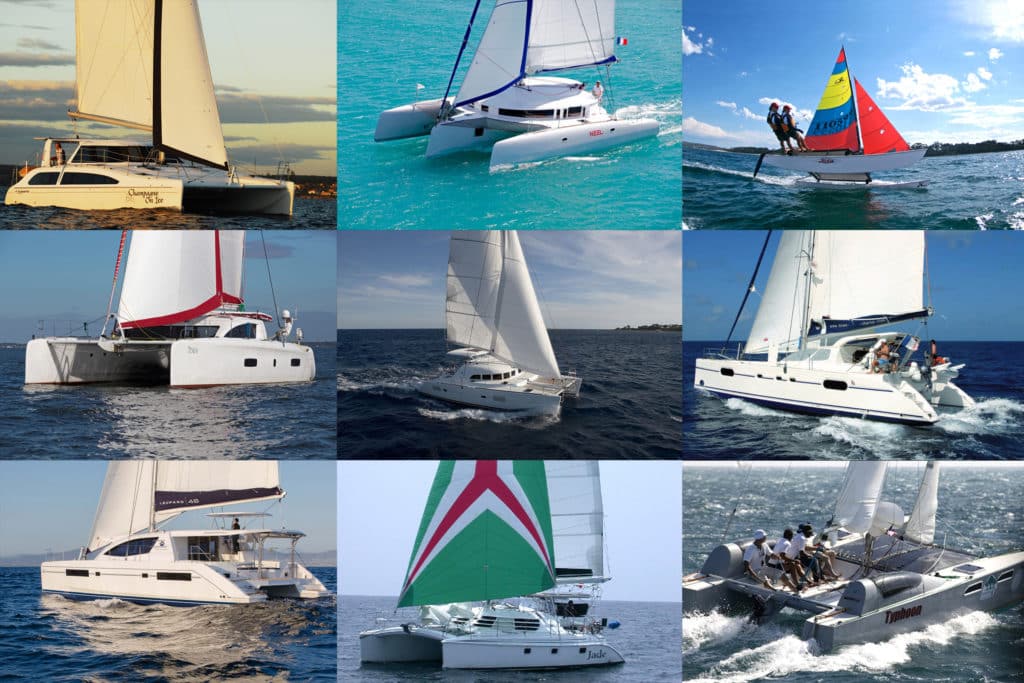
Cruising catamarans have been around for decades, but early models—often plywood and fiberglass vessels built by their owners from plans and kits, kept the boats on the fringes of mainstream sailing. That all changed, though, as big roomy cats were discovered by sailors who went off to charter in the Caribbean, where the multihulls proved their worth as comfortable liveaboard and party boats.
Today’s bluewater catamarans roam the globe, carrying families to exotic destinations across the Pacific and beyond. Just as with their monohull cousins, there is no best catamaran. Instead there is a wide variety of designs, ranging from small catamarans that offer the ease of maintenance a couple might enjoy to performance catamarans capable of easily knocking off 250-mile days. Today, the best catamaran brands offer a range of size models and layouts that can be optimized for an owner sailing with family and friends, or for the charter market, where there’s a demand for four, five and even six cabins worth of accommodations.
The most prolific catamaran manufacturers are in France and South Africa where yards include both large-run production builders and niche companies building fewer than 10 boats a year.
The best cruising catamarans offer good load-carrying ability and respectable performance. As with any sailboat , a modern catamaran’s design is a result of compromises. Daggerboards or keels? Galley up or galley down? Spacious owner’s cabin or extra bunks? There are lots of options to choose from—and that’s what makes looking at these sailboats fun!
Here, then is an eclectic A to Z list of some of the best catamarans that have helped shaped the evolution of how we live and sail on two hulls.
Antares 44i
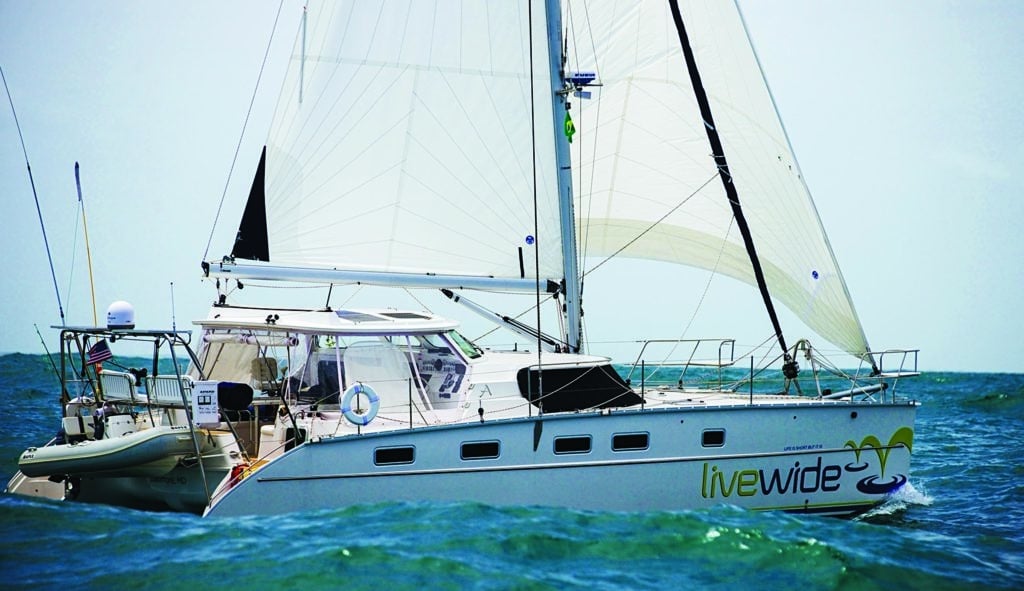
Now built in Argentina as a full-fledged, bluewater catamaran and cruiser that can be safely operated by a shorthanded couple or family crew, the Antares 44i features a fully covered cockpit with a quartet of big, standard solar panels recessed within the hardtop, one example of a yacht capable of long-range passagemaking.
Atlantic 42
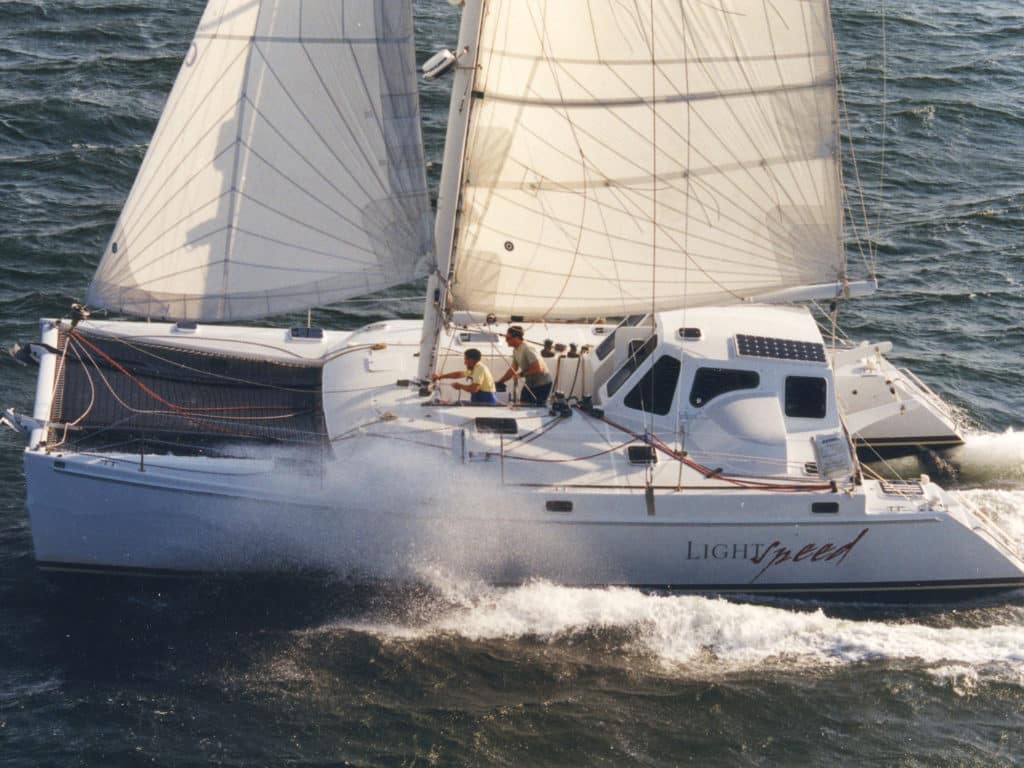
Almost 30 years ago, yacht designer Chris White revolutionized catamaran design with the first in his series of Atlantic cats, the primary feature of which was the innovative mid-ship sailing cockpit forward of the main cabin. The smallest in the Atlantic line, the 42 remains White’s most popular design ever.
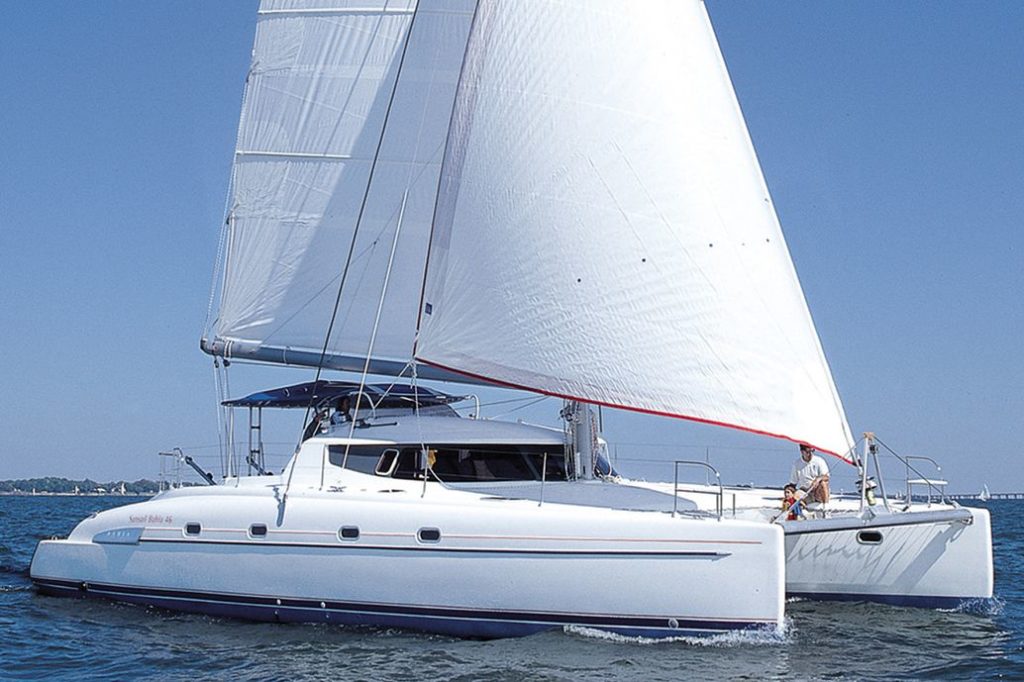
Fountaine-Pajot has built so many outstanding cruising catamarans that it’s difficult to narrow down any single boat, but we’ve always been fans of the good-looking, well-thought-out Bahia 46. At 46 feet, the boat is large enough for offshore forays and has plenty of volume; with its simple but powerful sail plan, it’s also an excellent performer.
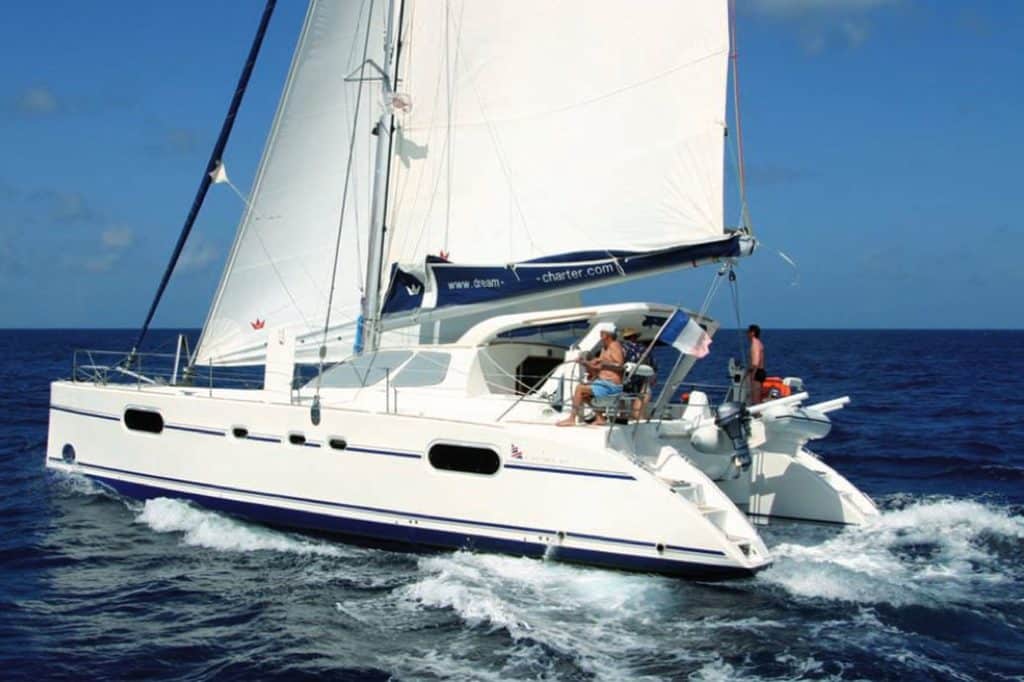
Beginning around 1996, the French builder Catana was one of the first companies to manufacture fully found cruising cats for private ownership, and this Christophe Barreau design, which enjoyed a nearly 10-year production run from 1997-2006, was emblematic of this first generation of safe, fun, long-legged offshore voyagers.
Click here to see more cats from Catana.
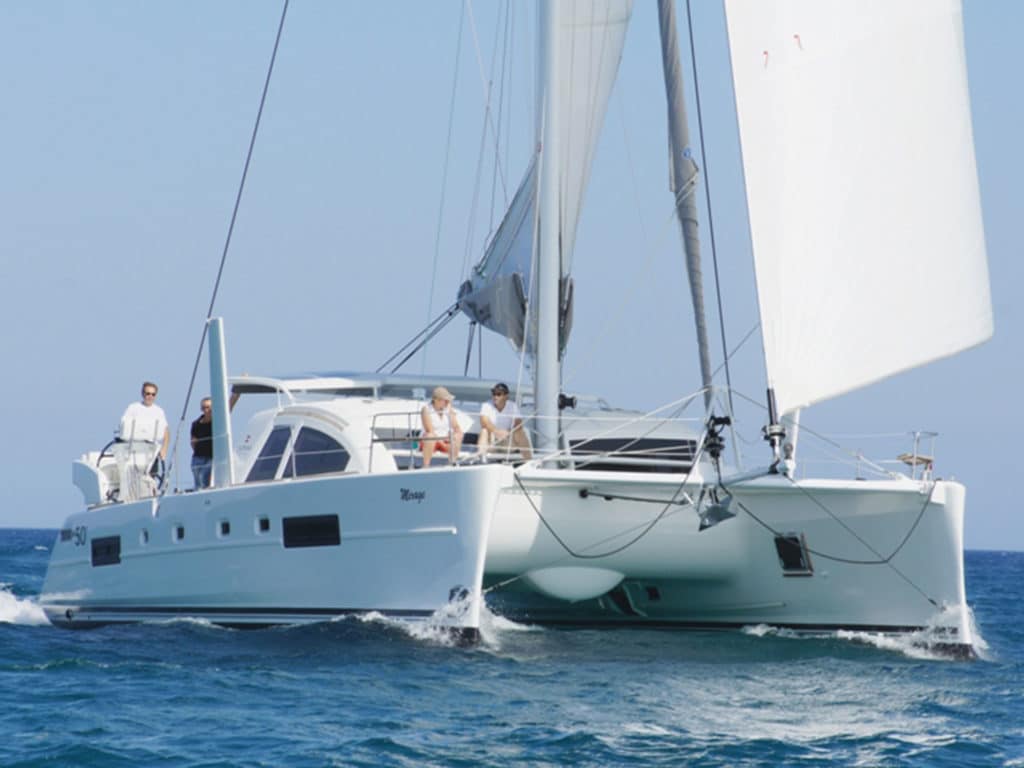
When it comes to speed, light boats are fast ones. And if you wish to save weight, that means exotic modern materials like carbon. Catana now infuses the laminates of their entire production line with carbon fiber, and for this list, we’ve chosen the Catana 50 Carbon, one of the zippiest cats now crossing oceans.
Click here to read about a couple’s charter aboard a Catana 50.
Gemini 105M
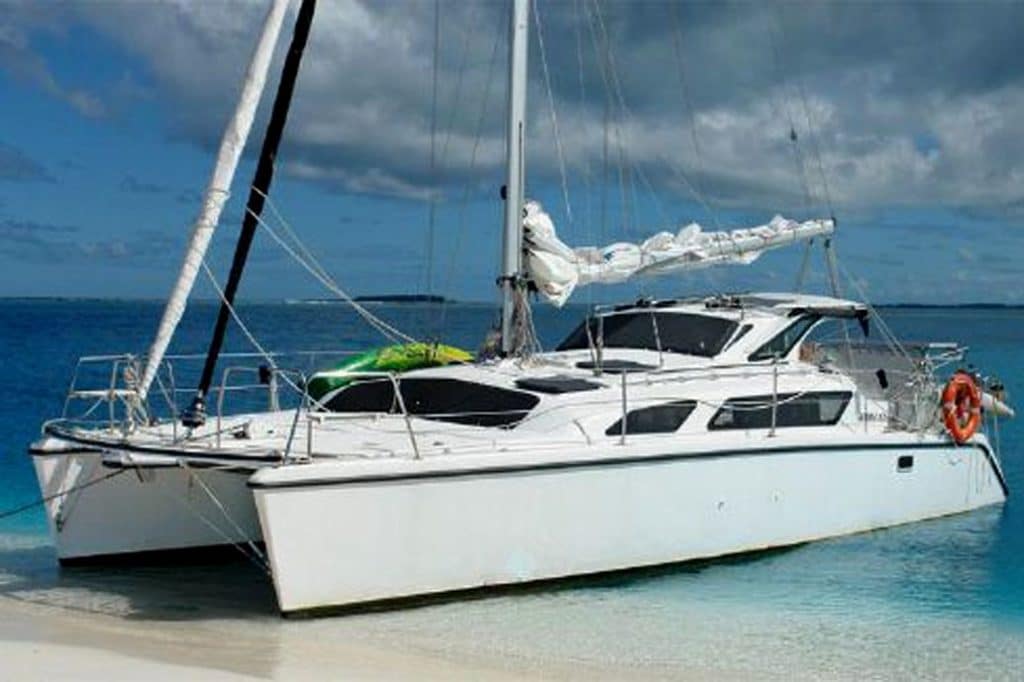
Pioneering catamaran sailor, builder and designer Tony Smith launched the first of his 33-foot Gemini 105M’s (10.5 meters = 33′) in 1993, and soon after found a ready and willing stream of sailors enamored of the boat’s compact size, affordable price tag, and such innovations as the nifty lifting rudder and transom steps.
Click here to read about the Gemini Legacy 35.
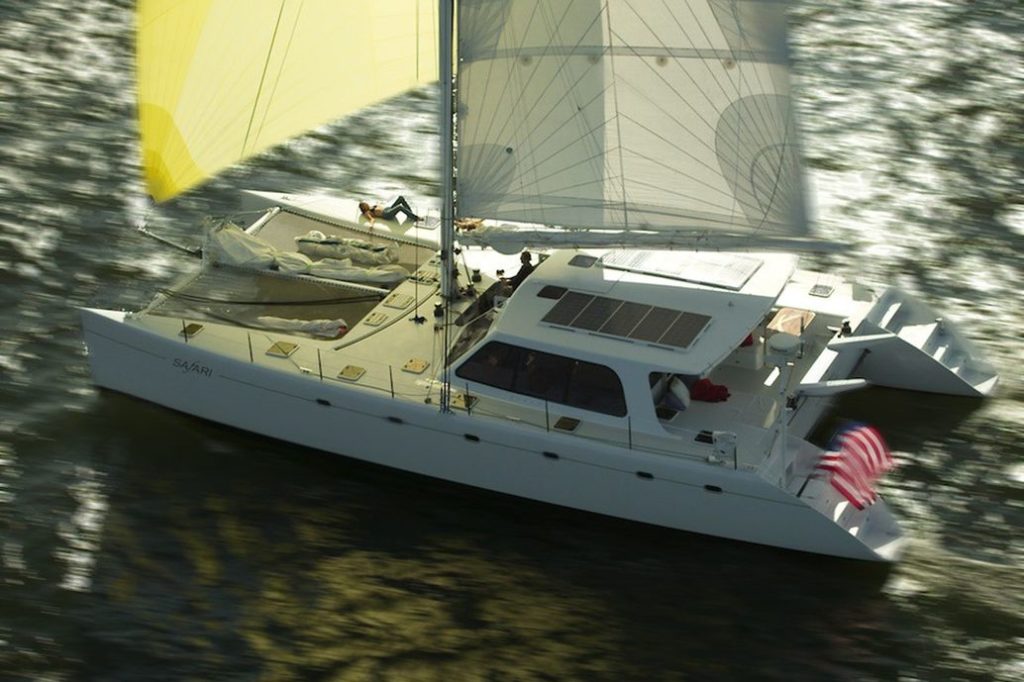
Built between 2000-2005, the Gunboat 62 firmly established the Gunboat brand: go-anywhere cats that applied race-boat technology to a world-cruising platform. Hull no. 1, Tribe, was built for company founder Peter Johnstone, who then spent a year-and-a-half cruising with his family, smiling all the way.
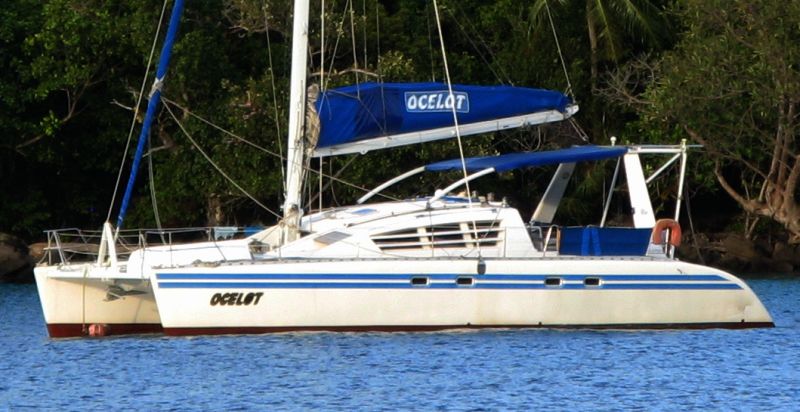
French builder Henri Wauquiez is best known for his long career building monohulls, but the Kronos 45 cat, which he launched in 1992, was ahead of her time. Classic lines, the aft “targa bar” over the cockpit, the louvered coach roof windows, even the distinctive stripes on her hull: the Kronos 45 remains timeless.
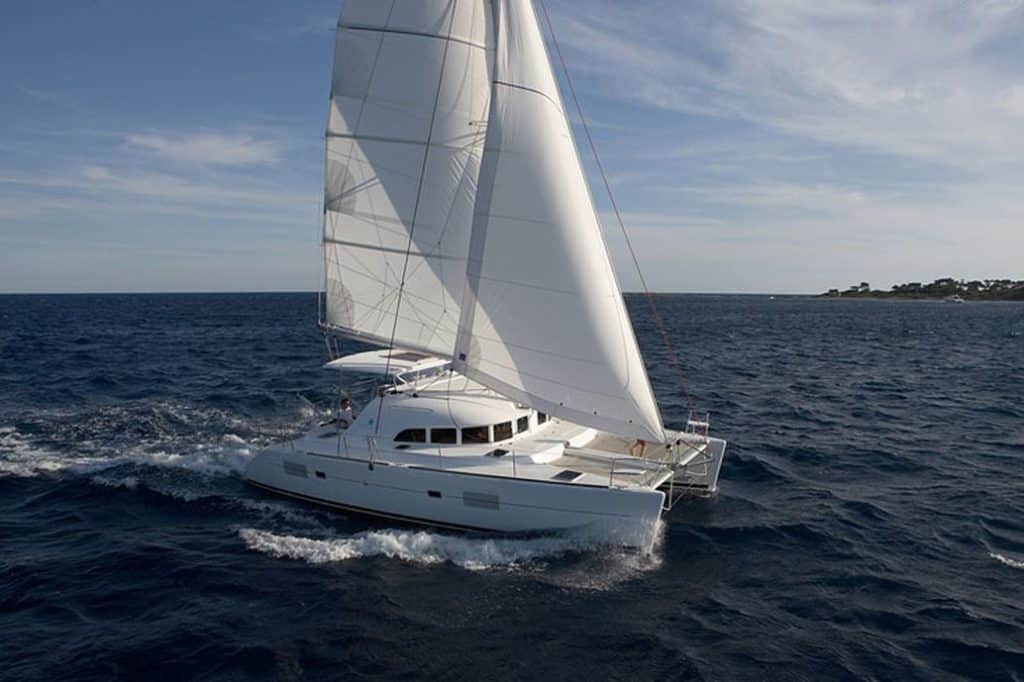
No roundup of cruising cats would be complete without several Lagoon entries, and the best of that impressive bunch might well be the Lagoon 380. Originally launched in 1999, and revered for its combination of quality, volume and performance, with over 740 boats built the 380 is still going strong.
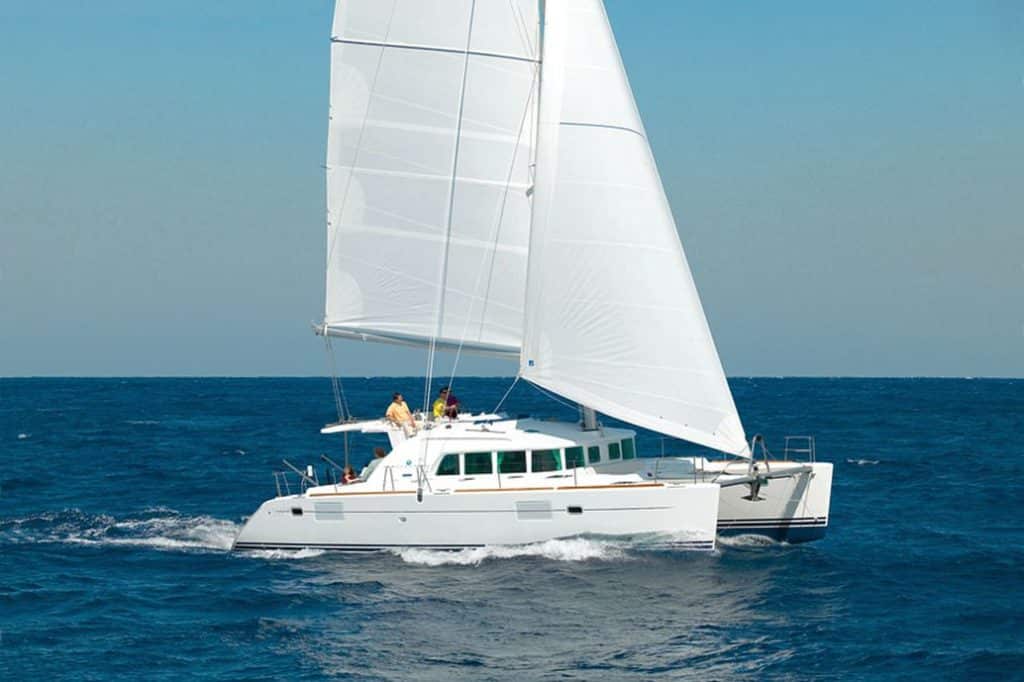
Launched five years after the breakthrough 380, the Lagoon 440 was an evolutionary design that featured a raised flybridge helm station, a unique “gullwing” configuration below the bridge deck, expanded windows in the hull and much more. With 400 boats built in a 6-year production run, the 440 was an unqualified success.
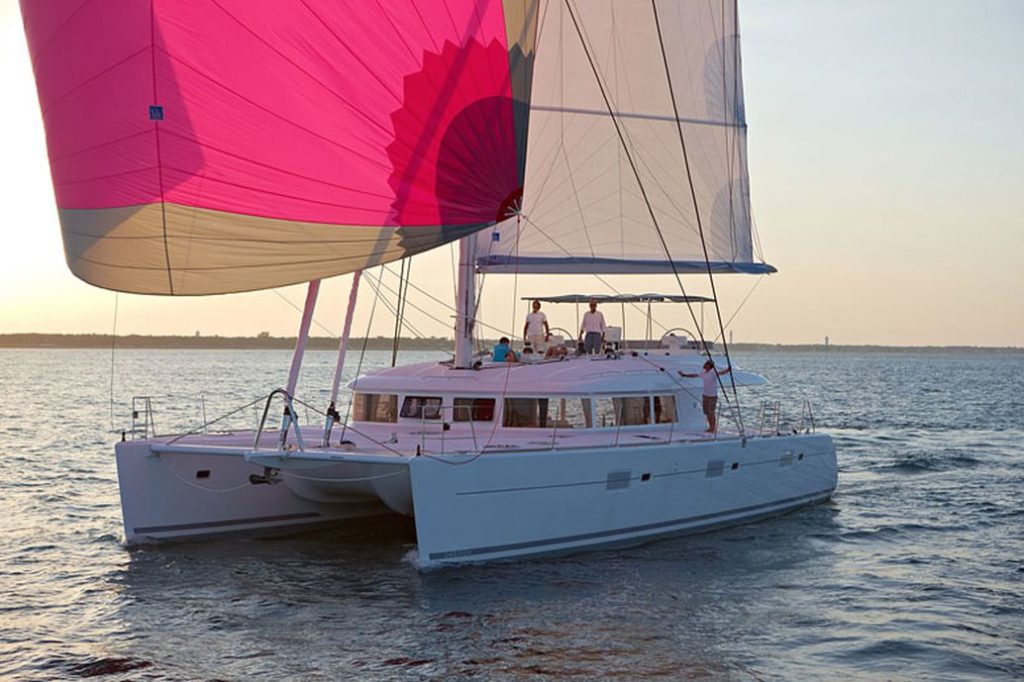
How big can a production cat, still operable by a short-handed crew, really be? The builders at Lagoon discovered that 62-feet hit a sweet spot in the marketplace, and have sold over 70 boats since its introduction in 2010. The centerpiece of this design is the sensational steering station atop the flybridge, with expansive views of the sea and sky.
Click here to see more cats from Lagoon.
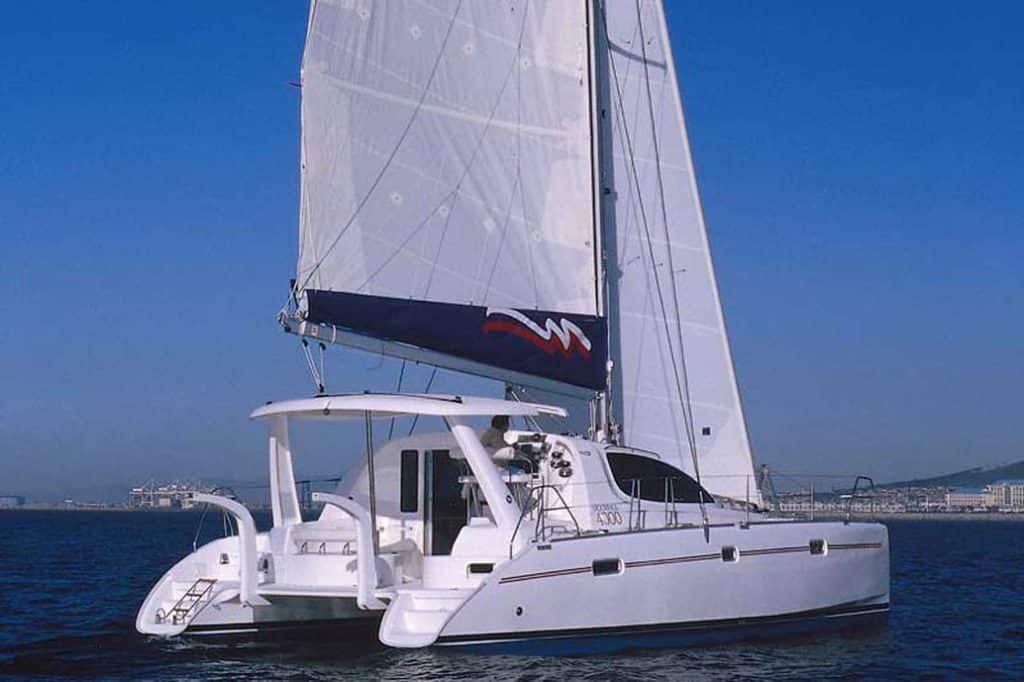
With an unmatched pedigree – designed by premier multihull naval architects Gino Morelli and Pete Melvin, built by the prestigious Robertson & Caine boatyard in South Africa, and commissioned by chartering giant The Moorings – the Leopard 40 was, perhaps unsurprisingly, Cruising World ’s Import Boat of the Year in 2005.
Louisiane 37
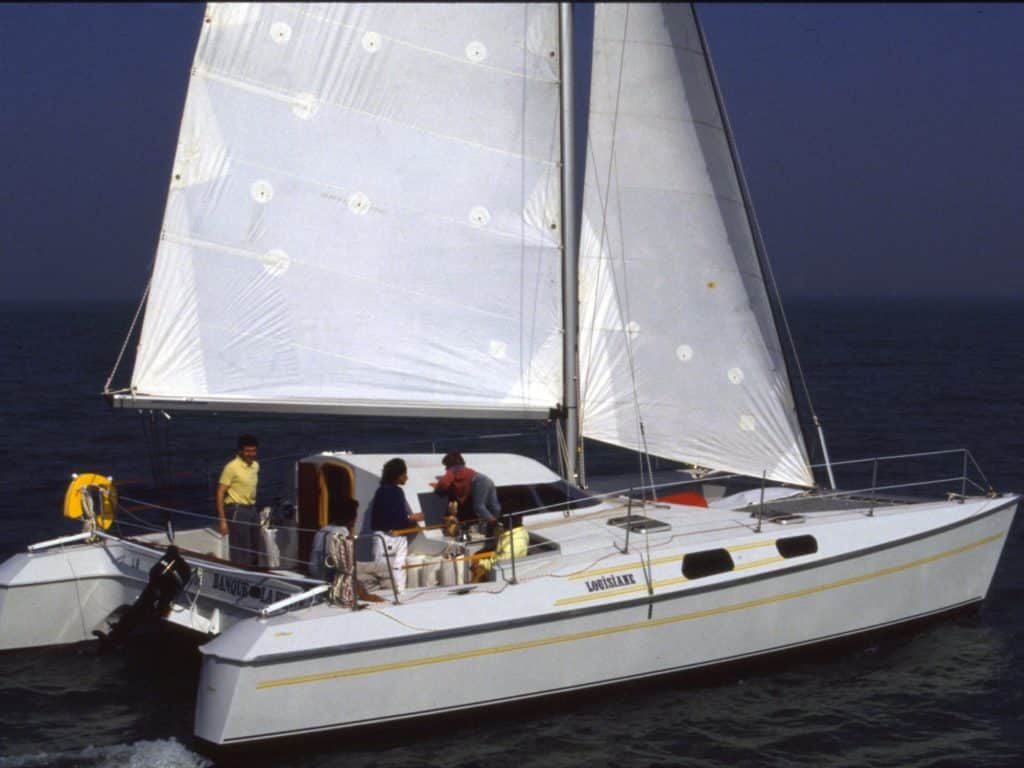
Based on the famous French racing cat Charente-Maritime, the Louisiane 37, designed by Joubert/Nivelt and launched by builder Fountaine-Pajot in 1983, was a light, fast liveaboard cruiser with full accommodations that represented a radical departure from the hefty British cats that preceded it.
Maine Cat 30
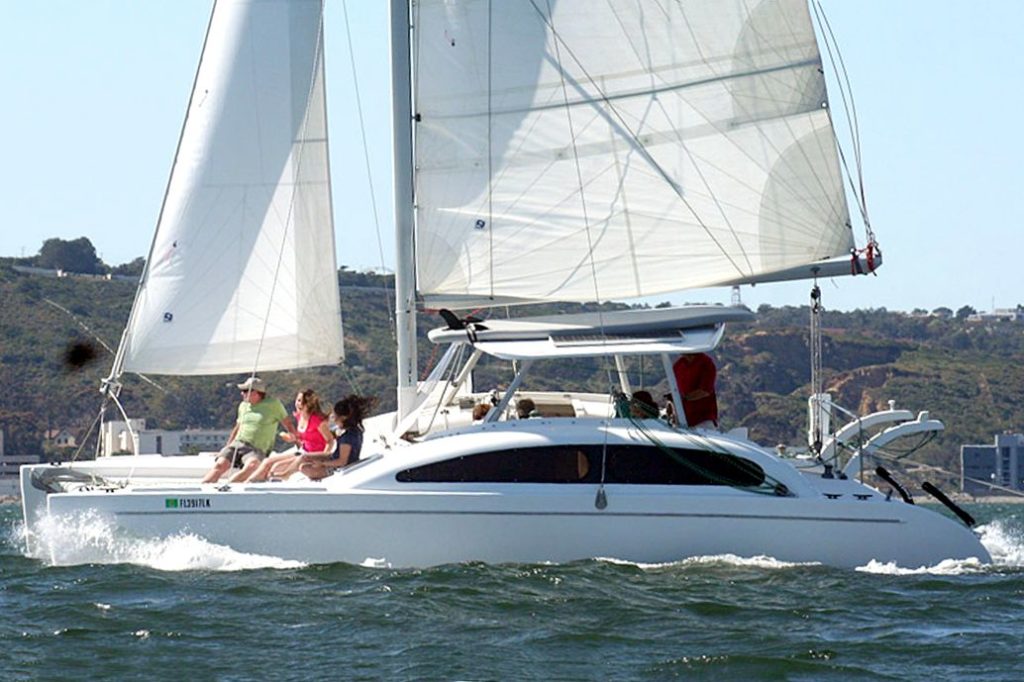
One of the more versatile and clever cats ever created, the central feature of the cool Maine Cat 30 is the open bridge deck/living room sandwiched between the hulls and canopied by a rigid, permanent hard top (the comfortable accommodations/ staterooms are stationed in the hulls). Ideal for a winter in the Bahamas but with the ability to sail offshore, it’s a boat for all seasons and reasons.
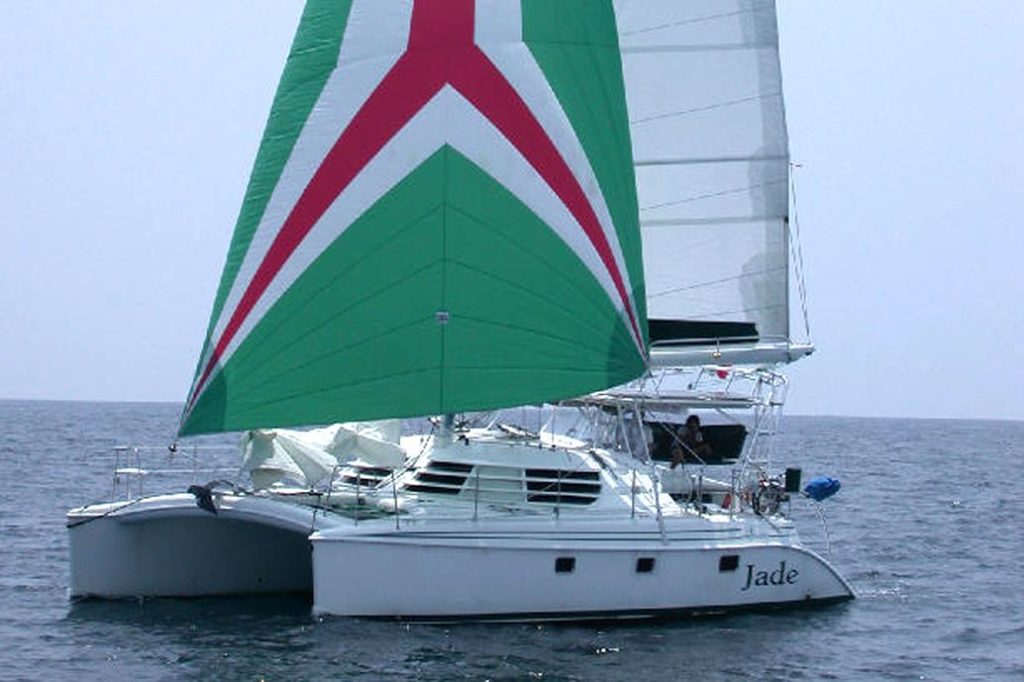
Built in Florida and beloved by the owners of the over 120 boats built during the company’s existence from 1993 to 2009, the Manta Catamarans range included 38-, 40- and 44-foot cats. For this exercise, however, we’re heralding the original Manta 42, which won the Best Value Overall prize in CW’s 2001 Boat of the Year contest.
Moorings 4800/Leopard 48
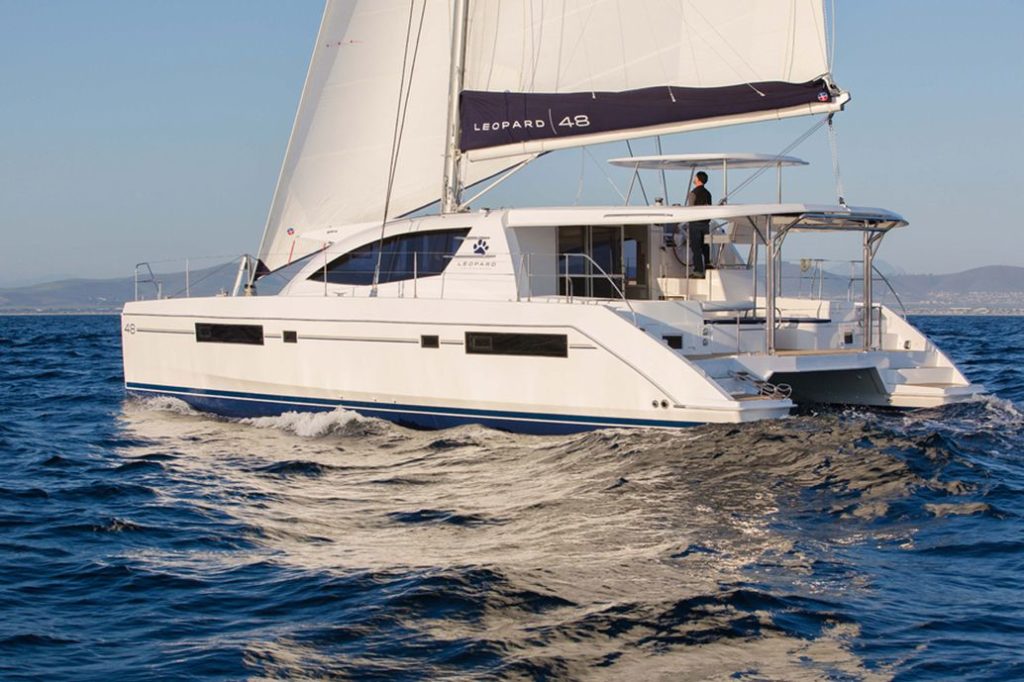
Another Leopard/Moorings collaboration built by the wizards at Robertson & Caine (though this boat was designed by fellow South African Alex Simonis), the Leopard 48 was another CW Boat of the Year winner with all the contemporary bells and whistles: forward cockpit, flybridge helm station and solid hardtop dodger, just to name a few.
Click here to read more about the Leopard 48, and click here to see more images.
Nautitech 441
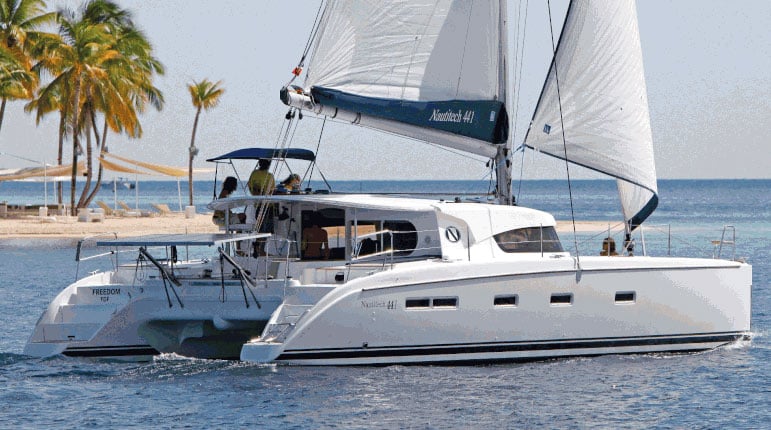
The Best Multihull Under 45 Feet: So said the CW judging panel in the 2013 Boat of the Year competition, regarding the Nautitech 441. But what makes this versatile platform so intriguing are the different helm set-ups. The 441 employs a single wheel, to starboard, ideal for solo sailors, while the 442 has a pair of helm stations aft.
Click here to see more Nautitech Catamarans.
Outremer 5X
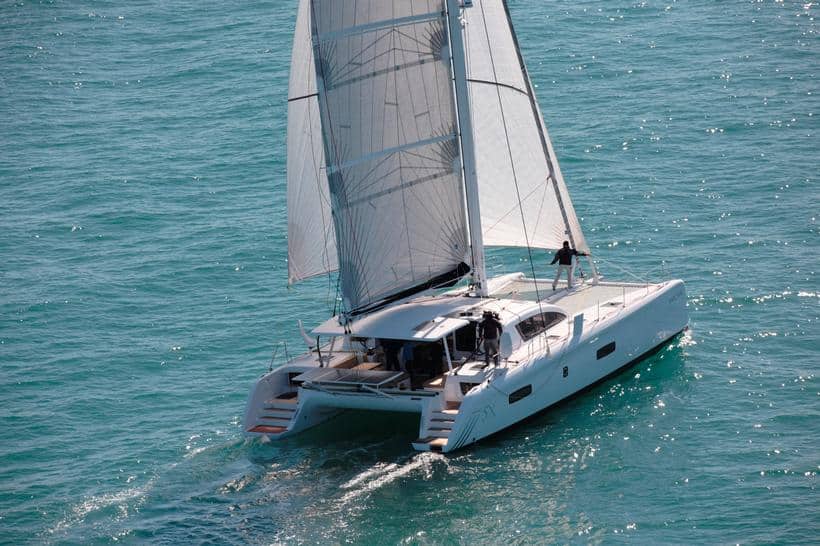
A state-of-the-art all-oceans cat that exemplifies how far multihull design has come, the 59-foot Outremer 5X was a winner on both sides of the Atlantic, taking top honors in the European Boat of the Year competition in 2013, and following up as the Best Full-Size Multihull in CW ’s contest a year later.
Click here to see more cats from Outremer.
St. Francis 50
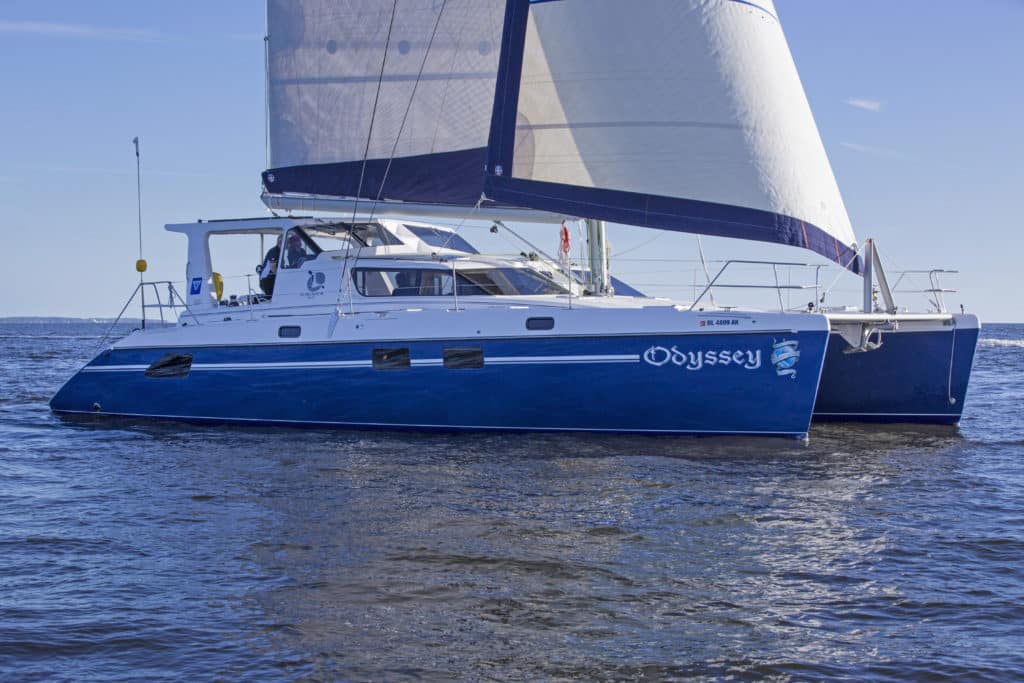
The flagship of the proud St. Francis line – built in South Africa since 1990 to designs by local legends Lavranos Marine Design – the St. Francis 50 is another “luxury cat” that shares much in common with an earlier 48-foot sister-ship, but packs even more payload into its roomier lines.
Click here to read more about the St. Francis 50
Seawind 1000
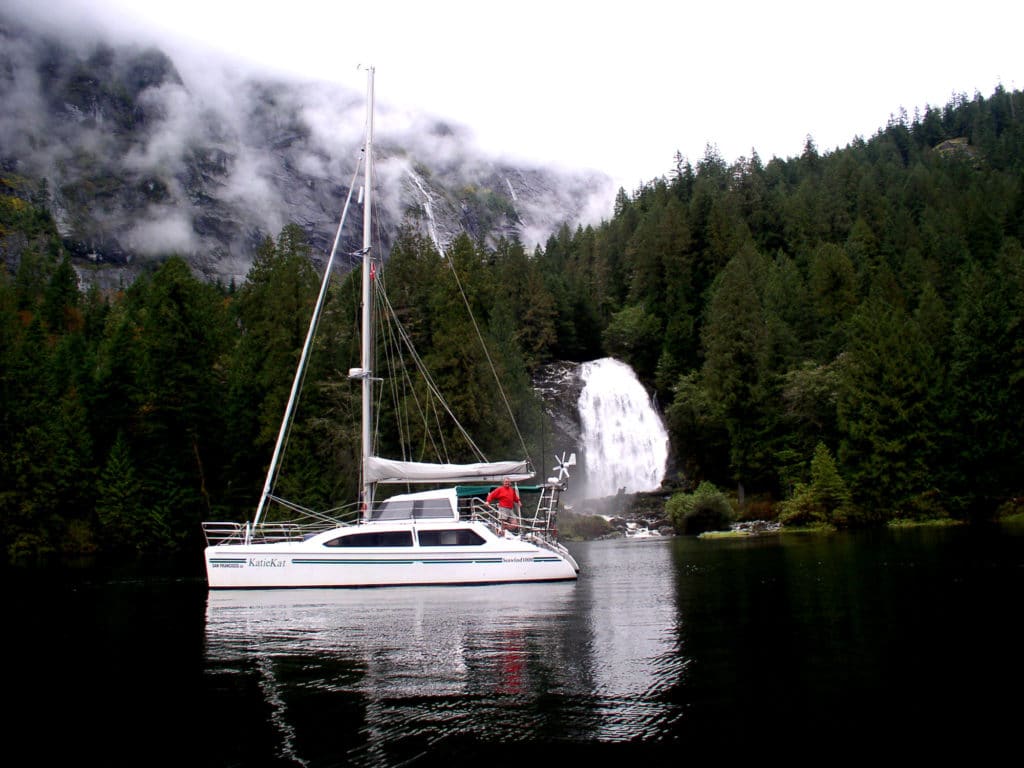
Founded by Aussie surfer and sailor Richard Ward in 1982, the 33-foot Seawind 1000 is easily the most popular cruising cat ever built in Australia (the company has since moved its manufacturing and management operations to Vietnam). Roomy and airy, these cats dot the coastline of eastern Oz.
Seawind 1160
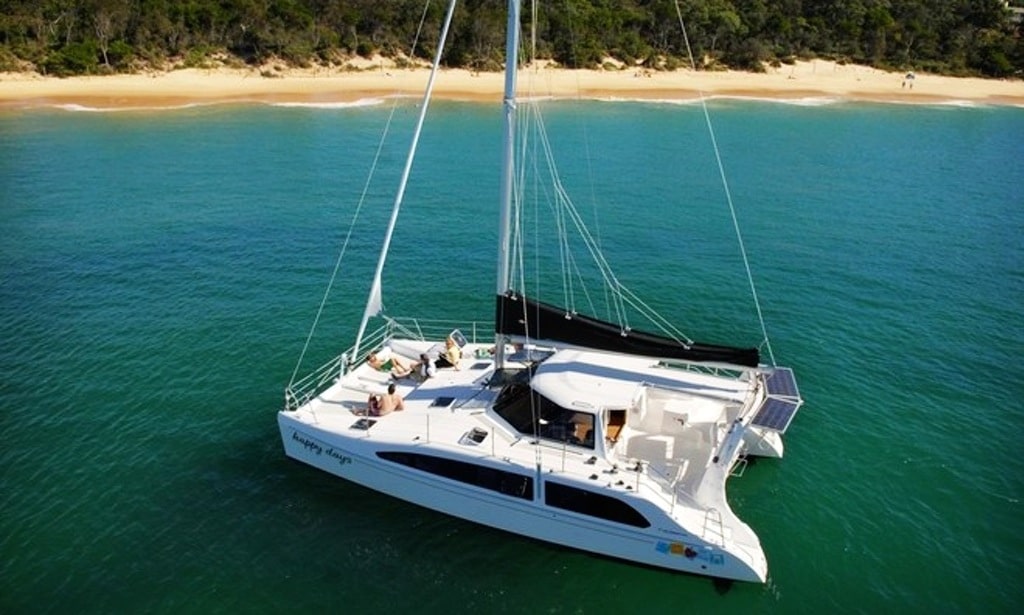
If the Seawind 1000 was a minimalist approach to cruising cats, the 38-foot Seawind 1160 is the flip side of the coin, a full-fledged long-range voyager. Among the reasons it was named CW ’s Most Innovative boat for 2007 is the unique “tri-folding” door that stashes overhead to open up the saloon and cockpit into a spacious living area.
Click here to read more about the Seawind 1160.
Sunsail 384
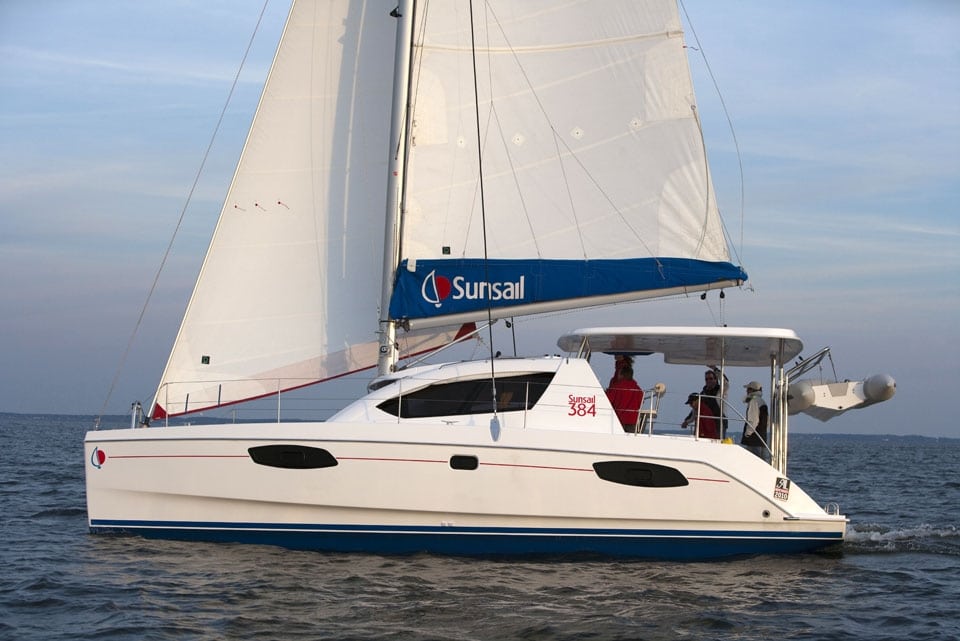
Every sailboat is a compromise, and in the case of the Sunsail 384 (also sold privately as the Leopard 38) that’s a good thing, because designers Morrelli & Melvin and builder Robertson and Caine got the balance just right with this relatively small catamaran. With four cabins, the 384 can carry the same size bareboat charter crowd as her larger siblings, but does so with a decided bounce in her step. Named CW’s Import Boat of the Year in 2010, you can gauge the success of the design by the grins on the crew as they barrel down Sir Francis Drake channel in the British Virgin Islands.
Victoria 67
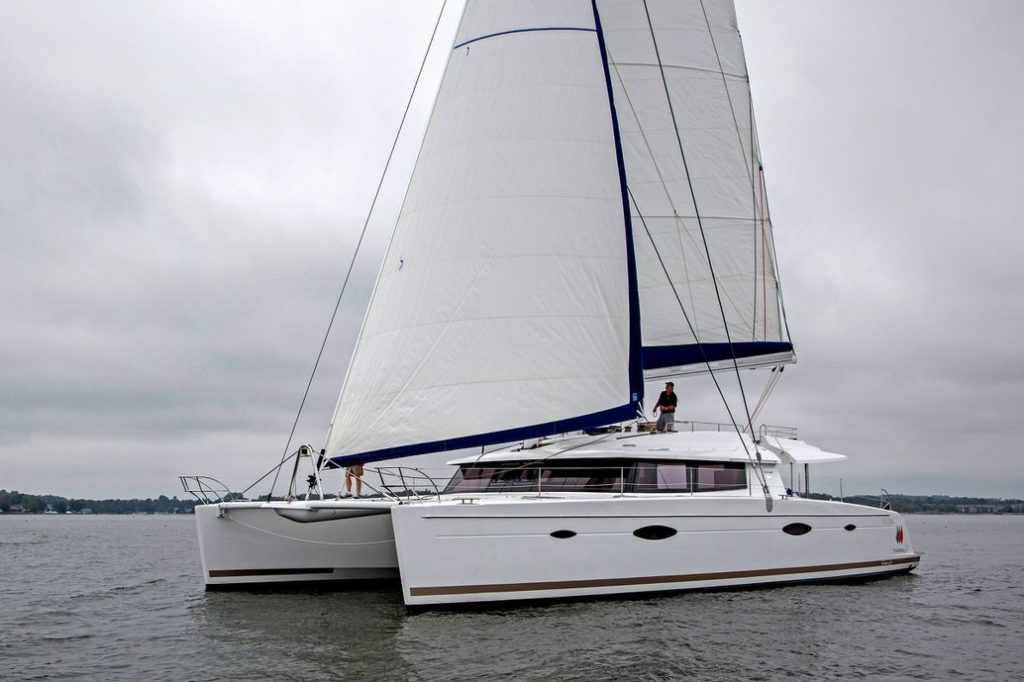
The French design office of Berret Racoupeau drafted the lines of Fountaine-Pajot’s new flagship, introduced in 2013, a magnificent world-girdling voyaging catamaran. Like other giant cats launched in recent years, the boat features a sensational upper deck with all sail controls, helm and lounging stations.
Click here to see more images of the Victoria 67.
Wharram Tanaroa
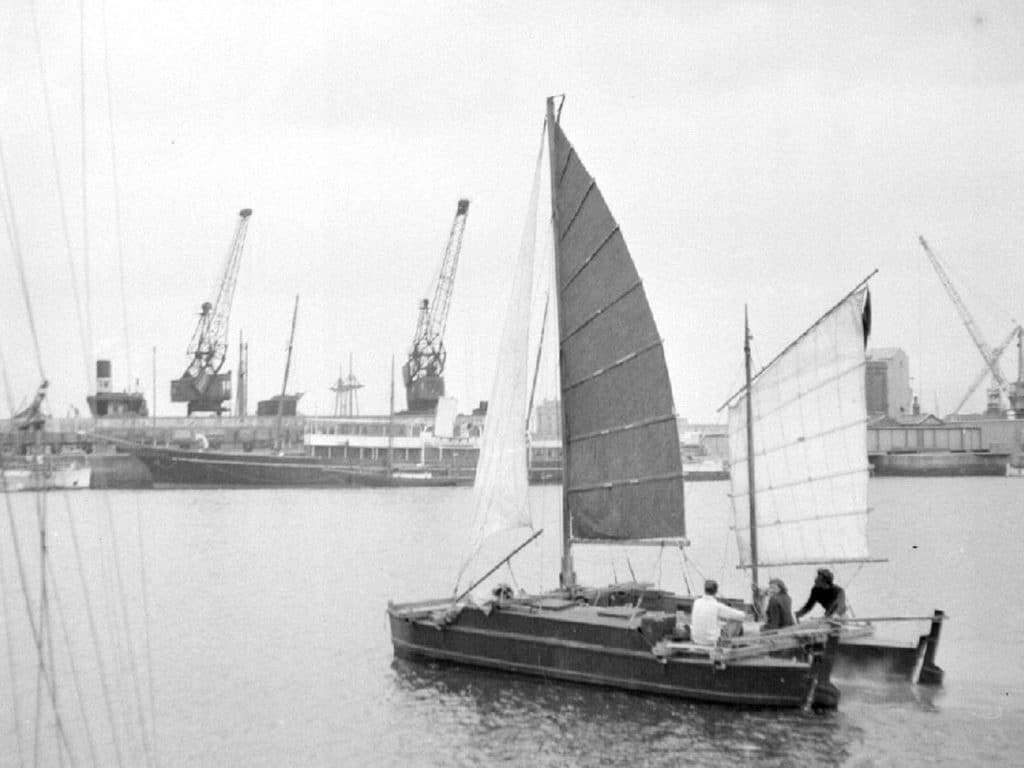
No list of influential multihulls would be complete without the work of James Wharram, and while Tangaroa wasn’t a production cat by any means, it showcases the British designer’s respect for ancient Polynesian craft. Wharram sailed this 23-foot-6-inch “double-hulled canoe” across the Atlantic in the 1950s, and sold countless plans for similar boats for decades afterwards.
- More: Boat Gallery , catamaran , multihull , Sailboat Reviews , Sailboats
- More Sailboats

Sailboat Review: Tartan 455

Meet the Bali 5.8

Celebrating a Classic

New to the Fleet: Italia Yachts 12.98

Bitter End Expands Watersports Program
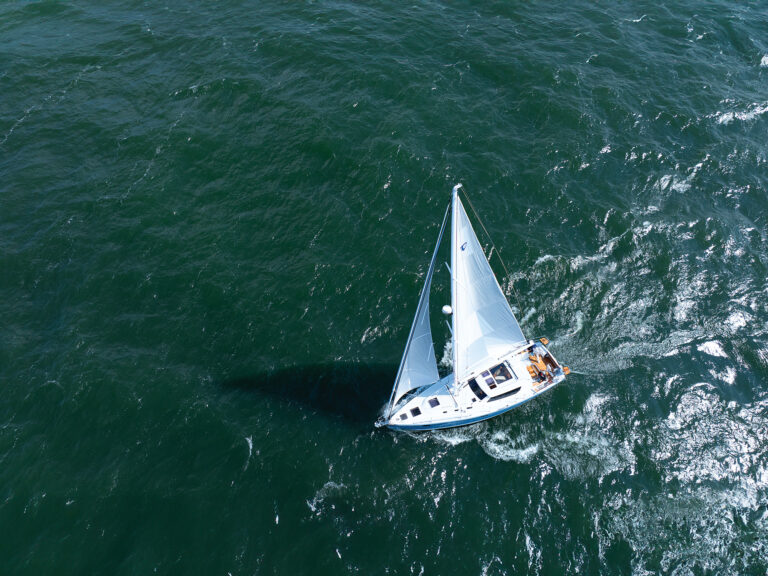
Miracle in a Bowl
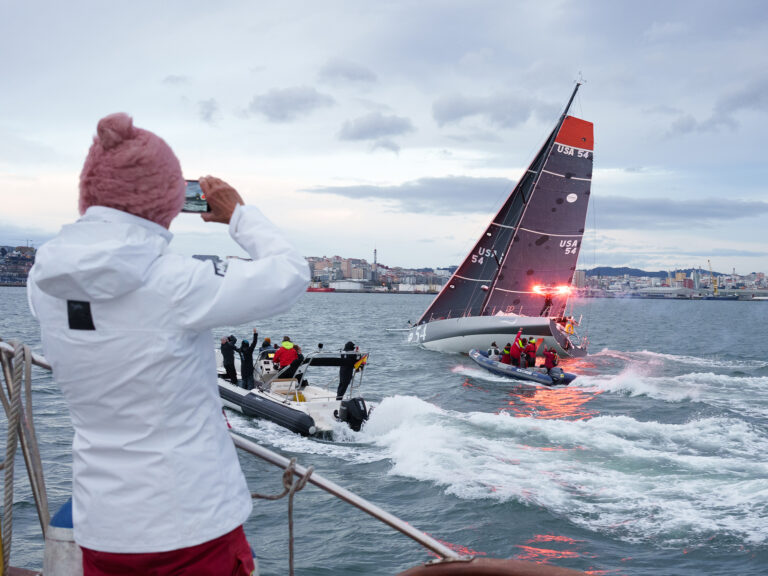
Cole Brauer Completes the Global Solo Challenge
- Digital Edition
- Customer Service
- Privacy Policy
- Email Newsletters
- Cruising World
- Sailing World
- Salt Water Sportsman
- Sport Fishing
- Wakeboarding

Sail Guide for Bluewater Cruiser Catamaran
Published by oceanwave on september 17, 2023.
Ever set sail on a catamaran, eyes on the endless horizon, only to wonder, “Which sails are best for my Bluewater Cruiser Catamaran?” That familiar quest for the perfect canvas to harness the wind guides many a sailor. In the vast ocean of sail options, finding your course can be daunting.
Discover ideal sails for your cruiser catamaran adventure—tailored for routes, performance, crew dynamics, and eco-conscious voyages.
How do sails align with different routes? What balances speed and comfort? Can sails echo our environmental ethos?
Expert insights and seasoned tips await. Learn to navigate the winds of choice effectively.
Unveil the sails that promise not just a sail but a symphony with the sea. Stay aboard for a voyage through sail selection’s depths.
1. Sails Selection for Cruising Catamarans
Sails are the lifeblood of any sailing vessel, dictating performance, comfort, and safety. When it comes to bluewater cruising on a catamaran, selecting the right sails is a decision of paramount importance. Each sail contributes to the overall sailing experience and should be chosen considering various factors that align with your cruising objectives. Let’s unravel the complexities of sail selection for cruiser catamaran.
Understanding Your Route Plan
Your route plan is the compass guiding your sail selection journey. Consider the wind patterns and the predominant sailing direction on your intended route. Tradewind routes, primarily downwind, call for a focus on downwind sails like spinnakers and Code sails optimized for reaching performance. Conversely, routes involving more upwind sailing necessitate a careful selection of headsails to tackle varying wind angles effectively.
The Performance Perspective
The choice of sails often reflects your sailing philosophy, particularly your attitude toward speed and comfort. Performance-oriented sailors, seeking the thrill of speed, gravitate towards asymmetric spinnakers and flat-cut sails ideal for reaching. These sails offer exhilarating downwind sailing experiences but often come at the cost of some comfort. On the other hand, those valuing comfort and ease of handling may opt for heavy-weather symmetric spinnakers that provide a balance between speed and stability.
Matching Sails to Crew Capability
Consider your crew’s sailing capabilities and size when selecting sails. Short-handed crews often find furling sails, like a furling asymmetric Code D, a convenient option for downwind sailing, simplifying sail handling. Alternatively, sails that can be easily reefed and adjusted by a smaller crew might be a more suitable choice for varying weather conditions.
Eco-Consciousness and Time Management
In an age of environmental awareness, considering your ecological impact is essential. Are you committed to minimizing engine use and embracing the wind’s power? Sails like the Code 0 can significantly boost boat speed, making them an eco-conscious choice. Additionally, evaluate your time constraints and whether you prioritize the journey or the destination. Sails that optimize speed might align with those seeking efficient, time-conscious voyages.
Preparing for Adverse Weather
Bluewater sailing necessitates preparedness for adverse weather conditions. All bluewater sail plans should include storm options – sails designed to withstand strong squalls and turbulent seas. Storm jibs, with the ability to hoist over furled foresails, and mainsails with multiple reef points are vital components to navigate through challenging weather.
Considering Your Crew’s Needs
It’s crucial to keep in mind the unique needs of your crew. If you plan to sail with family or young ones, comfort and safety might weigh heavier in your sail selection. Sails that are easier to handle and provide stability might be more appealing in such scenarios.
2. Reefing Techniques for Catamarans
Reefing, the process of reducing sail area to manage varying wind conditions, is a fundamental skill for any catamaran sailor. Unlike monohulls, catamarans convey their need for reefing in a subtler manner, making it crucial to grasp the art of reefing effectively. Let’s delve into the nuances of when and how to reef a catamaran to ensure a safe and balanced sailing experience.
Understanding When to Reef
Determining the right moment to reef your cruiser catamaran is a blend of art and science. While some bluewater cruisers adhere to the practice of reefing before nightfall as a precautionary measure, it’s not a universal rule. Reefing should be a straightforward maneuver, not an intimidating one in the dark.
Catamaran owners transitioning from monohull sailing often grapple with the subtle indicators of when their vessel is overpowered. The key principle is to find the optimal balance between sail area and achieving target speeds and angles while conserving equipment.
Sailing rarely adheres to rigid rules, favoring guidelines instead. However, having a starting point can be invaluable. Here are some general wind ranges to consider, with the more conservative side recommended for cautious sailors or when encountering larger sea states:
- Reef 1 in at 15-20 knots TWS (True Wind Speed)
- Reef 2 in at 20-25 knots TWS
- Reef 3 in at 25-30 knots TWS
It’s crucial to note that these wind values are based on true wind speed, not apparent wind speed. When sailing downwind, apparent wind speed tends to be lower, potentially leading to the temptation of flying more sail. However, if you need to turn upwind, the apparent wind speed can quickly escalate, emphasizing the importance of monitoring true wind speed.
Reliance solely on wind instruments is not foolproof, as they may malfunction. As a fallback, referring to the Beaufort Scale descriptions to gauge sea surface conditions can be a useful practice.
Recognizing Telltale Signs
Apart from wind measurements, catamarans offer subtle cues indicating the need for reefing. While catamarans don’t heel like monohulls, signs such as the windward hull slightly lifting or the bows diving down when sailing downwind can indicate the necessity for a reef.
Mastering the Art of Reefing
Reefing is a skill that improves with practice. The key is to make the process swift and efficient, ideally taking less than two minutes to complete. This is especially crucial when unexpected weather changes demand rapid adjustments.
For downwind reefing, particularly when tradewind sailing, consider the setup of downhaul lines from each reef tack point. These lines should run through the reefing point on the sail and through the corresponding points on each side of the mast. This arrangement ensures that the sail is pulled down in line with the track.
When reefing downwind frequently, watch out for chafe on the back of the mainsail and consider adding spreader patches for reinforcement. Centering the traveler during the maneuver can assist in the process, but vigilance is essential to prevent entanglements.
Additionally, practicing solo reefing is valuable, as it not only prepares for scenarios requiring single-handed reefing but also fosters a comprehensive understanding of the entire maneuver. Solo reefing ensures that reefing is executed swiftly and efficiently, as anyone on board can contribute to the process.
Determining When to Reef
In the realm of bluewater sailing, precision, and timing in reefing can make all the difference during challenging weather conditions. Sailors, relying on historical weather patterns and comprehensive sailboat reviews, adhere to a nuanced approach:
- Reef 1 in at 15-20 knots True Wind Speed (TWS) to maintain optimal speed without compromising safety or control.
- Reef 2 in at 20-25 knots TWS, a range carefully calculated to balance efficiency and stability.
- Reef 3 in at 25-30 knots TWS, a prudent decision to ensure the safety of the vessel and its crew without sacrificing progress.
Adopting a Cautious Approach
In the realm of bluewater sailing, embracing a cautious mindset is a hallmark of experienced mariners. Advanced sailors, attuned to subtle shifts in wind patterns and armed with extensive sailboat data , often err on the side of caution. Utilizing the lower end of the recommended wind range for reefing provides a cushion, enabling quicker and more controlled responses to escalating weather conditions.
3. Closing the ‘Experience Gap’ for Couples
The ‘experience gap’ is a common challenge for couples venturing into bluewater sailing . Advanced yachtsmen often recommend immersive sailing courses tailored for couples, focusing on advanced seamanship and communication skills. Additionally, collaborative roles in sail trim, navigation, and onboard safety drills can significantly bridge this gap, fostering a symbiotic sailing experience.
Here’s how couples can bridge this gap:
1. Rotate Roles : Alternate daily responsibilities like docking, navigation, safety checks, and operating equipment. This ensures both partners are proficient in essential tasks.
2. Divide Responsibilities : Divide the boat, each maintaining one hull and sharing the saloon. This promotes a comprehensive understanding of the vessel’s workings.
3. Incorporate Coaching : Opt for a professional coach during initial crossings. This structured learning environment allows the less experienced partner to build confidence and take charge safely.
4. Solo Sailing : Occasionally sail without your partner. Practicing leadership individually instills confidence and helps develop a unique style and voice on board.
Approaching bluewater cruiser catamaran as a team exercise from the outset ensures a balanced skill set and enhances safety and pleasure during the sailing journey.
4. Production vs. Performance Cruising Catamarans
Choosing between a production and a performance cruising catamaran is a pivotal decision, balancing comfort with sailing capabilities.
Production Catamarans
Production cruiser catamaran prioritize comfort, offering more creature comforts, living space, berths, and bathrooms. However, they may lack the agility and speed of performance catamarans. They are suited for those seeking a comfortable cruising experience, especially for extended stays docked at a marina.
Performance Catamarans
Performance catamarans emphasize speed and agility, often at the cost of some comfort. They feature narrower hulls and a sparse design, allowing them to outrun adverse weather conditions. However, the advantages of speed diminish if overloaded with personal gear and extras, offsetting their inherent lightweight design.
Key Considerations
- Skill Level : Consider your sailing expertise. Performance catamarans require skills to fully harness their speed potential.
- Intended Usage : Assess your sailing plans. If extensive world cruising is on the agenda, a balance between comfort and speed may be optimal.
- Safety and Speed : Evaluate the need for speed in challenging weather. Performance catamarans excel in this aspect, ensuring safety during adverse conditions.
Understanding the trade-offs between comfort and speed is essential in making the right choice. The decision should align with your sailing skills, intended usage, and the importance of safety and speed in your cruising adventures.
5. Handling Heavy Weather in a Catamaran
Dealing with heavy weather in a cruiser catamaran demands strategic planning and adept seamanship. Here’s a guide on navigating challenging conditions:
1. Weather Strategy : Prioritize avoidance by studying global weather patterns, using satellite connections for accurate forecasts, and leveraging boat speed to position away from predicted storm paths. However, avoid complacency as weather systems grow more extreme and unpredictable.
2. Scenario Planning : Develop contingency plans tailored to your boat type, eliminating last-minute preparations when storms approach.
3. Sail Prudently : Avoid 90° wind and waves, opting for a weather-forward or aft beam sail position for stability. Monitor heel angle and reduce sail area if it exceeds a safe limit, beginning with the main sail.
4. Reefing Techniques : Master the skill of reefing downwind swiftly and efficiently in case of unexpected worsening weather.
5. Speed Management : If unable to sail faster than waves, employ trailing warps to control speed, minimizing erratic surfing and maintaining bow stability. Warps are preferred over drogues for their familiarity and ease of use.
6. Handling Waves Breaking Over Stern : Consider turning into the seaway to maintain stability. In performance catamarans, adjust daggerboards; in production cats without daggerboards, using the leeward engine may help keep the bow into the wind.
7. Choosing Safe Routes : Always opt for sea room downwind, avoiding lee shores at all costs for a safer sailing experience during heavy weather.
6. Sail Selection for a Perfect Catamaran Cruise
Choosing the right sails for your cruiser catamaran is a critical decision that deeply influences your sailing experience. Here are the core aspects to consider when selecting sails:
1. Route Planning and Wind Patterns : Tailor your sail selection based on your planned route. Downwind-heavy routes require a focus on downwind sails, while routes involving upwind sailing demand suitable headsails. Aligning sails with your route optimizes performance.
2. Performance vs. Comfort : Determine your preference for performance versus comfort. Performance-oriented sailors may favor asymmetric spinnakers and lightweight sails for speed, while those valuing comfort may opt for heavy-weather symmetric spinnakers, prioritizing ease of handling.
3. Crew Capabilities : Consider the abilities of your crew. Short-handed crews benefit from furling sails for easier sail changes and efficient downwind sailing. Align sail choices with crew capabilities to enhance comfort and safety during the cruise.
4. Environmental Awareness and Time Management : For eco-conscious sailors aiming to minimize engine usage, sails that boost boat speed, like Code 0, are essential. Additionally, assess your focus on the journey versus the destination to select sails that align with your cruising ethos, optimizing speed and efficiency.
Bluewater cruiser catamaran represents the epitome of advanced engineering, superior sail handling, and the fulfillment of the seafaring spirit. Armed with insights from sailboat data , advanced sail handling techniques, and a keen understanding of vessel dynamics, you are well-equipped to navigate the open oceans and realize your yachting dreams. The blue beckons, and with the right knowledge and a capable bluewater catamaran, you’re ready to embrace the expanse and set sail for horizons anew. Happy cruising!
You may discover comprehensive details on different sailboat models and their performance here, making it easy for you to pick the best boat for your requirements with Ocean Wave Sail !
Related Posts
OceanWaveSail updates
6 ways and resources of boat tracking.
Sailing is a thrilling activity since it gives one a sense of freedom and adventure. The open water beckons with its promise of exploration and discovery, whether you’re taking a coastal cruise or setting out Read more…


How to Buy the Best Beginner Sailboat?
Sailing is an alluring activity because it offers the possibility of independence on the broad sea and the rush that comes from using the wind. You’re in for a gratifying experience if you’ve made the Read more…

Navigational Charts – How to read them?
The unsung heroes of every sailor’s voyage are their navigational charts. These painstakingly drawn waterway maps serve as the foundation for safe and effective sailing. Learning to read navigational charts is essential whether you’re cruising Read more…
Subscribe to our newsletter
Don’t miss new updates on your email.
© OceanWave Sail. All Rights Reserved 2022
Terms & Conditions – Privacy Policy – Cookie Policy
About Us – Privacy Policy
- New account
Forgot your password?
Lost your password? Please enter your email address. You will receive mail with link to set new password.
Back to login
Privacy Overview

Catamaran cruising: everything you really need to know
Republished from Yachting World Expert skipper Nikki Henderson reveals what you really need to know before going bluewater catamaran cruising
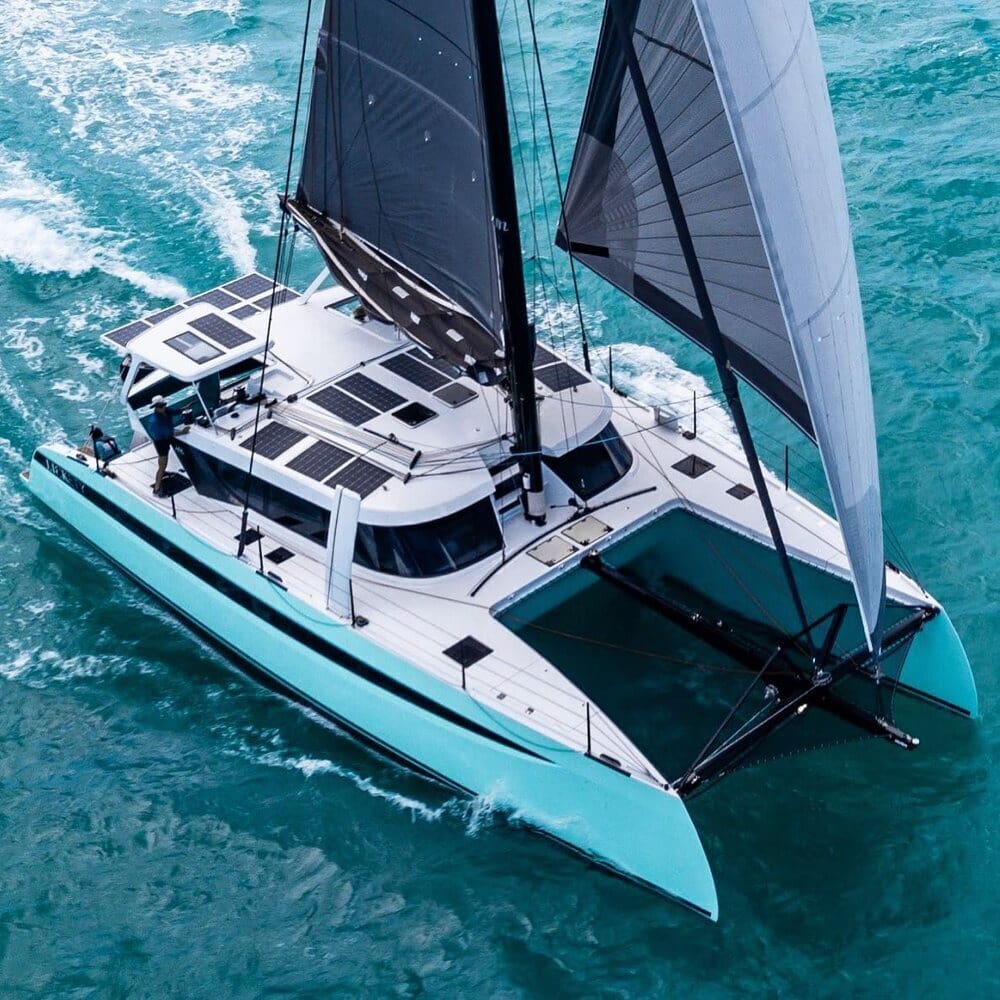
It has become routine now for me to bookend the summer sailing season with a trip to the south of France for the biannual ‘Outremer Week’. This hugely popular event gathers 100-plus new Outremer catamaran owners for five days of training, both in the classroom and on the water, and three days of friendly racing. The goal is to educate future owners so they are as prepared as they possibly can be for their upcoming bluewater catamaran cruising plans.
It’s an intensive week of 12-hour days, with a lot of information to absorb. Unsurprisingly there are some discussions specific to bluewater catamaran cruising that come up repeatedly, and they apply to owners or prospective owners of all brands of a bluewater multihull. Here are some of the most common questions people ask me:
What sails should I buy for a cruising catamaran?
Every day after sailing a new catamaran owner will come up to me and say, “Nikki, I’d love to take up some of your time and rack your brains about sail selection .” To pitch my advice appropriately, I always ask some key questions about your catamaran cruising plans, and I’d encourage you to ask yourself the same.
What is your route plan?
Tradewind sailing will be predominantly downwind. So, focus your attention on downwind sails. A route involving more upwind requires more focus on headsails. Routes involving more upwind tend to be more coastal routes or schedules with strict timings that will reduce the option to wait for downwind weather windows. All bluewater sail plans will need storm options. Three reef points in the main is a must, or at the very least an extremely generous second reef. A storm headsail is another key component. Ideally, it should be possible to hoist the storm jib up over the top of your furled foresail. In very big conditions, reliance on the thin furling line gets quite nerve-racking.
How performance-orientated are you?
Performance catamarans are designed to sail angles downwind, ideally with an asymmetric spinnaker wardrobe. However, there is a cost to the incredible speeds that you can attain reaching on these boats: comfort. So, a key question is what is your attitude to speed versus comfort? Performance-focused sailors are typically racing sailors, sailors without kids, or sailors who are in good physical shape. If you fit this category, then I’d advise purchasing one heavy-weather flat-cut asymmetric sail that can withstand a squall up to 40 knots, and a rounder, lightweight sail that you can sail quite deeply in light to moderate conditions.
If you don’t have a taste or attention span for speed, then one heavy weather symmetric spinnaker (approximately up to 40 knots TWS) should be enough. This will allow you to sail a rhumbline course, and make night-time take-downs less of a worry because the kite will survive a squall. For upwind, if you will enjoy fine-tuning your boat to get that extra half a knot, your ideal option is a large genoa for drive in light to moderate conditions, and a small flat blade-shaped jib for heavier conditions – small enough that it does not need to be furled to an inch of its life to cope with a Force 6. If an inner forestay is an option, the latter could be a staysail which will keep the centre of effort low and reduce sideways drift. For anyone less performance orientated in their catamaran cruising, the key for upwind sailing is a strong, flat jib that is not too big. Mark three reef points on the foot with sail tape. Keep an eye on how much it stretches and don’t be surprised if you need to change it every few years to avoid losing 5-10° of height. Downwind the trade wind route logic applies: performance sailors should invest in asymmetric and non-performance sailors in symmetric spinnakers.
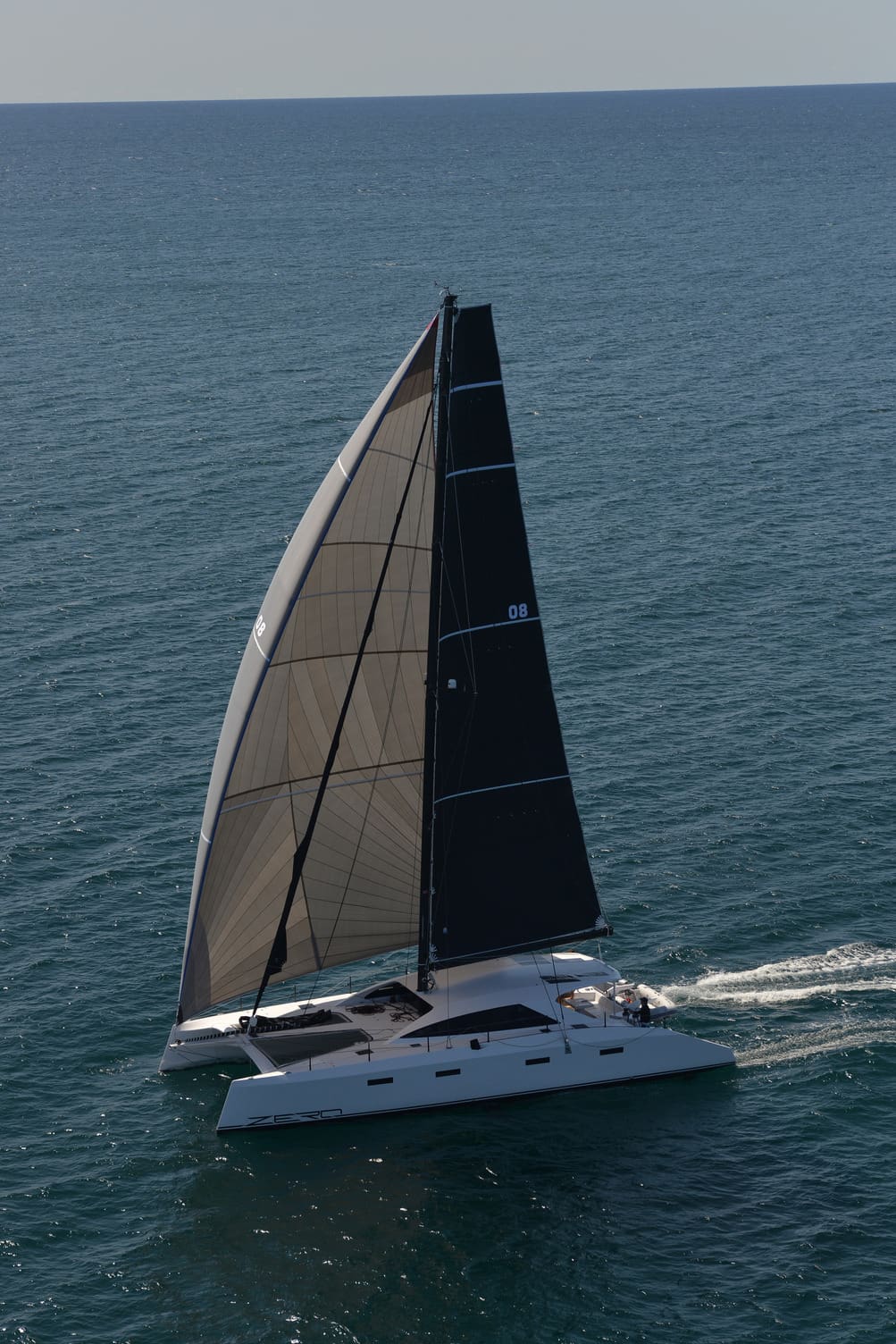
Who’s the crew?
At this point, the conversation often goes full circle. Sailors get enthusiastic about performance, and then remember that the kids will need home schooling, or that this is a retirement plan with potential health and fitness considerations. Most sail changes will require more than one person, and conditions at the bow can be bouncy. The crew also have to be able to sleep, cook, and live on the boat while it is thrown about. If you are short-handed, you could compromise for downwind sailing by choosing furling sails. A furling asymmetric such as a Code D can replace the ‘hoist and drop’ asymmetric. Or you can make the sock line on a symmetric long enough to route back to an electric winch. Upwind sailors could compromise by returning to a single jib and consider altering routing to sail slightly off the wind but faster; optimising for VMG. If you have a staysail, ensure it could be furled and therefore left rigged at sea – though make time to speak to the yacht designer about the impact on stability that having two heavy furled sails up continuously could have on the boat.
How ‘eco’ and time-conscious will you be?
Do you care about motoring? Increasingly for many of us, awareness of climate change is a strong motivator to avoid using the engine. And will you be more focused on the destination or more interested in the journey? If you are keen to avoid motoring, and you are free of time constraints such as fixed crew changeovers or grumpy children who need to stop and swim, then I’d recommend you invest in a Code 0. A Code 0 can double or even triple the boat speed: in 6 knots of wind, an Outremer will sail at 2-3 knots with a jib, but 5-6 knots with a Code 0. It’s a great sail and worth the investment, but first work out if you will use it. They often have low wind limits – around 15 AWS – which upwind could be 10 knots TWS.
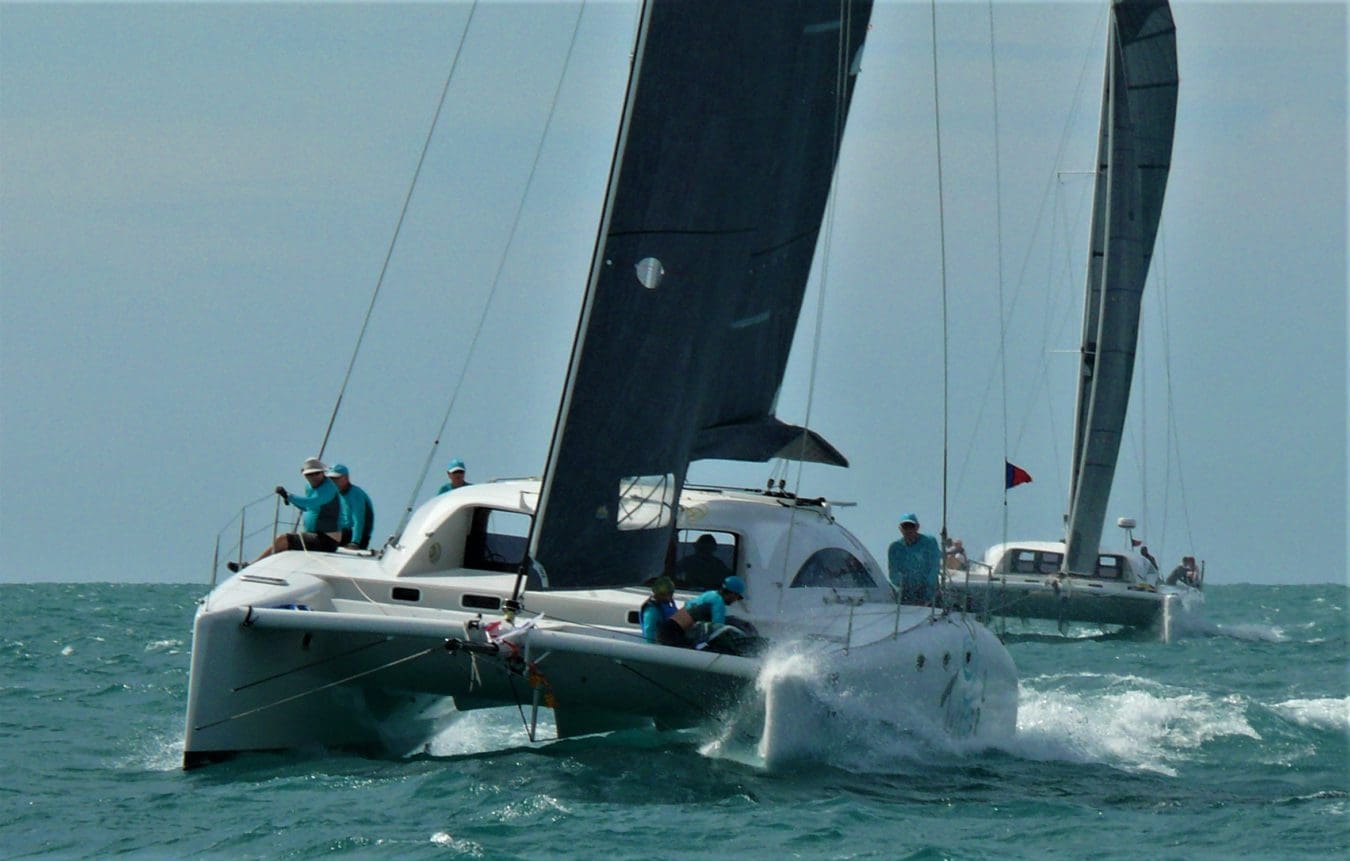
When do you reef a catamaran?
Many bluewater cruisers will reef down before dark every night. I’m not a huge fan of this as a rule; reefing should be straightforward enough to not be an intimidating manoeuvre in the dark. But all new catamaran owners who are planning to go bluewater cruising are concerned about knowing when to reef, especially if they come from monohull sailing, as a catamaran communicates whether it is overpowered or not in a much more subtle way. You want to conserve your equipment while sailing the boat effectively. So aim for the least amount of sail necessary to achieve your target speeds and angles. The best way to get to know this is to put reefs earlier or later each time and take note of whether it was beneficial or not. Over time you will know your boat very well.
Sailing favours guidelines over hard rules, but it’s good to have a starting point so here are some general ranges. For more cautious sailors or bigger sea states, use the more conservative side of the wind range: -Reef 1 in at 15-20 knots TWS -Reef 2 in at 20-25 knots TWS -Reef 3 in at 25-30 knots TWS Note that I am using true wind and not apparent. When sailing downwind it’s tempting to fly more sail because the apparent wind is so low. However, if you need to turn upwind – perhaps to reef – the 12 knots AWS in 20 knots TWS will quickly become closer to 25 knots AWS.
Reliance on numbers is great until the wind instruments stop working (it will happen at some point). Remember your RYA Competent Crew course and use the descriptions of the sea surface at various Beaufort Scale forces to identify how windy it is.
There are other telltale signs that the boat gives if she needs a reef. Although hulls don’t fly unless you are at the performance level of a Gunboat or similar, you may feel the windward hull just slightly lifting. This is a sign that a reef might be needed. Another is if the bows are diving down when you are sailing downwind. Heel angle can be most obviously sensed while lying down.
The main hindrance to learning when to reef – and when not – is a hesitation to perform the manoeuvre. If taking a reef feels arduous, people avoid it. I admit I can find myself in this camp: I have to remind myself that it’s a win/win, either it’s the right decision and the boat sails better, or it’s wrong and I’ve learnt from it.
The key to reefing is to practice. Taking a reef should be possible to do in under two minutes, especially if you have fast electric winches.
It’s handy to have the option to reef downwind, especially if you’re tradewind sailing. Fully battened mainsails struggle to come down so set up downhaul lines from each reef tack point. Run them through the reefing point on the sail and through the reefing points on each side of the mast so the sail is pulled down in line with the track. Watch out for chafe on the back of the main if reefing a lot downwind, and add spreader patches to your sail where applicable. Centring the traveller during the manoeuvre can help, but keep your eyes looking up and check nothing is getting caught.
Also practice solo reefing ; aside from the possibility of needing to reef alone, this also builds a big-picture understanding of the whole manoeuvre. It means reefs are put in faster because anyone can work anywhere.
How can couples close the ‘experience gap’?
The argument for both halves of a cruising partnership being competent on board has always been that if something happens to the skipper, their partner will know how to safely get to a port of refuge. However, most people assume that this will simply never happen to them, or they practise parking a couple of times, pick a fender out the water – then never think about it again. The difficulty with starting a bluewater sailing project with a large experience gap is that it tends to widen over time. Each day as leader will be a learning opportunity for the skipper. They will grow in competence and confidence. Meanwhile, the first mate’s skills will suffer. They will get used to following instructions, their confidence will decrease, and a habit of helplessness will develop. Then, when an emergency does occur, they’ll be in a worse position to take charge than when they started. It’s critical that couples approach buying a bluewater catamaran for cruising as a team exercise from day one – for both safety and enjoyment. Ideas on how to level up your partnership include:
- Rotate roles each day, or follow a rota. Who drives the boat into dock? Who makes the navigation calls (do this passage by passage)? Who does the safety checks? Who runs the watermaker?
- Divide the boat – maintain one hull each and share the saloon. This forces you to both understand how everything works from bilge pumps and engines to steering gear and gear storage.
- Take a coach with you for the first few crossings. It can be hard to learn to sail from your spouse. A professional coach will force you into a learning environment. They will also create space for the less experienced to be able to take charge in a safe way.
- Sail the boat without your partner. Creating a scenario where your leadership role feels natural is the optimum way to practice skippering. So, invite a few friends who don’t know as much about sailing as you, and go for a low pressure cruise. It’s a brilliant confidence builder, and a chance to develop your own style and your own voice on board.
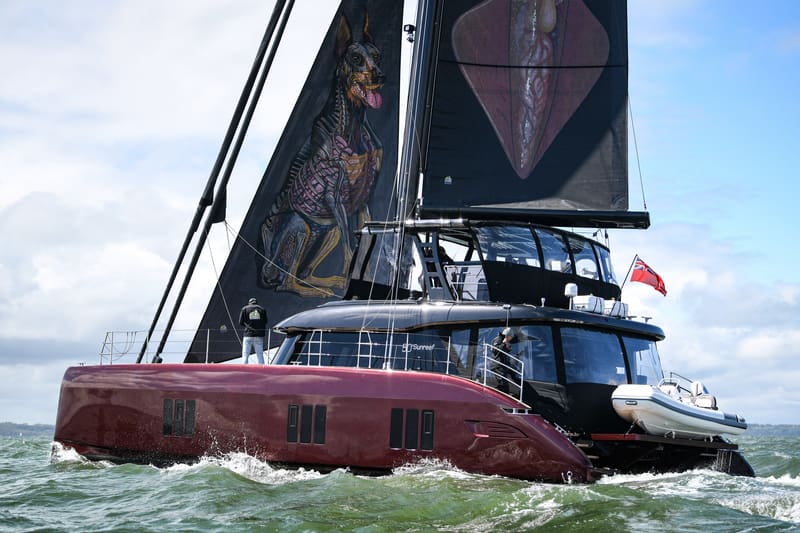
Production or performance cruising catamaran?
A common view is that you pay more for less when you buy a performance catamaran: fewer creature comforts, less living space, fewer berths, bathrooms, and instead get narrow hulls and sparse design. So, is the big price tag worth the upgrade in performance? If you are lured by the comfort of a production catamaran, but plan to sail intensively around the world for the next five years, it might not actually be the most comfortable option. No dishwasher or air conditioning is going to make a boat feel safer in a storm. Conversely, why buy a performance catamaran if you plan to leave the boat at the dock for 10 months a year? Ask yourself if you have the skills to harness the performance of a faster catamaran? And if not, how prepared are you to invest time into learning how to use the boat to her full potential? A common justification for buying a performance catamaran is that it can outrun bad weather and therefore is safer. But you cannot take advantage of that option if you sail everywhere with three reefs in the main because you are nervous of the boat’s power. Similarly, the power of performance catamarans comes in part from how light they are. If you load the boat with extras – personal gear, kitchen appliances, heating, aircon – you will quickly reduce a lot of the speed and safety advantages you’re paying for.
How to handle heavy weather in a cat?
A popular heavy weather strategy is avoidance: account for global weather patterns when planning your passages to ensure you sail during the more favourable months; invest in a good satellite connection to download accurate forecasts so you can see bad weather coming; use your boat speed to position yourself out of the predicted storm track; be flexible with departure windows and leave at an optimum time. However, do not misinterpret avoidance of heavy weather as a safety net. With weather systems becoming increasingly extreme and unpredictable (see page 38), this risk management strategy is becoming less and less dependable.
- Develop scenario plans for the type of boat you have so that you don’t have to start with a blank sheet of paper as a storm approaches.
- In all scenarios, on all boats, avoid 90° wind and waves. Your boat is at its least stable in these conditions. Sail with the weather forward or aft of the beam.
- Keep an eye on heel angle. Reduce sail if you start to see any more than 5° or so, unless you have a catamaran that is designed to lift a hull. Lower the centre of effort by reducing sail, starting with the main.
- Set up and practice how to reef downwind in case the weather comes in more quickly than you were expecting.
- If you can’t sail as fast as the waves, consider trailing warps to slow you down and help with steerage. You should aim to keep the speed relatively high. The key is to reduce the erratic surfing which drops the bows into green-water troughs. I prefer warps to drogues where possible because we are more familiar with them. Unless you practice using a drogue regularly, you will likely need to read the instructions when you get it out, which isn’t ideal in an emergency.
- If waves are breaking over your stern, consider turning into the seaway and holding steady. In a performance cat, you can drop the windward daggerboard, lift the leeward board, and pinch into the wind. In a production cat with no daggerboards, this will be difficult. Running the leeward engine might help you keep your bows into the wind. Watch that there is no back flow of water into the exhaust.
- Avoid lee shores at all costs, sea room downwind is key.
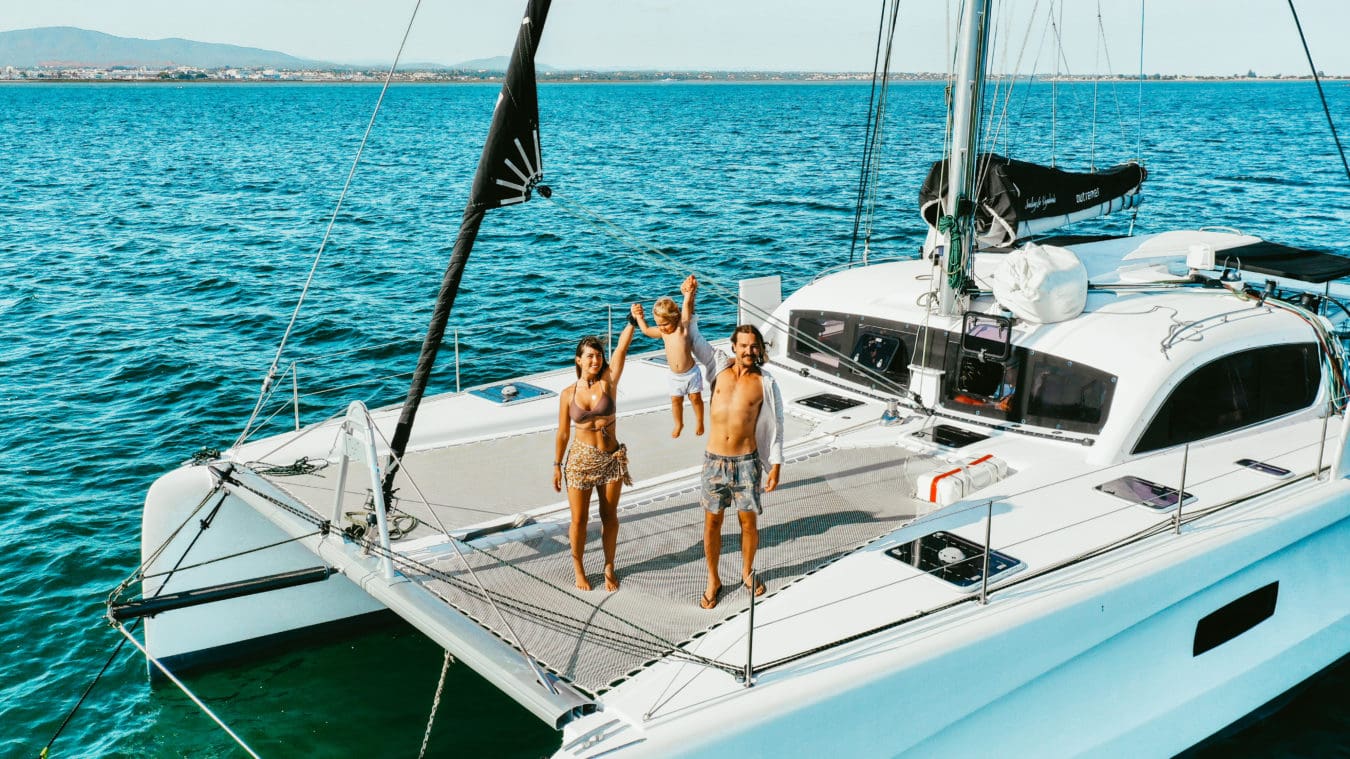
When should we go?
How long should you wait after buying a boat before heading out on your first bluewater passage? Whether you spend £100,000 or £1,000,000 on your boat, it’s likely to need some fine tuning. I’ve never heard of a new boat that was perfect. Some yards will cover the initial issues as part of the warranty, so staying close to the yard is a good idea within that period. Even if you don’t have a warranty, proximity to the yard can help you access parts, boat builders and people who understand how your boat has been constructed. The flip side is that you want to get going, and experience all the freedoms of your new yacht! Some serious bluewater sailing is also needed to test some of the systems. Give yourself two to six months before you head out on the first crossing. This is enough to test the boat out, but not so long that ‘passage-anxiety’ builds up and you never actually leave. Do not treat the first few months as a holiday. This is commissioning, and it is the last stage of the build. Test the boat as rigorously as you can before you leave the proximity of the yard. Complete a couple of substantial offshore passages of 48 hours or more to test the systems. Run everything, including the watermaker. Fly all the sails you own. Sail in fruity conditions relative to your ability (Force 6-8 as a guideline) to see how the boat (and you) cope.
Get some experienced people on board to bolster the crew for the early days. The ideal is to hire a professional coach, as this will make pushing the boat much safer and more fun for you. Do some training ; the MCA AEC four-day engine course is a really useful opportunity to explore the parts of the engine you are normally too nervous to. A safety at sea course is worth its weight in gold. Use this to put together a safety kit that you feel confident in and that is appropriate for your cruising plans. A basic maintenance course can also be helpful, ideally one that covers beginners’ sail repair, rigging, splicing, and electrics. Ask other sailors for a good tools and spares inventory list. On top of the standard parts that the equipment manuals recommend, current and previous owners of your boat model will have a plethora of advice.
Confident to cast off
Knowledge nurtures confidence, and confidence breeds positivity – which all contribute to a safe, and successful bluewater catamaran cruising experience. If in doubt, ask!
YACHTING WORLD // https://www.yachtingworld.com Yachting World has had its finger on the pulse of sailing since 1894 (though some of us joined a little more recently). We reckon we are the most enthusiastic sailing fans in the world: we love boats of all kinds, modern and classic, we like racing and cruising, are fascinated by innovation yet revere tradition, and nothing that floats is too big or too small for our tastes. Every day online and every month in print we bring you the very best in adventurous sailing, whether that be bluewater cruising, ocean racing, high latitudes exploring, or anything in between, and we pride ourselves on our independent tests, in-depth reports and top quality photo journalism.
ABOUT DOYLE SAILS // Around the world, Doyle Sails has over 500 sailmakers in 46 different locations, all equally passionate about sailing – living and breathing our ethos ’Global Leaders and Local Experts.’
As sailors, our obsession with sailing connects us to the water. The water is our playground, a sanctuary where we seek enjoyment, a competitive playing field where we race as competitors; it’s sometimes our home and always a place that unlocks our sense of adventure wherever that adventure might take us. Behind every adventure is a Doyle sailor who shares this same obsession as you. We put your journey at the very heart of what we do to deliver the ultimate enjoyment and performance, powering our constant need to push the boundaries in sail design and innovation, to reimagine sailing.
From dinghies, club racers and cruising yachts through to Grand Prix campaigns and Superyachts, we are your experts. Meet our team here .

Home » Blog » Bluewater sailboats » The best bluewater sailboats (we analyzed 2,000 boats to find out)
The best bluewater sailboats (we analyzed 2,000 boats to find out)
By Author Fiona McGlynn
Posted on Last updated: May 16, 2023
We analyzed two-thousand bluewater sailboats to bring you a list of proven offshore designs
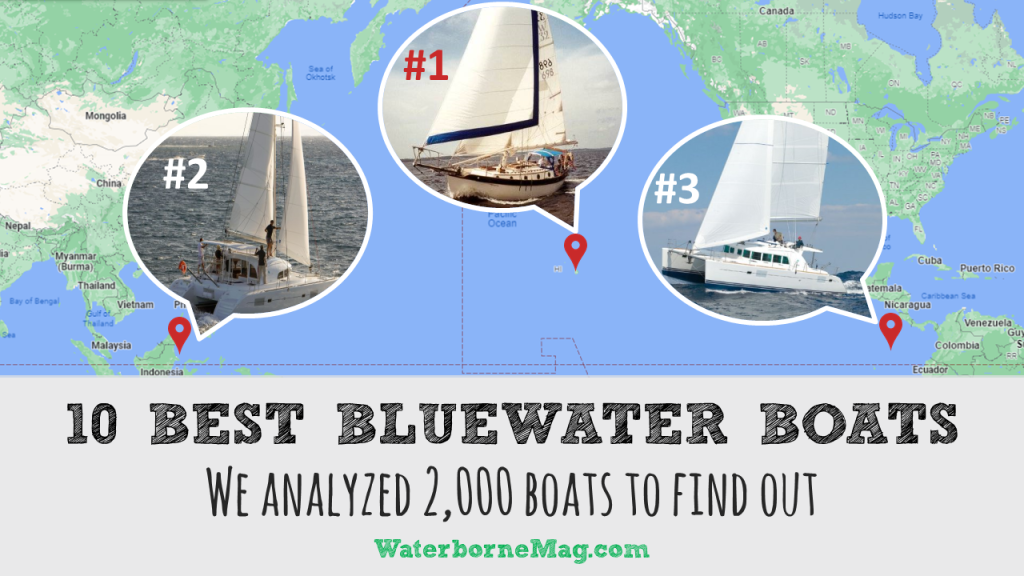
What are the best bluewater sailboats?
This was a question we asked a lot of experienced cruisers when we decided to sail across the Pacific. We needed a boat after all, and we wanted to buy the best bluewater sailboat we could afford.
We heard a lot of strong opinions.
Some sailors thought it was reckless to go offshore in any boat that didn’t have a full keel.
Others prioritized performance, and wouldn’t dream of going anywhere in a slow boat like the Westsail 32 (a.k.a. a “Wet Snail 32”).
Opinions like these left us feeling confused like we had to choose between safety and performance.
If we learned anything from these conversations, it’s that what makes a bluewater boat is a hotly debated topic!
However, there’s a way to cut through all the opinions and get to the bottom of it. The solution is….
We analyzed just under 2,000 boats embarking on ocean crossings (over a 12 year time period) and came up with a list of the ten best bluewater sailboats.
Where did we get our data?
The data for our best bluewater sailboats list comes from 12 years of entries in the Pacific Puddle Jump (PPJ), an annual cross-Pacific rally. We took part in 2017 and had a ball!
You can read about the methodology we used to analyze this data at the bottom of the post.
What do we mean by “best”?
We know, that word is overused on the internet!
Simply, based on our data set, these were the most common makes and models entered in the PPJ cross-Pacific rally. There were at least 10 PPJ rally entries for every make of boat on our top 10 list.
So, these boats are 100% good to go?
No! A bluewater boat isn’t necessarily a seaworthy boat. Almost every cruiser we know made substantial repairs and additions to get their offshore boat ready, adding watermakers , life rafts, solar panels, and more.
Also, you should always have a boat inspected by a professional and accredited marine surveyor before buying it or taking it offshore.
But my bluewater baby boat isn’t on this list!?
There are hundreds of excellent bluewater yachts that are not on this list. For instance, we sailed across the Pacific in a Dufour 35, which didn’t even come close to making our top 10 list.
Choosing the right boat is very much an individual journey.
Where can I find these bluewater boats for sale?
We recognize that a top 10 list won’t get you very far if you’re shopping for a bluewater boat (especially if you’re looking in the used market).
So, to help you find your perfect boat, we’re going to create a big list of bluewater boats that you can use to refine your search on Yachtworld, Craigslist, or any other places to buy a used boat .
Sign up for our newsletter to get our big list of bluewater boats list as soon as it comes out.
We’re also working on a series of posts by size class. For example, if you’re looking for a smaller boat, you can narrow it down to the best bluewater sailboats under 40 feet .
Takeaways from our analysis
There were no big surprises on an individual boat level. All of these makes are considered good cruisers, some of them are even best-selling designs! However, there were a few things that caught our eye.
“Go simple, go small, go now” still holds water
We were thrilled to see the smallest boat in our roundup at the very top of the list! Westsail 32 owners can take pride in their small but mighty yachts (and ignore all those snail-sayers).
While undoubtedly there’s been a trend towards bigger bluewater cruisers in recent years, small cruising sailboats seem to be holding their own. 60% of the monohulls on this list were under 40 feet (if you count the Valiant 40 which sneaks just under at 39.92 feet).
Cat got our tongue
So, we knew catamarans were a thing, but we didn’t fully appreciate HOW popular they’d become!
50% of our top 10 bluewater boat list consists of catamarans—a good fact to toss out the next time you’re trying to garner a happy hour invite on the party boat next door (which will undoubtedly be a catamaran).
Still got it!
We’ve got good news for all you good old boat lovers! 60% of the boats on our list were first built before 2000.
While these older models are less performance-oriented than modern designs, cruisers value these boats for their ability to stand up to rough seas and heavy weather. It just goes to show that solid bones and classic looks never go out of style.
Alright, without further ado, let’s dive into our list of the 10 best bluewater boats!
The 10 best bluewater boats
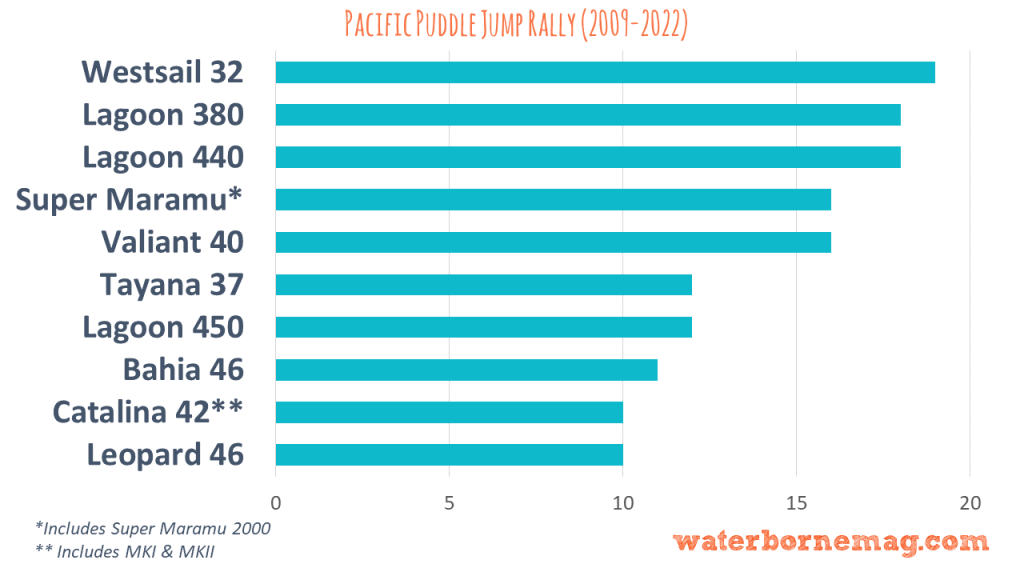
1. Westsail 32
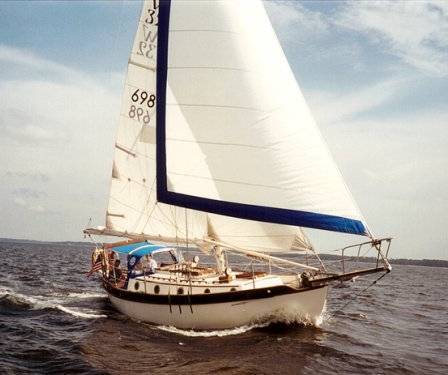
The Westsail 32 is one of the most iconic bluewater cruisers and 19 have set out to cross the Pacific in the PPJ rally since 2009.
In 1973, this small cruising sailboat garnered a 4-page spread in Time magazine. The article inspired many Americans to set sail and the Westsail 32, with its double-ender design, set the standard for what a real bluewater cruiser should look like.
There were approximately 830 built between 1971 and 1980.
This small boat has taken sailors on ocean crossings and circumnavigations. Though considered “slow” by some, the heavily-built Westsail 32 has developed a loyal following for her other excellent offshore cruising characteristics.
If you’re interested in small bluewater sailboats, check out our post on the best small sailboats for sailing around the world .
2. Lagoon 380
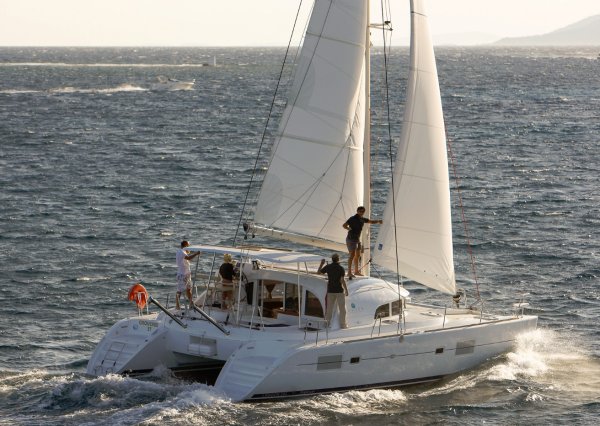
The Lagoon 380 is a reliable, solidly built catamaran and considered roomy for its size. We counted 18 of them in our data set. With over 800 boats built , it may be one of the best-selling catamarans in the world. Like the other boats on this list, the Lagoon 380 has proven itself on long passages and ocean crossings, winning it many loyal fans.
3. Lagoon 440
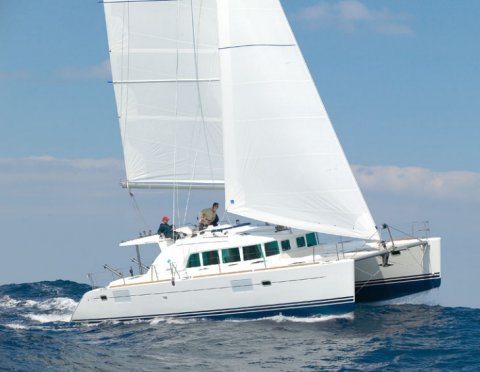
18 Lagoon 440s have set out to cross the Pacific in the PPJ rally since 2009.
Why leave the comforts of home, when you can take them with you? The Lagoon 440 is a luxurious long-range cruiser, offering beautiful wood joinery, spacious accommodations, and a deluxe galley. Oh, and you have the option of an electric boat motor !
SAIL and Sailing Magazine have both done in-depth reviews of the Lagoon 440 if you want to learn more.
4. Amel Super Maramu (incl. SM 2000)
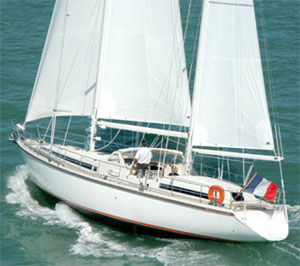
If you follow the adventures of SV Delos on YouTube, you probably know that the star of the show (SV Delos— in case the title didn’t give it away ) is an Amel Super Maramu. These classic bluewater sailboats can be found all over the world, proof they can go the distance.
We counted 16 Amel Super Maramus and Super Maramu 2000s in our list of PPJ entries.
Ready to join the cult of Amel? Read more about the iconic brand in Yachting World.
5. Valiant 40
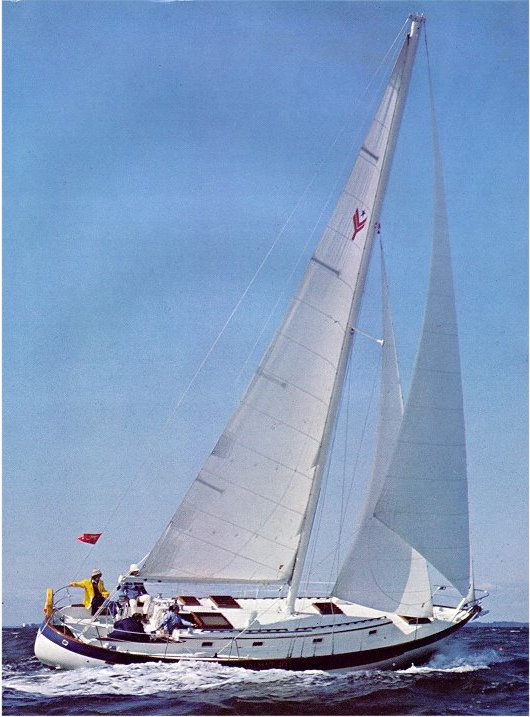
When I interviewed legendary yacht designer, Bob Perry, for Good Old Boat in 2019, he told me that the Valiant 40 was one of the boats that most defined him and marked the real start of his career.
At the time, heavy displacement cruisers were considered sluggish and slow, especially in light winds.
Perry’s innovation with the Valiant 40 was to combine a classic double ender above the waterline, with an IOR racing hull shape below the waterline. The result was the first “performance cruiser”, a blockbuster hit, with over 200 boats built in the 1970s.
It’s no surprise we counted 16 Valiant 40s in our data set.
Cruising World magazine dubbed it “a fast, comfortable, and safe cruising yacht,” and there’s no doubt it’s covered some serious nautical miles.
It’s worth noting that there were blistering problems with hull numbers 120-249 (boats built between 1976 and 1981). Later models did not have this problem. Despite the blistering issues, the Valiant 40 remains one of the most highly thought of bluewater designs.
6. TAYANA 37
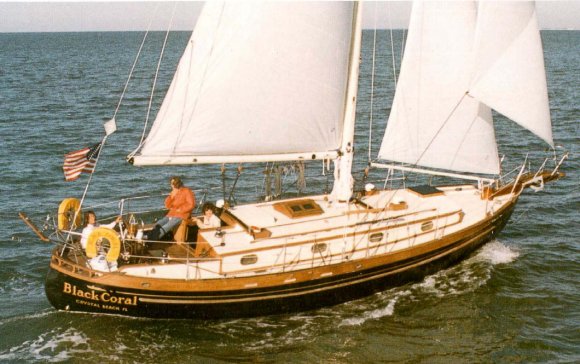
The Tayana 37 is another hugely popular Perry design. The first boat rolled off the production line in 1976 and since then, nearly 600 boats have been built. Beautiful classic lines and a proven track record have won the Tayana 37 a devoted following of offshore enthusiasts.
12 Tayana 37s have set out to cross the Pacific in the PPJ rally since 2009. Read more about the Tayana 37 in this Practical Sailor review .
7. Lagoon 450
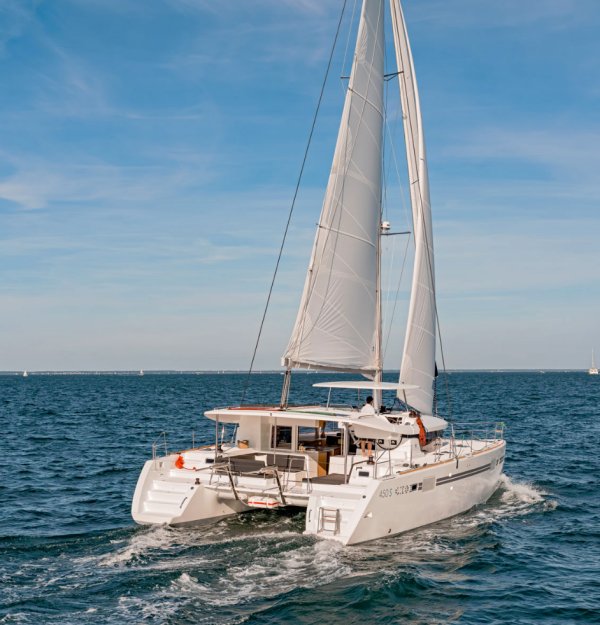
If this list is starting to sound like a paid advertisement, I swear we’re not on Lagoon’s payroll! This is the third Lagoon on our list, but the data doesn’t lie. Lagoon is making some of the best cruising sailboats.
The 450 has been a hot seller for Lagoon, with over 800 built since its launch in 2014. While not a performance cat, the Lagoon 450 travels at a reasonable speed and is brimming with luxury amenities.
At least 12 owners in the PPJ rally chose the Lagoon 450 to take them across the Pacific. It’s no wonder SAIL had so many good things to say about it.
8. Fountaine Pajot Bahia 46
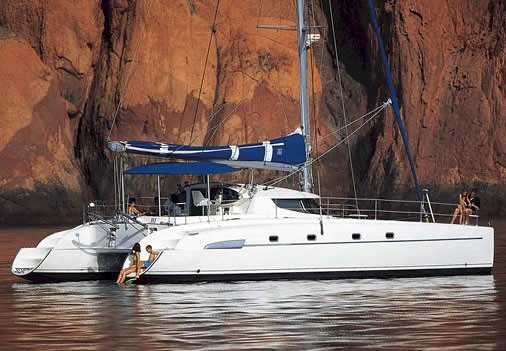
There were 11 Fountaine Pajot Bahia 46s in our data set.
Fountaine Pajot released the Bahia 46 in 1997, a sleek design for traveling long distances. Its generously-sized water and fuel tanks along with ample storage for cruising gear are a real plus for the self-sufficient sailor.
According to Cruising World , “Cruising-cat aficionados should put the Bahia 46 on their “must-see” list.”
9. Catalina 42 (MKI, MKII)
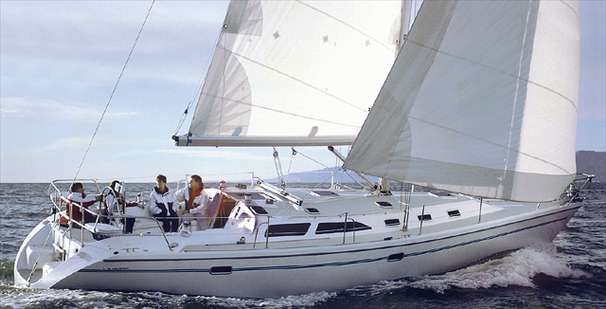
10 Catalina 42s (MKI and MKII) have set out to cross the Pacific in the PPJ rally since 2009.
The Catalina 42 was designed under the guidance of the legendary yacht designer and Catalina’s chief engineer, Gerry Douglas.
One of Catalina’s philosophies is to offer “as much boat for the money as possible,” and the Catalina 42 is no exception. According to Practical Sailor , Catalina aims to price its boats 15% to 20% below major production boats like Hunter and Beneteau.
Practical Sailor has a great in-depth review of the Catalina 42 .
10. Leopard 46
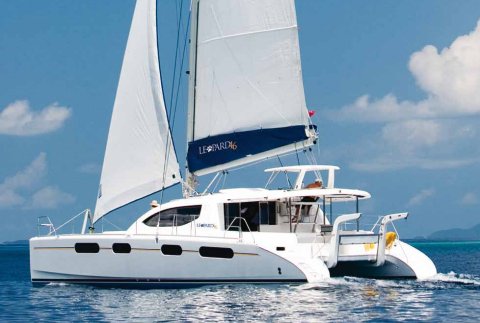
Since 2009, 10 Leopard 46s have embarked on Pacific crossings in the PPJ rally.
Leopards have won legions of fans for their high build quality, robust engineering, and excellent performance.
The Leopard 46 also boasts something of a racing pedigree. It was built in South Africa by Robertson and Caine and designed by Gino Morelli and Pete Melvin, who came up with the record-breaking catamaran Playstation / Cheyenne 125 .
Read more about the Leopard 46 in this Cruising World review .
Methodology
What the data is and isn’t.
The PPJ data was a real boon because it reflects a wide range of cruising boats: small, big, old, new, expensive, and affordable. We think this may be because the PPJ is a very financially accessible rally—the standard entry cost is $125 or $100 if you’re under 35 (age or boat length!).
We did look at data from other (pricier) rallies but found that the results skewed towards more expensive boats.
Needless to say, the data we used is just a sample of the bluewater boats that crossed the Pacific over the last 10+ years. Many cruisers cross oceans without participating in a rally!
Entries vs. completions
The data we used is a list of the PPJ entries, not necessarily the boats that completed the rally. In instances where we saw the same boat entered multiple years in a row, we assumed they’d postponed their crossing and deleted all but the latest entry to avoid double counting.
Boat make variations
The world of boat building and naming can get pretty complicated. Sometimes a manufacturer changes a boat’s name a year or two into production, other times the name remains the same but the boat undergoes a dramatic update.
For the most part, we’ve used SailboatData.com’s classification system (if they list the boats separately, then we have also), except where there are two separately listed models that have the same LOA, beam, and displacement.
Fiona McGlynn is an award-winning boating writer who created Waterborne as a place to learn about living aboard and traveling the world by sailboat. She has written for boating magazines including BoatUS, SAIL, Cruising World, and Good Old Boat. She’s also a contributing editor at Good Old Boat and BoatUS Magazine. In 2017, Fiona and her husband completed a 3-year, 13,000-mile voyage from Vancouver to Mexico to Australia on their 35-foot sailboat.
Terms and Conditions - Privacy Policy

Aspiring Bluewater Cruisers,
Welcome to your future, keep reading to change your life and learn how to sail the world..., free masterclass reveals: how to travel the world by sai l, even if you have no experience & are just starting out, join us starting on friday may 27th at 8pm est for this no-cost 3 day masterclass, in this masterclass we’ll be sharing all the secrets society doesn't want you to know about how to get out of the rat race and live a life of freedom and adventure., free masterclass reveals: how to travel the world by sail , even if you have no experience & are just starting out, here’s what you’ll learn:, how to find a boat, prepare yourself and your family and decide to go, even if you've never sailed before, how to make it work financially, even if you're scared you can't afford it right now, how to overcome your fear, avoid expensive mistakes and stay safe, even if you have no experience., air travel is suffering, but the sailing world is thriving , and right now, is the best time in history to become a bluewater cruiser, just add your name and email address to join the masterclass instantly, we will never share your information with anyone..
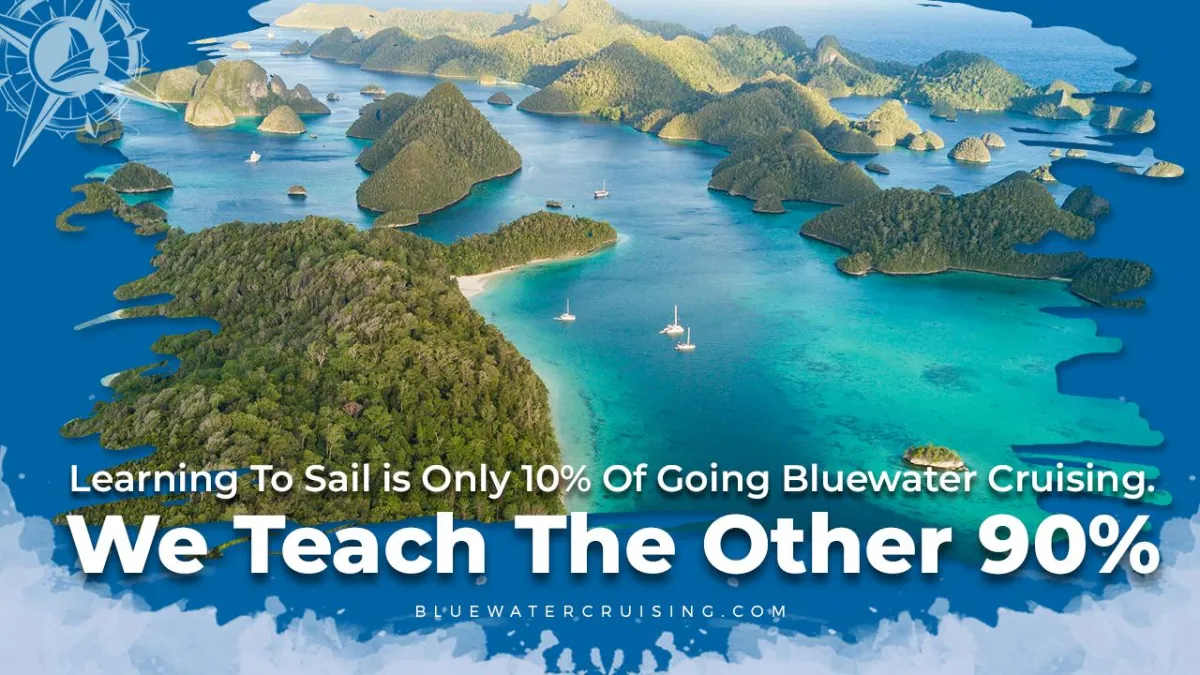
Your Masterclass Hosts:

Keith Whitaker
“In summer of 2016, we sold our home in our quiet suburban Texas neighborhood...
...said goodbye to friends and family, Liquidated most of our assets...
And bought a sailboat to circumnavigate the globe.
The kids were really excited about that in the beginning.
Then 90 days later we were thinking what on earth have we done?
Without any prior sailing knowledge we've since sailed over 50,000 miles through three different oceans in both a monohull and a Catamaran.
Want to know which one was better?
Come join us on our FREE masterclass and find out!
If I can do it...
Anyone can.
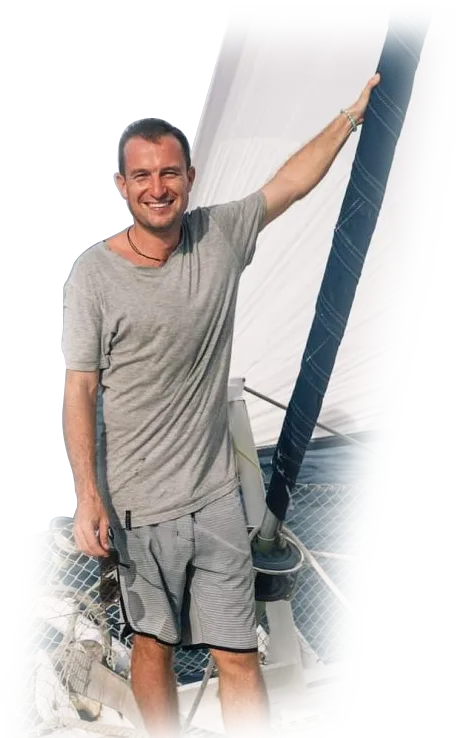
Chris Biasutti
I'm Chris and in September of 2016, one month before my youngest daughter was born we bought a boat to sail the world.
Sounds crazy right?
Why'd I do it?
I wanted to experience more life.
I'd spent eight years of my life running an international investment sales business. I reached a point where I realized I was not happy and I wanted to do something different... so I did.
Today I've sailed over 20,000 miles with my family through two different oceans and loved every minute of it.
Ok... that's not totally true. I didn't love EVERY minute of it. But this experience has forever changed my life and my family's life for the BETTER.
Want to know how I did it?
Join us on our FREE Masterclass and find out!
Finally create the lifestyle you deserve..., this training will share with you everything you need to know to prepare yourself, your boat and your finances to start sailing the world so you can share the experience of a lifetime with your family.
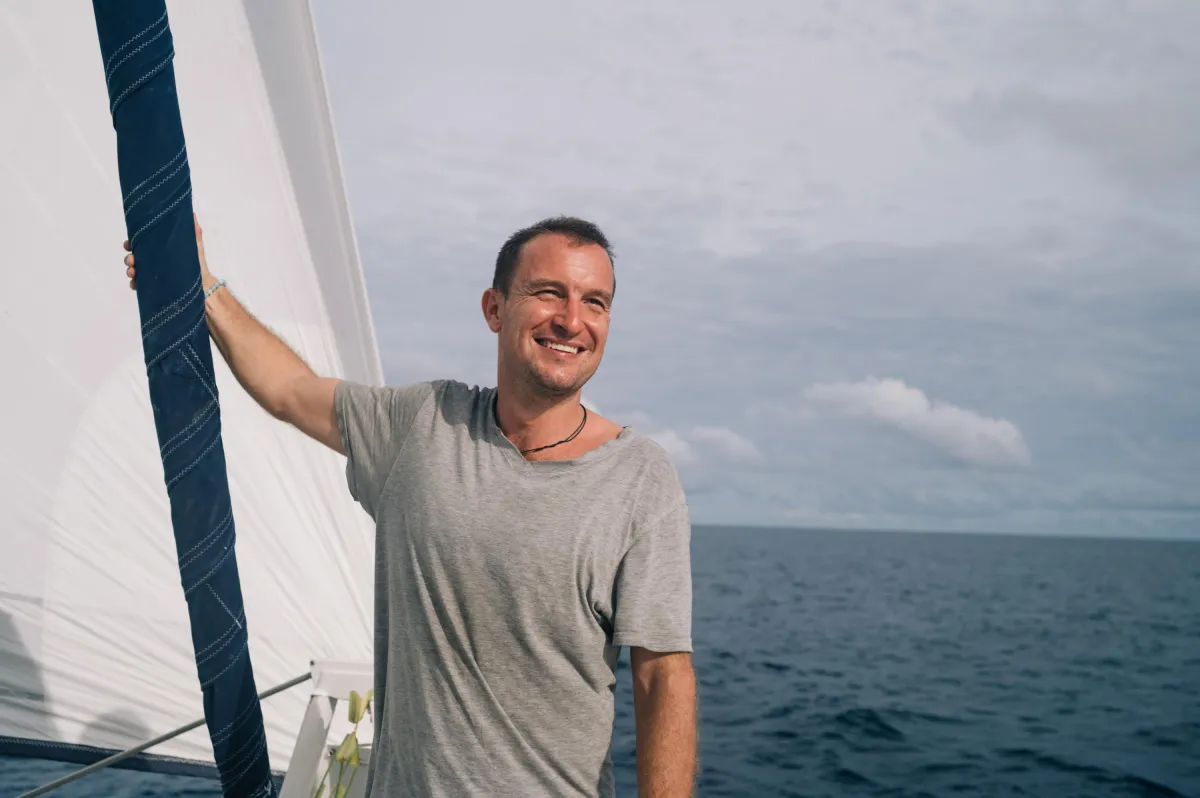
© 2024 Bluewater Cruising All Rights Reserved
Privacy Notice | Disclaimer | Terms and Conditions

What Is a Blue Water Catamaran? (Pictures and Examples)
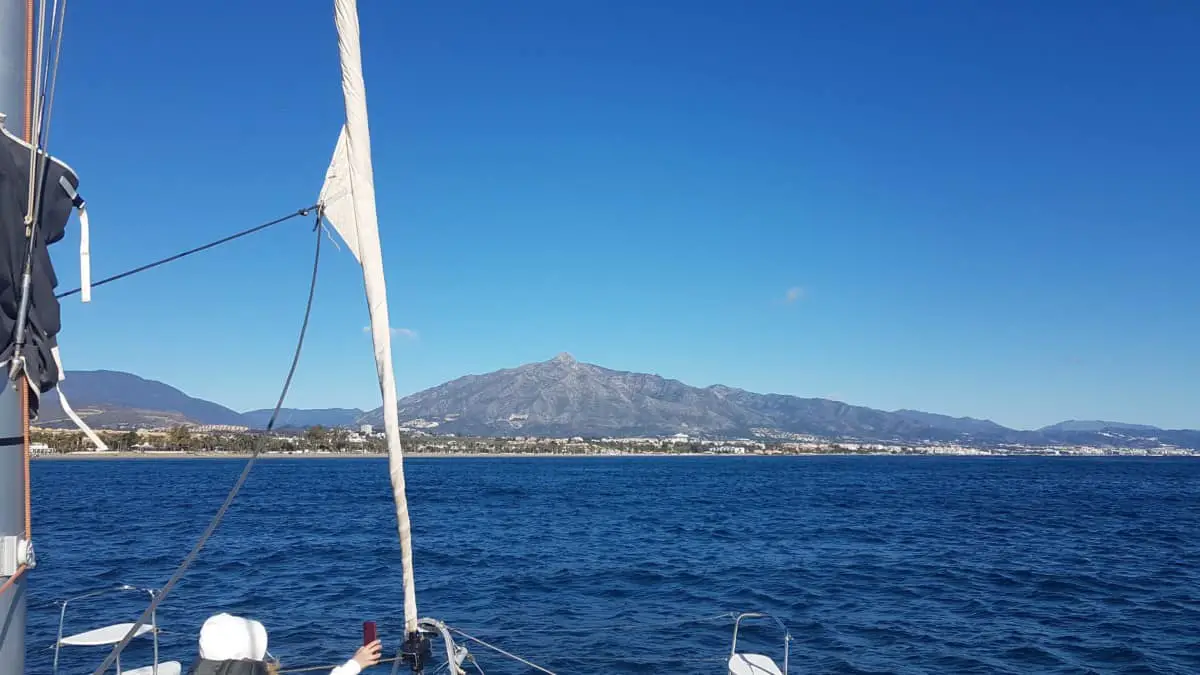
As an Amazon Associate, we earn from qualifying purchases. We may also earn commissions if you purchase products from other retailers after clicking on a link from our site.
When I transitioned to a life of seaborne travel and adventure, it came with several challenges, the first being deciding the type of boat to use. In that process, I came across terms like “blue water sailing” and “catamaran.” A few years later, I think I got the hang of it, and today I want to share my knowledge on what exactly a blue water catamaran is!
A bluewater catamaran is a multi-hulled vessel used for extended voyaging that can sail in very rough seas. Offshore catamarans are usually 40ft or longer, very stable, carry heavy loads, and are designed to be very safe.
Some say blue water catamarans make sailing under the most demanding conditions comfortable and safe, but are they right? Read on for detailed explanations of the features that make this boat type an excellent choice for sailors.
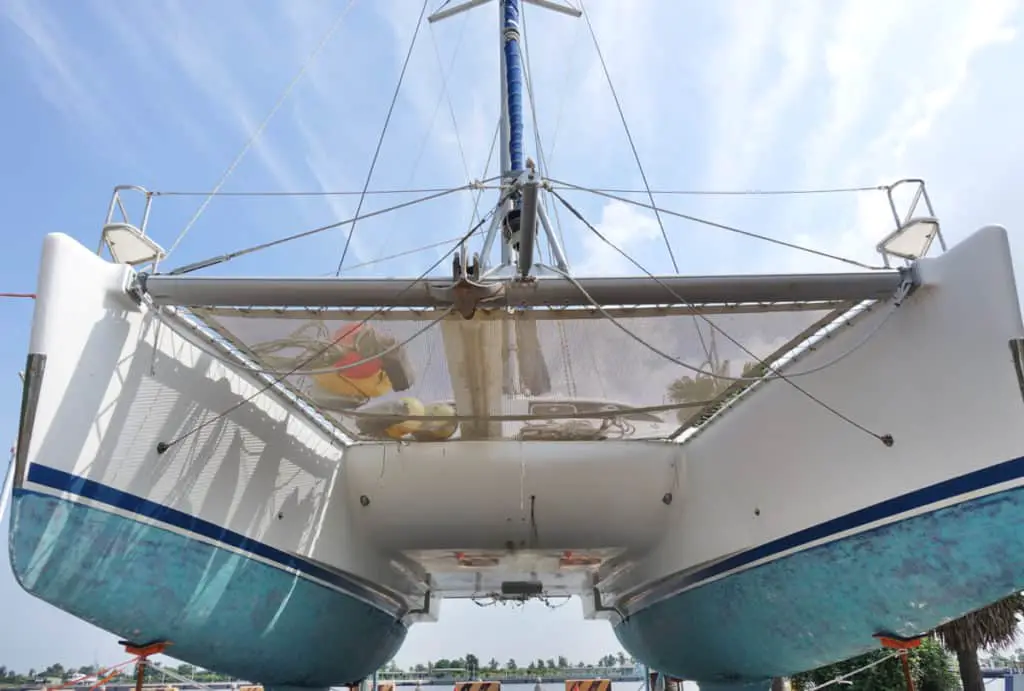
Table of Contents
What Is a Catamaran?
A catamaran is a sea vessel constructed from two hulls that lie perpendicular to each other. This type of boat is traditionally used for recreational purposes. However, it is also quite common to use them in the commercial fishing industry.
If you want an in-depth explanation i suggest you read this article.
They are fitted with both sails and a combustion engine, these can run together or separately.
Usually, these vessels will have at least one headsail (generally referred to as a staysail), and one mainsail.

What Is a Blue Water Catamaran?
Bluewater catamarans are generally larger than boats made for coastal sailing. On average, these vessels come in sizes between 30 – 70 ft, offering cargo and passenger space for a few dozen people or more. They feature carbon fiber or fiberglass construction and come in different sizes for various activities. Some of these blue water boats feature flybridges.
What is a flybridge?
A blue water boat is a boat that is optimized for sailing big oceans and doing long ocean passages. This is to be compared to a coastal cruiser which mainly is used for sailing less rough waters and where the need for storage to hold multiday provisions isn’t necessary. A bluewater catamaran is also equipped with more advanced technology and offers better protection from the weather. More on this further down in the article.
Why Are They Called Blue Water Cats?
Blue water sailing is a term that refers to the open ocean. Non-blue water sailing, on the other hand, typically means navigating inland waterways and coastal areas.
The difference between blue and non-blue waters lies within their visibility as well as hazards present in each location. The two types of seas have different types of challenges for sailors, especially when it comes to navigation at night or if you have a storm brewing on the horizon.
Blue water sailing is primarily done on the open seas where there is a lot of room to maneuver and travel long distances without hitting land or running into shallow waters. These types of voyages take place during the day, as well as at night when necessary. As a result, blue water sailing requires more gear, skills, and sturdier vessels.
Non-blue water sailing typically does not venture out too far from shore and stays within sight of land so that it is possible to find a way back home if need be.
Generally, blue water boats are more powerful (bigger sails and engines), while non-blue water vessels may not need to move at higher speeds, so they feature smaller sails and engines with lower horsepower.
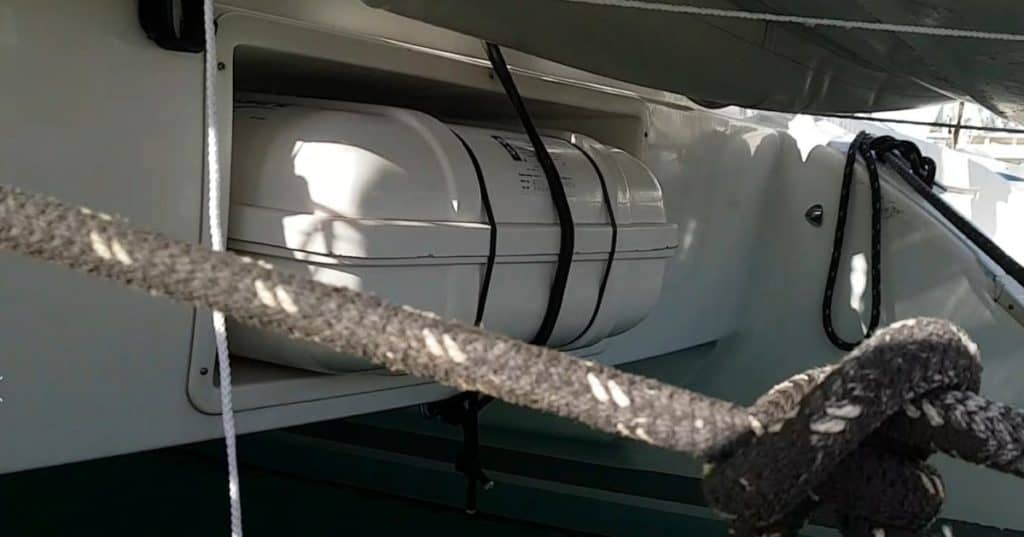
How Is a Blue Water Catamaran Equipped?
A blue water catamaran comes with all the equipment necessary to make your voyage on open water safe and as comfortable as can be.
Here are some of the standard features you’ll find in this boat type:
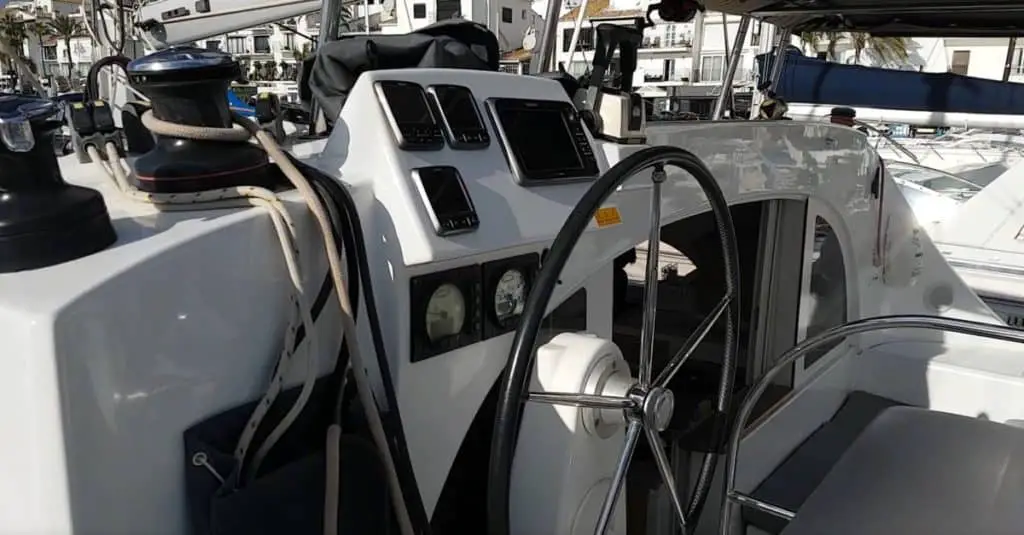
The autopilot is a critical component of a blue water boat. Cruising without it can arguably be an absolute nightmare. You’d be precisely glued to the helm the entire journey, making it burdensome and uncomfortable. These boats come with in-board pilots whose rams are fixed directly to their rudder segments.
This is not a “nice” to have feature; it is definitely a “need,” Without it, you will tire out the crew and significantly increase the risk of sailor error.
The best catamarans feature durable, easy-to-adjust, and effective pilots that can easily take you on a voyage without breaking down.
Pro tip: carry one extra, sooner or later it will break!
Global Positioning System (GPS)
The GPS is undoubtedly essential equipment on any cruising vessel. Blue water boats come with either bottom of the range GPS, which gives you the exact position, or top of the range GPS, linked with electronic cartography.
Electronic cartography allows you to view charts for the whole world, the boat’s position, speed, waypoints, ETA, water depth — to mention but a few — resulting in a much more effortless navigation. For instance, you can use it to avoid rocks when sailing along a coast.
There are many options but usually it is the budget that sets the standard.
A Good Dinghy
A good dinghy is a must-have in a catamaran. You use it to go ashore, bring provisions into the boat, refill water, go diving, or lay an anchor to complete your mooring – it’s a versatile piece of equipment that makes cruising easier.
It can be placed at the stern, or under the davits, between the hulls to allow for flexibility and easy access to hard-to-reach places, such as coral beaches.
Remember! A dinghy is not a life raft, they are designed for different things!
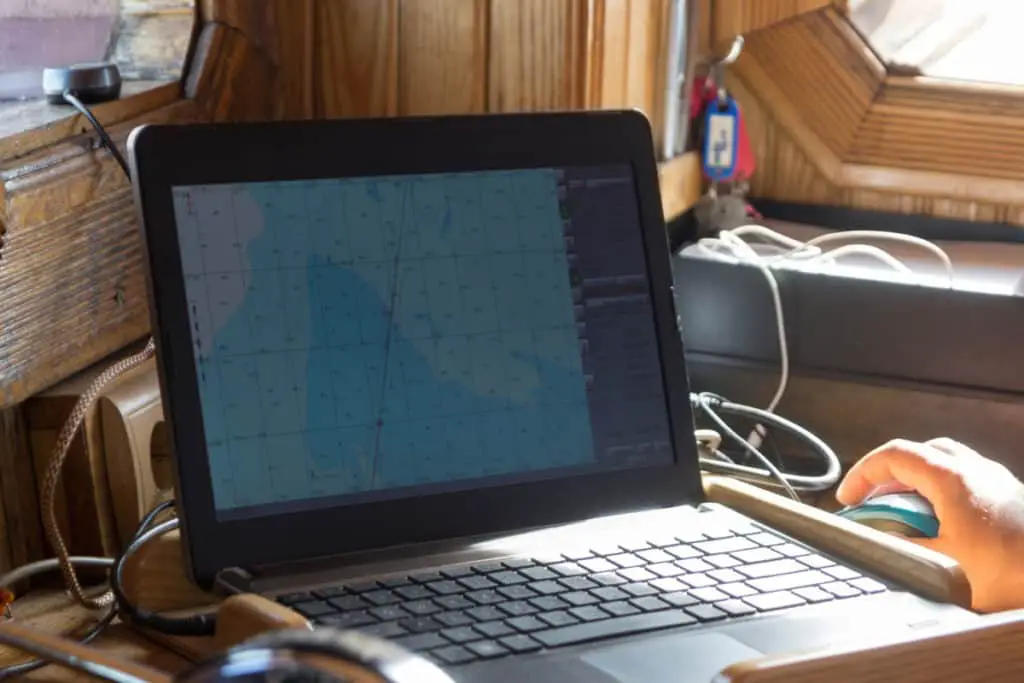
Computer/Navstation
Modern cats come with computers for comfort, convenience, and safety. These devices are used for electronic cartography, receiving weather data, and as support for the logbook.
You can use them to process digital photos and send or receive emails – you can still keep in touch with clients and friends as you enjoy the therapeutic sea. Besides, you can store music and watch movies during the journey – the applications are endless!
A marine radar scanner is a critical offshore device and a must-have on a blue water catamaran. It’s used to detect obstacles, other sea vessels, to mention but a few. It produces radio waves, which travel around the water surrounding the boat up to the horizon. It then detects if the waves have been reflected, showing you whether there’s an object on your course. This information is essential since you need it to avoid a collision.
It will also show you where the closest squall is and what direction it is headin giving you enough time to reef your sails.
Power Source
A catamaran’s engine and appliances must be supplied with energy – a no-brainer. A cat generally comes with two starter batteries: one for each engine and one or two more for its equipment. These batteries are charged by the engines. However, you must run the engine for several hours daily to keep them charged.
Instead of that, most sailors use solar panels or wind generators. A technology that is becoming more and more common is using the propeller to generate energy.
Many cruisers also have a standalone generator for charging batteries and supplying power to on board electronics.
What To Look For in a Blue Water Catamaran
When buying a cat, it’s critical to identify the one that best suits your needs. Regardless of whether you plan to use it for fishing, racing, or voyaging, here are some of the critical factors you should consider:
The key considerations here should be strength and durability. Fiberglass is generally the main material type used in hull construction. Fiberglass is the most preferred since it’s strong and durable. The difference lies in the hull core, usually the core is either some organic material such as balsa, or it could be a synthetic such as plastic foam.
The balsa is cheap, but if there is a water intrusion, it will start to rot, and structural integrity may suffer. The foam sandwich type is usually unaffected by water intrusion but tends to be more expensive.
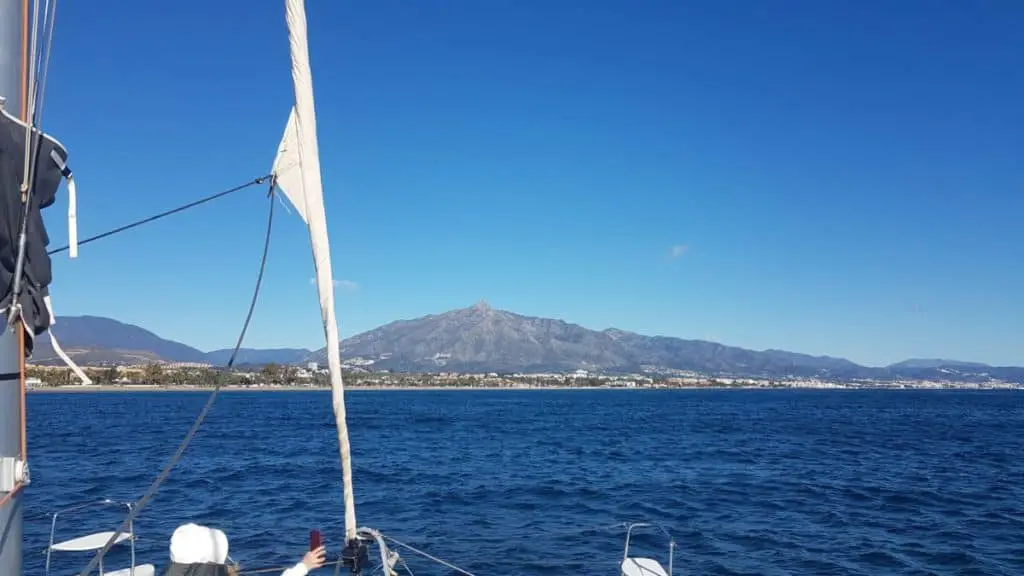
The Sailplane
It would be better to pick a catamaran with an easy-to-handle sailplane. The primary issue here is manageability – the staysail should be easy to replace using a hanked-on storm jib during stormy weather. Also, even though you have a crew on board, the sails should be set up for shorthanded sailing, so the helmsman doesn’t have to wake up the crew every time adjustments need to be made.
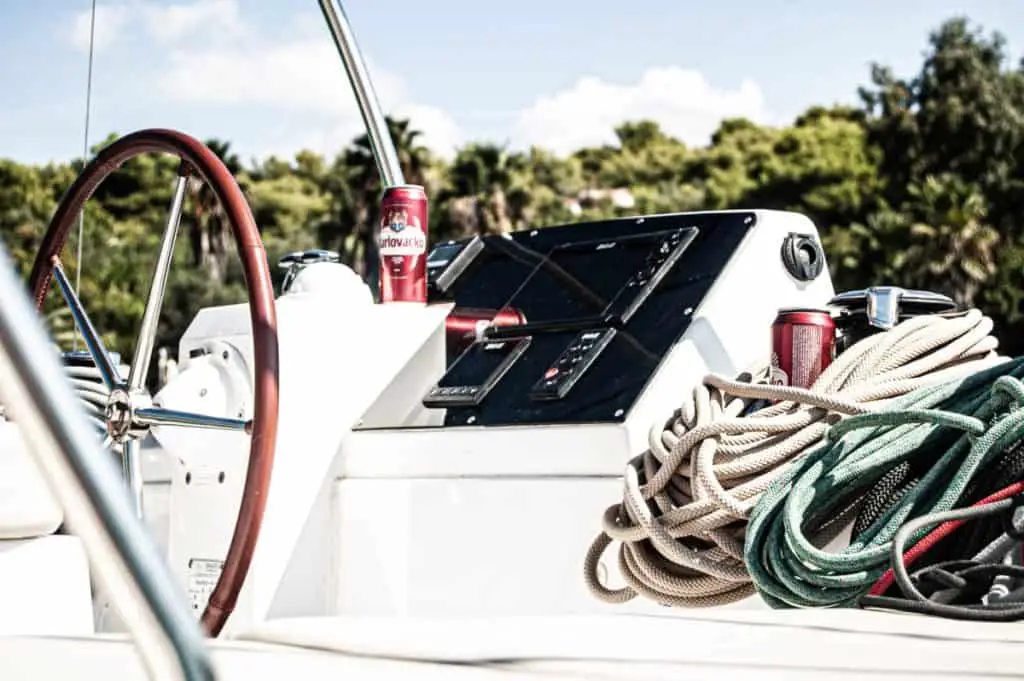
The cockpit should be a priority consideration when choosing a catamaran for offshore adventure.
Aft cockpits are generally better than center since they’re lower and better protected, making them safer. Besides, an aft and centered cockpit suffer less impact from boat motion.
Flybridge helms are great looking and awesome for coastal sailing, but for safe offshore passages, they offer many safety issues that, if you want to, can read all about in another one of my articles .
Heavy or Light Displacement
The opinions of sailors on the displacement type vary based on the tradeoffs of either option. On the one hand, a heavy displacement hull with long overhangs and a full keel provides a more comfortable ride in rougher conditions but performs poorly in lighter conditions.
On the other hand, light displacement is limited in stowage. Most notably, too much load affects its displacement ratio, compromising performance. However, it comes in handy when you need to manage heavy going.
When talking about catamarans one should mention that “heavy displacement on a cat” is not the same as “heavy displacement on a monohull”. The cat will still be very light in comparison to the monohull, but when comparing a catamaran with another catamaran “heavy” vs “light” makes sense.
Water Supply
During your journey, you’ll definitely need sufficient fresh water for washing, cooking, and drinking. Because of that, you should look for the water storage capacity of your sailboat.
As a rule of thumb, you should look for a cat with sufficient water storage for your crew, plus a 20% allowance. To put it into context, a couple on a transatlantic passage would need two imperial gallons daily, plus a 20% contingency allowance.
Suppose the couple goes on a three-week adventure. In that case, they’ll need a minimum of 50 gallons of fresh water. Blue water cats ideally have double that capacity, usually split into two tanks. If one gets contaminated, they can use the second one.
Tip: It’s prudent to rig a system that catches rainwater when the boat is underway or anchored. You can also use a reverse osmosis watermaker. However, it shouldn’t be the sole source of water. These watermakers can break down, causing a lot of inconveniences.
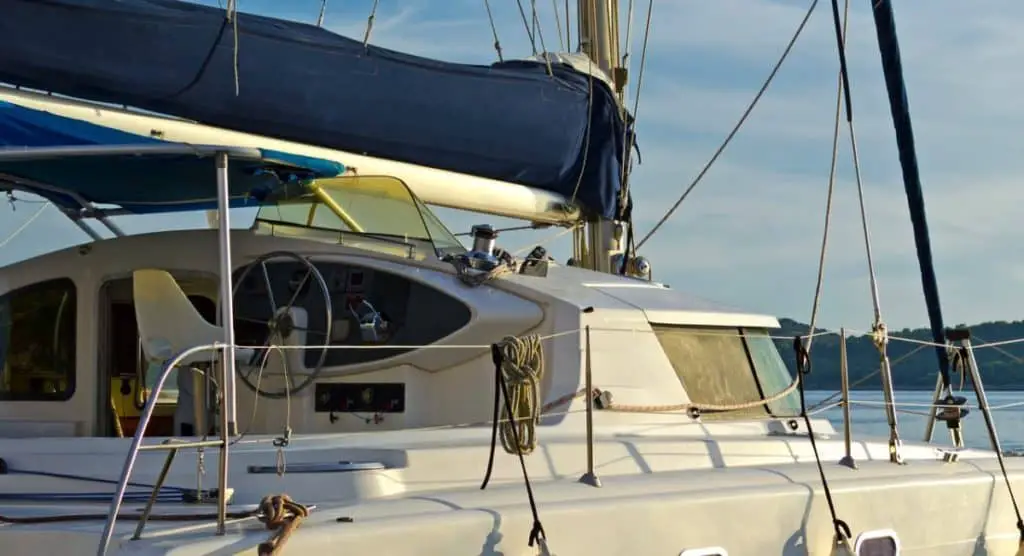
Protection From the Elements
However much you may wish to cruise in sunny, calm, dry weather to have an uninterrupted view of marine life during your journey, chances are you’ll encounter some rain, wind, or flying spray. Therefore, it’s better to pick a catamaran that comes with a well-protected helm to shelter you and your crew from the elements. Depending on your preference, the dodger can be a canvas construction around a collapsible frame or a rigid structure.
Too much sun can also cause discomfort and damage your skin, so you should ensure the sailboat comes with a bimini top cover.
What Are the Best Blue Water Catamarans?
There are so many awesome blue water catamarans I could make an entire website about them, but here I have listed two interesting examples that could act as a jumping-off point to your future research.
The Lagoon 55 is a luxurious cat designed by Marc Van Peteghem , a renowned French Naval architect. This boat is spacious – it can be arranged with up to six double cabins and comes with a more extensive flybridge. Its transom’s surfaces aren’t just a way to access this vessel; they can be converted to a living area. This boat also comes with a dedicated forward cockpit connected to the saloon by a drop-down window.
Fountaine Pajot Elba 45
The Elba 45 is an incredible catamaran. Designed to replace the Helia 44, this boat has done the job perfectly. It comes with high-speed, efficient motoring, and remarkable performance. Its fixed stub keels and aft-raked bows deliver top-notch windward performance.
To improve safety, this sailboat’s keels are glued into a designed recess in the hulls. Because of that, none of the keel bolts can rip out and put you in danger in the event the Elba 45 gets grounded or collides with an obstacle.
Besides, this boat features a low-profile lounging space, a pronounced reverse sheer that minimizes the bulk of windows to create useful space below, and high topsides and bows.
If these are out of your range or not interesting I suggest you check out some of my other articles:
- Best catamarans under $200k
- Best catamarans under $100k
- Best catamarans under 50ft
- Best catamarans under 30ft
- Best catamarans for couples
- Best catamarans sailing around the world
Frequently Asked Questions On Blue Water Cats
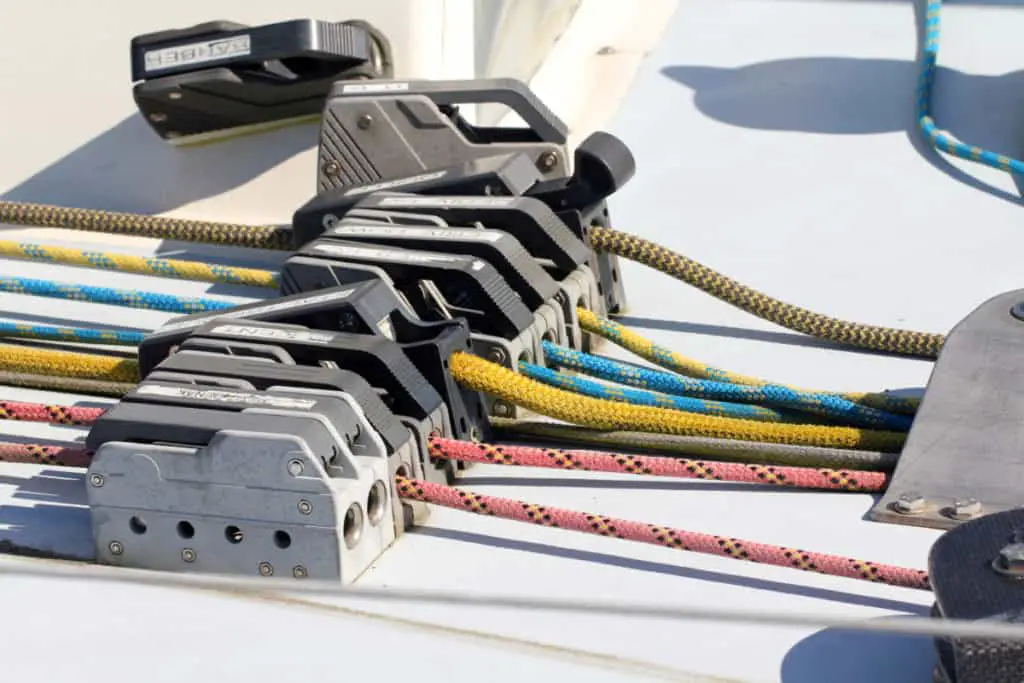
Can One Person Solo a Blue Water Catamaran?
Blue water cats (and cats in general) can be sailed shorthanded if they are set up correctly, this setup includes all lines to the cockpit, roller furling mainsail, and autopilot. The skill of the sailor is also essential for safe single-handed sailing.
Tip: Take extra precautions when sailing offshore such as adding an emergency position indicating radio beacon (EPIRB) or including additional radar reflectors on board.
Also, before sailing a blue water cat, check the relevant state and federal regulations. For instance, most states require sailors to complete safety courses before sailing, while others require you to obtain a license.
I have a dream of solo sailing my cat around the world, if you want to know how this can be done I suggest you read some of my other articles:
- Can one person sail a catamaran?
- Best solo blue water catamarans
- How to single-handed sail a cat
Can I Cross Oceans Using a Blue Water Catamaran?
Crossing an ocean with a blue water catamaran is one of the safest ways to do it! This is due to their excellent stability, safety, and crew space on board. They are inherently more stable than any other type of boat due to their exceptional buoyancy and roll inertia from their unique hull design.
This means that these catamarans will seldom capsize in extreme conditions but give good protection against the weather or damage caused by strong wind gusts. They also have less side motion, so even though waves may break over the deck during bad weather, there’s no risk of people sliding off, creating a man-over-board situation.
What Is a Good Size Catamaran For Crossing Oceans?
The perfect sized catamaran for sailing big oceans is around 40ft; it is small enough to be sailed by one person but big enough to provide safety and speed. Of course, there are many variables to consider.
Want to know more? Read Best sized Catamaran for Ocean Sailing and Liveaboard
Wrapping Up
Indeed, a blue water catamaran is the best companion for anyone going on a long adventure on the sea. Its fiberglass construction, twin hulls, expansive deck and interior space, and natural redundancy design makes for a safe advenure.
I hope this was useful, take care and live the adventure!
Owner of CatamaranFreedom.com. A minimalist that has lived in a caravan in Sweden, 35ft Monohull in the Bahamas, and right now in his self-built Van. He just started the next adventure, to circumnavigate the world on a Catamaran!
Leave a Reply Cancel reply
Your email address will not be published. Required fields are marked *
Save my name and email in this browser for the next time I comment.
Recent Posts
Must-Have Boat Gear for Catamaran Sailors!
Sailing is probably the most gear-intensive activity I've ever done; there are so many decisions to be made about what gear to buy now, for tomorrow, and what to definitely never buy. The gear on...
6 Best Trailerable Trimarans For Bluewater and Coastal Sailing
Having a boat costs a lot of money, even when you are not using it, marina fees, etc. And once it is in the water most sailors never go very far from their "home marina" and sailing will be somewhat...
Yachting Monthly
- Digital edition

Monohull or multihull: which is best for blue water?
- Chris Beeson
- March 29, 2016
As former editor of Yachting World, David Glenn has plenty of experience of both monohull and multihull cruising. Here he weighs up the pros and cons

One hull, or two? Your choice will define your life afloat Credit: David Glenn
Through the binoculars I could see masts off Basil’s Bar on Mustique. Their lack of movement suggested a fine anchorage, sheltered from the tradewind-driven swell that builds up in the channel between Mustique and Bequia. It soon became apparent that most belonged to cats, immune from the rolling monohulls like ours would endure if we were to stop in this otherwise enticing bay.
More anchorages in a multi

Cats galore off the Soggy Dollar Bar, Jost van Dyke: too shallow for a fixed keel monohull of similar size
Stability is one of the truly great advantages of a cruising multihull. Not just at sea where the tiresome business of heeling is something that simply doesn’t – or shouldn’t – happen to any great extent, but at anchor too. It dramatically widens one’s choice of anchorages to include those affected by swell – not uncommon in the Caribbean, for instance, where a subtle change in wind direction can make a previously flat calm anchorage unbearable in a monohull. Its comparatively shoal draught widens the choice still further.
I grew up with monohulls, own one, and frankly wouldn’t consider a multihull for the sort of sailing I do. In northern European waters, marina berthing is a regular necessity and completely safe open anchorages are few and far between.

No rolling or heeling, 360° views and one-level living, as here on a Lagoon 52, appeal to many
But if I were to undertake some serious blue water cruising and I wanted family and friends genuinely to enjoy being afloat, particularly those less experienced, a multihull would have to be a consideration. I would have to put aside the question of aesthetics – let’s face it, they’re ugly beasts – and forego that unique and satisfying sensation of a yacht sailing well, because to date I have not experienced it in a cruising multihull. And that’s quite a sacrifice.
More space in a multi
My attitude changed after chartering catamarans in the Caribbean and Mediterranean. The need to accommodate two families comprising largely of teenage children made the choice of a multihull a no-brainer. In a 46-footer we could accommodate a party of 10 in comfort and the paraphernalia demanded by youth, like surfboards, windsurfers, kites and snorkelling kit, without feeling jammed in.

One-level living makes a big difference when sailing as a famly
The cavernous berths in the ends of the hulls, the wide saloon-cum-galley with its panoramic view and the inside/outside lifestyle made possible by the juxtaposition of the big aft deck and the same level saloon, got the entire crew onside instantly.
As an outside living space, with a trampoline at one end and a massive aft deck at the other, there is simply no comparison with a monohull of the same length. So space, linked to stability, makes for an experience that everyone, even the timid and novices, will find hard not to enjoy.
No speed difference

A multihull, like this Moorings 46, has abundant stowage on deck and below, but filling it all will slow her down
Load-carrying ability is a double-edged sword. On the up side there is room for a big crew and its kit, much more fresh water tankage than a monohull, eliminating the need for an expensive, temperamental watermaker, and finding space for a generator should be easy.
On the down side the temptation to overload will probably cancel out any perceived performance advantage. Multihulls can be relatively quick in the right offwind conditions, but if they are heavily laden – as they will be for blue water cruising – there really is no significant speed advantage.

The Gunboat 66 Phaedo 1 piles on the speed, but for blue water cruisers, comfort and stowage is more important than pace
Some new designs such as Gunboat and Outremer have concentrated on performance, but most clients aren’t overly concerned about outright speed and are happy to trade performance for the considerable comfort offered by brands like Lagoon, Broadblue, the Fontaine Pajot stable, Leopard, Catana, Privilege and others.
Mono sails better

Monohulls, like this Amel 55, sail better upwind, and her ballast keel adds displacement, which means comfort when it’s rough. Multihulls can develop an unpleasant motion in a big sea
Upwind, most cruising multihulls won’t point like a monohull with a deeper keel, and when it gets lumpy and fresh, the motion can become distinctly unpleasant. You have to keep a particularly careful eye on sail area too, but more of that in a moment.
In 2011 I was involved in a test of three cruising catamarans and among my fellow judges was multihull design legend Nigel Irens. He pointed out that catamaran buyers have voted for accommodation (which means weight) over performance, so the dilemma of mixing the two has largely disappeared. With it went the spectre of capsize because, relative to their displacement and beam, the modern cruising catamaran is under-canvassed. But that doesn’t mean that sailors can simply set sail and go in any weather.
‘Speed limits’ on a multi

On a multihull, it’s more important to know when to reef. Set speed limits and stick to them
Also on the panel was Brian Thompson, the lone Brit on board the 130ft French trimaran Banque Populaire V that sailed around the world in under 46 days. He told me that the tell-tale signs for knowing when to reef are far more subtle on a multihull. Apart from instinct, Brian suggested monitoring boat speed closely and having a speed limit to trigger reefing. It is easy to overlook a building breeze when bowling along downwind in a multihull, which is going faster and faster. ‘Keep your boat speed within safe limits you should not get into too much trouble,’ he said.
People often ask about anchoring a multihull, which is important as a multihull will spend a lot of time at anchor. Squeezing into a marina can be nigh on impossible, and expensive if you can get in. An essential piece of kit, which should be standard with a new boat, is a bridle that runs from either hull and keeps the anchor cable on the centreline. In many ways this is easier than anchoring a monohull as it prevents the ground tackle from fouling the hulls.
If you do get alongside a marina pontoon you will soon discover another modern cruising multihull issue: excessive freeboard. It’s worth investing in a portable ladder for those marina moments. Of more concern is MOB recovery. There are bathing platforms on both hulls of most new boats, but it’s not the place to be if a yacht is pitching in a heavy sea. So considerable thought needs to be applied to retrieving an MOB if the worst happens.
The recent and dramatic increase in numbers of multihulls going blue water cruising is certainly testament to their appealing ‘lifestyle’ attributes, but one must bear in mind that they are not a fix for all liveaboard cruising challenges. It’s just a different way of doing things. The elements remain the same and can inflict just as much punishment for the unwary on a multihull as they can on a monohull.
Enjoyed reading this?
A subscription to Yachting Monthly magazine costs around 40% less than the cover price .
Print and digital editions are available through Magazines Direct – where you can also find the latest deals .
YM is packed with information to help you get the most from your time on the water.
- Take your seamanship to the next level with tips, advice and skills from our experts
- Impartial in-depth reviews of the latest yachts and equipment
- Cruising guides to help you reach those dream destinations
Follow us on Facebook , Twitter and Instagram.

12 Best Catamaran Sailboats

Last Updated by
Daniel Wade
December 28, 2023
The appeal of the catamaran sailboats in terms of speed , stability, and the ability to embark on long-range cruising has made them hugely popular with today's sailors. But what are the best catamaran sailboats?
Even though catamaran sailboats have become increasingly popular in the last few years, they have a truly rich legacy as one of the most sought after vessels for bluewater cruising.
Thanks to their incredibly wide beams and bigger daft, catamarans have become remarkably favorable for sailors looking to go for long-distance voyages, overnight cruising, and day sailing.
And if space is paramount for you when out there on the water, a catamaran sailboat is the only way to go as they offer extraordinary space to allow you to spend more time on the water with friends and family.
But even with all these amazing features, you're probably still wondering; what are the best catamaran sailboats?
Like their monohull counterparts, choosing the best catamaran sailboat can be quite overwhelming since there are lots of them out there. They come in a wide variety of designs and sizes ranging from small catamarans to huge ones.
The best catamaran sailboats can easily clock 250-mile voyages, offer incredible performance, and have layouts that can be easily optimized for individuals, charter markets, and great accommodation. In essence, the best catamaran sailboats offer respectable performance and offer good load-carrying ability.
That being said, here are some of the best catamaran sailboats that you can get your hands on.
Table of contents
Best Catamarans
{{boat-info="/boats/manta-42"}}
Even though many multihulls are no longer built in the United States these days, the Manta 42 is a true American-built catamaran that brings good living and good value into one package. Designed cleverly for easy handling, this American built catamaran is a great choice for a liveaboard cruiser for sailors looking to go for long-distance voyages. Thanks to its trademark high bows and an enormously curved incorporated forward crossbeam, this catamaran is easily recognizable even from a distance.
It is designed with a uniquely fixed crossbeam, which is very different from conventional aluminum cross beams that support the tension of the forestay. This fixed crossbeam allows for a little bit of movement thereby helping in absorbing enormous twisting forces of the bows. As such, you have to keep in mind that there may be resultant stress crack particularly in the bow area of the vessel.
All in all, the Manta 42 is a superb offshore cruising catamaran that offers a good sail-area-to-displacement ratio as well as plenty of space and accommodation. The cockpit area is refined, luxurious, and is designed with additional stainless pushpit contraptions to help in holding objects such as wind vanes, dinghies, and solar panels. The boat's quality in terms of performance and stability is the benchmark of what a catamaran should be.
Fountaine Pajot Elba 45
{{boat-info="/boats/fountaine-pajot-elba-45"}}
Recently named the "Boat of the Year" for 2019 by Cruising World Magazine and Sail Magazine, the Elba 45 is the latest model in the incredible line of Fountaine Pajot catamarans. This boat was designed to replace the outgoing Helia 44 and stands to be one of the most popular catamarans with Fountain Pajot having sold over 100 Elba 45 hulls long before even the first one emerged from production.
This French-built cat brings to the fore a well-thought-out, safe, and dependable features with 10% less drag, efficient motoring, top-notch performance, and high speeds. It's also designed with fixed stub keels and slightly aft-raked bows, which are all essential in enhancing windward performance; something that most catamarans struggle with.
To improve on safety, the keels of this amazing catamaran sailboat are glued into a particularly designed recess in the hulls. This is to ensure that there are no keel bolts that can rip out and put the boat in danger if the boat gets grounded or in the event of a collision. The rig is also ICW friendly and is a true representation of a standard catamaran setup.
This is, without a doubt, a modern-looking cruising catamaran that has a low-profile lounging space on its deck, high topsides and bows as well as a more pronounced reverse sheer that's essential in minimizing the bulk of the windows while creating additional and useful volume below. This is a true catamaran that occupies a sweet spot for those looking to sail along the bay or for those adventurous sailors looking to set sail for more ambitious offshore cruising plans.
{{boat-info="/boats/leopard-48"}}
With its fine design, straightforward systems, and easy handling, the Leopard 48 has everything it needs to be ranked among the distinguished category of the best catamaran sailboats. This is an excellent multihull that is structured with advanced materials, designs, and innovations that are meant to be fun, spacious, and comfortable.
Designed in South Africa by Simonis-Voogd, is probably the best design in the Leopard family of catamarans. Its two hulls are vacuum-bagged using balsa core to offer maximum firmness while ensuring that the weight is on the minimum. This is done by articulately regulating the level of resin in the layup. With such types of hull shapes, this catamaran sailboat is very fast and can consistently clock 12 knots of speed against the currents.
The boat is also designed with shallow keels as they're filled with closed-cell polyurethane foam that's of great importance in increasing buoyancy and preventing water ingress. To enhance the safety of the vessel, the stern and bow both have bulkheads that are essential in keeping out that water if the sailboat is involved in a collision.
The hulls of this boat are deep and narrow, particularly below the waterline. They also curve higher up to practically reduce the wetted surface area while offering enough deck space and plenty of room for accommodations. Its cockpit is another excellent feature thanks to its lavish spaces that give you the chance of kicking back and relaxing.
This boat is designed to offer superior livability, quick and easy to handle features, as well as enough space for friends and family. It is designed with beautiful lines and immense practicality for those who want to go on long cruising voyages.
Antares 44i
While many people often believe that voluminous cruising catamarans should be used as charter boats, the Antares 44i brings a very different perspective altogether. Designed in Argentina as a complete bluewater catamaran, this is a boat that's specifically built for private boat owners looking for a sturdy and well-equipped bluewater cruiser. This is an absolutely gorgeous catamaran that has a fully-equipped cockpit just to ensure that you can safely operate it even when shorthanded.
Like most catamarans, the Antares 44i is designed with features that allow for long-distance voyages. It comes with a minimum bridge deck clearance of 30 inches, which is essential in mitigating bridge deck slap. The helm station is designed to offer excellent visibility over the coach roof without having to perch the helmsman high above the cockpit.
If you're planning to make those long-distance cruising to exotic places, you'll appreciate this boat's layout. The galley is put down in the port hull so that it doesn't compromise the size of the galley and the saloon. The forward-facing navigation station is up there with the best and is up to offshore standards. And that's not all; the Antares 44i comes with good mounting points for electronics, a large table, comfortable seats, and provides brilliant visibility outside.
This boat is perfectly suited for extended offshore cruising and is a great reminder for anyone who thinks that all catamarans are charter boats and all offshore boats are monohulls.
{{boat-info="/boats/dolphin-ocema-42"}}
Designed by Philipe Pouvreau in northern Brazil, the Dolphin Ocema 42 is a truly unique catamaran sailboat that goes against the conventional norm of catamarans. It is equipped with daggerboards, which are essential in enabling it to point higher on the wind while reducing the wetted surface when running or anchoring in shallow surfaces. This, however, requires a higher level of expertise in sailing. This is because lifting the daggerboards higher up will expose the rudders while the daggerboards can also interfere with the hulls in the event that the vessel runs aground.
But even with that, the Dolphin 42 balances incredible performance and cruising comfort in a very compact package; something that is not very easy in bluewater cruising. That's why it's designed using a foam core to make it lightweight by reducing weight wherever possible. This vessel will most likely never let you down if you want to circumnavigate the bluewater on a high-performance boat that is safe and comfortable.
So if you've been looking for a real sailing catamaran that doubles up as a very comfortable liveaboard sailboat , look no further than the Dolphin 42.
{{boat-info="/boats/catana-50"}}
Regarded as the best built and most stylish cruising multihull, the Catana 50 is a very huge catamaran sailboat. Measuring about 50 feet long with a beam of about 26 feet, this is an amazing catamaran that will test your sailing skills as a single sailor or if you're planning to sail shorthanded.
This boat is designed with a rig that gives you the option of using either a screecher or a self-tending jib. This may seem complex since the sheets are led to winches near each wheel while all other controls lead to a centerline winch that's located in the cockpit. But even with that, this sailboat can be easily tacked once on the course.
This is a real performance-oriented catamaran with efficient hulls and rigs allowing for top speed. This vessel is also designed with a long waterline and a subtle underwater shape at the bow to help in increasing volume while minimizing wave drag. The stern platforms can help in stretching the waterline length while also providing easy access from a dock or a dinghy. The board trunks are also very strong and sturdy to protect the integrity of the hulls if a collision occurs.
In essence, this is a very modern catamaran that's designed to safely make long-distance passages with ease. It is subdued in terms of styling but this doesn't mean that it falls short as far as performance is concerned.
Atlantic 42
{{boat-info="/boats/atlantic-42"}}
Designed in 1993, the A42 has cultivated a legion of fiercely loyal fans thanks to its efficiency and aesthetic. This is the smallest of the Atlantic cruising catamaran line and is hugely popular with sailors thanks to its ease of handling, ocean-going capabilities, and superb use of space. From the forward cockpit, pilothouse to the sleeping cabins, and brilliant galleys everything about this cat is a true classic.
Unlike most catamarans, the Atlantic 42 is designed with a waist-high cockpit that's located forward of the pilothouse just behind the mast. It brings forth a solid construction thanks to the large metal girder-like bearers that run across the bulkheads. This helps the vessel in having the utmost strength, better air circulation under the engine, and a high level of flexibility as far as the size of the engine and its positioning is concerned.
Initially, the boat's style and its outlook were considered conservative but it soon became clear that it is built of high-quality materials and to last. The internal construction of the boat is impressive, to say the least. The exterior looks very beautiful and perhaps much more beautiful than most boats today. Its large aft cabin accommodation is a top drawer while the space separating en suite heads and shower compartments are considered a bonus.
{{boat-info="/boats/fountaine-pajot-bahia-46"}}
If you were to board the French-built Fountaine Pajot Bahia 46, you'll agree that the high-quality of workmanship, layout, and efficient use of space is quite exciting, to say the least. This cat remains very popular among sailors thanks to its easy handling features and incredible performance under the sails. Well, this may not come as a surprise to many of us given that the Fountain Pajot is known for building some of the most remarkable cruising catamarans out there that it can be quite overwhelming to narrow down to a single vessel, but the Bahia 46 simply stands out.
This vessel is designed with hulls that are broader than those of many other catamarans. It's also designed with centerboards and daggerboards that are meant to enhance its performance. These are essential in minimizing draft while ensuring reliability, generous bilge, and in helping to protect the rudders and propellers.
This boat is big enough to manage any type of serious offshore sailing. This is one of the best cruising catamarans for anyone looking for the right vessel for long-distance sailing. This vessel has a very more generous rig than most cruising catamarans, which is essential in enhancing its performance. The six-post Bimini is very strong and clean and can perfectly hold dinghies.
In terms of its look, the Bahia 36 is designed with gorgeous lines with the deck and hulls sculpted with lines that add a touch of elegance to the overall look of an already excellent catamaran sailboat.
Gemini 105MC
{{boat-info="/boats/gemini-105mc"}}
Whether you're looking for a comfortable catamaran vessel to take you for a weekend sailing trip or a long sabbatical vacation on the oceans, the Gemini 105MC is a very satisfactory liveaboard catamaran vessel that offers spacious accommodation, thoughtful design, and a stable cruising platform for anyone who wants to have some good time on the water.
Designed by the legendary Tony Smith, this is somewhat a sailing cottage. Like a land cottage, it is cozy, comfortable, and very safe. This is essentially a 35 feet catamaran that offers great value for any sailing looking for a reasonably-priced catamaran sailboat for the weekend or holiday cruising.
This boat is designed with incredibly slim hulls, which are teardrop-shaped with flat bottoms and smaller wetted surface area. This is to ensure that drag is minimized and to lead to more leeway under sail. Each of the boat's hull is designed with a kick-up centerboard is of great importance in enhancing the vessel's windward pointing capability. This boat also has its rudders raised to enable it to seamlessly cruise in shallow waters where most vessels would otherwise run aground.
The eccentric narrow beam, which measures about 40% of the boat's length, is very different from today's 50%. However, its low center helps in keeping its stable, upright, and of course, safe.
Lagoon 450 F
{{boat-info="/boats/lagoon-450-f"}}
If you're looking for a catamaran sailboat that offers prestige at its peak, look no further than the Lagoon 450. This cat is widely known for offering an all-around comfort without compromising its beauty, spaciousness, class, and elegance. This is an elaborate French catamaran that brings to the table fantastic craftsmanship while leaving nothing to chance.
This is a very safe 45 feet catamaran that's not just comfortable but also very luxurious. The deck layout is centered on an amazing flybridge, which has been redesigned and redefined to offer both the traditional and modern outlook. You can very easily access the bridge, engine controls, steering station in a matter of seconds. As a result, this boat is efficiently designed to give you the ultimate control of almost every situation while on the water.
The spacious and luxurious interior of this boat is worth experiencing. The cabins and saloons are perfectly lit. We're talking about four to six cabins, eight to twelve berths, and up to four bathrooms. In essence, this boat can comfortably sleep eight to twelve people. This boat is designed to offer ultra-modern accommodations and amenities that come with little but amazing touches; all designed to make your life inside the catamaran enjoyable.
{{boat-info="/boats/gunboat-62"}}
An original performance catamaran cruiser from the iconic Gunboat manufacturer, the Gunboat 62 has truly cemented its place as one of the best catamaran sailboats to ever grace the oceans. Honestly speaking, this cat-inspired a whole range of other incredible boats including HH66 Catamaran and the Balance 526.
This is a boat that can perform admirably well in storms with a speed of over 35 knots despite being built using epoxy and E-glass with carbon-fiber structural components. It's designed with a distinct angular outline than most catamaran sailboats of its size and category. This is a vessel that was built for people looking to add more stuff and more gear for their voyages. In other words, you can have all the gear and equipment on this boat and still outperform a racing monohull of the same size.
Thanks to its lightweight feature, this vessel can sail upwind at speeds of over 17 knots and pinch up to 30 degrees. Just for comparison, the Gunboat 62 can tack through 95 degrees and still outperform the best racing monohulls. This boat is designed with a comfortable helm seat that offers 360-degree visibility as well as plenty of storage space, a functional working surface, and a luxurious cabin. Like many performance catamarans, the Gunboat 62 can attain about 20 knots if the conditions are right.
Privilege 615
{{boat-info="/boats/privilege-615"}}
Combining elegance, comfort, and style, the Privilege 615 is a lovely catamaran sailboat that seems to be always ready for a long offshore voyage. The roots of this incredible cat can be traced back to the 1980s when Philippe Jeantot opened up a boat-building company in France. As one of the best productions from the company, the privilege 615 sports a flybridge that comes complete with twin wheels, a sprawling sunbed, and other excellent features that will make your bluewater cruising a breeze.
Whether you want the charter version or a privately-owned version, the Privilege 615 is one of the most versatile catamaran sailboats. Step inside this vessel and you'll instantly notice the quality of the wood finish and the elegance of design. The advanced navigation station is not only ultra-modern but is perfectly stationed at a dedicated corner where you can control everything while still having a conversation with your friends and family.
This boat comes with multiple sleeping configurations to ensure that you and your guests can live aboard the boat for months on end. Although the boat appears like some sort of maze on the inside, you'll easily get used to it when you enter the forward section. That's not all; this boat has gorgeous lines that make the exterior beautiful just like the interior. Its sleek profile, incredible volume, and versatile interior make it one of the best catamaran sailboats out there.
There you have it; these are the best catamaran sailboats out there. It doesn't matter the one you choose, these cats will make your day out on the water and will serve you just right for your offshore voyages or for day sailing along the bays.
Related Articles
I've personally had thousands of questions about sailing and sailboats over the years. As I learn and experience sailing, and the community, I share the answers that work and make sense to me, here on Life of Sailing.
by this author
Best Sailboats
Most Recent

What Does "Sailing By The Lee" Mean?
October 3, 2023

The Best Sailing Schools And Programs: Reviews & Ratings
September 26, 2023
Important Legal Info
Lifeofsailing.com is a participant in the Amazon Services LLC Associates Program, an affiliate advertising program designed to provide a means for sites to earn advertising fees by advertising and linking to Amazon. This site also participates in other affiliate programs and is compensated for referring traffic and business to these companies.
Similar Posts

Affordable Sailboats You Can Build at Home
September 13, 2023

Best Small Sailboats With Standing Headroom

Best Bluewater Sailboats Under $50K
Popular posts.

Best Liveaboard Catamaran Sailboats

Can a Novice Sail Around the World?
Elizabeth O'Malley
June 15, 2022

4 Best Electric Outboard Motors

How Long Did It Take The Vikings To Sail To England?

10 Best Sailboat Brands (And Why)
December 20, 2023

7 Best Places To Liveaboard A Sailboat
Get the best sailing content.
Top Rated Posts
Lifeofsailing.com is a participant in the Amazon Services LLC Associates Program, an affiliate advertising program designed to provide a means for sites to earn advertising fees by advertising and linking to Amazon. This site also participates in other affiliate programs and is compensated for referring traffic and business to these companies. (866) 342-SAIL
© 2024 Life of Sailing Email: [email protected] Address: 11816 Inwood Rd #3024 Dallas, TX 75244 Disclaimer Privacy Policy
- Sport Betting
- Yearly calendar
- Latest results
- English Español French Italiano Nederlands
TheSports.org
All sports Site

Field hockey - Dinamo Elektrostal Moscow

Hockey Club Dinamo Elektrostal is a field hockey team from Russia, based in Moscow. The club was founded in 1994.
Dinamo Elektrostal Moscow - Results
2021/2022 2018/2019 2017/2018 2017 2015/2016 2013/2014 2011/2012 2007/2008
Men's Euro Hockey League - Final Round - 2021/2022
Dinamo elektrostal moscow - identity.
- Official name : Hockey Club Dinamo Elektrostal
- Country : Russia
- Location : Moscow
- Founded : 1994
- Wikipedia link : http://nl.wikipedia.org/wiki/Dinamo_Elektrostal
Dinamo Elektrostal Moscow - Titles, trophies and places of honor
- Best result : First Round in 2021/2022
- Best result : 1st
- 1 times first in 2010
- 1 times second in 2009
- 1 times third in 2017
Postal Address
- © Info Média Conseil : 419 Rue Lemelin, St-François QC G0A3S0, Canada
ELECTROSTAL HISTORY AND ART MUSEUM: All You Need to Know BEFORE You Go (with Photos)
- (0.19 mi) Elektrostal Hotel
- (1.21 mi) Yakor Hotel
- (1.27 mi) Mini Hotel Banifatsiy
- (1.18 mi) Elemash
- (1.36 mi) Hotel Djaz
- (0.07 mi) Prima Bolshogo
- (0.13 mi) Makecoffee
- (0.25 mi) Amsterdam Moments
- (0.25 mi) Pechka
- (0.26 mi) Mazhor

- Victor Mukhin

Victor M. Mukhin was born in 1946 in the town of Orsk, Russia. In 1970 he graduated the Technological Institute in Leningrad. Victor M. Mukhin was directed to work to the scientific-industrial organization "Neorganika" (Elektrostal, Moscow region) where he is working during 47 years, at present as the head of the laboratory of carbon sorbents. Victor M. Mukhin defended a Ph. D. thesis and a doctoral thesis at the Mendeleev University of Chemical Technology of Russia (in 1979 and 1997 accordingly). Professor of Mendeleev University of Chemical Technology of Russia. Scientific interests: production, investigation and application of active carbons, technological and ecological carbon-adsorptive processes, environmental protection, production of ecologically clean food.
Title : Active carbons as nanoporous materials for solving of environmental problems
Quick links.
- Conference Brochure
- Tentative Program


IMAGES
VIDEO
COMMENTS
Outremer 51/55. When you think of multihulls designed for bluewater cruising, Outremer will likely be one of the first names that comes to mind. Its heritage lies in building catamarans that can ...
An excellent beam to length ratio is essential on bluewater catamarans, and a 40-foot yacht will usually have a 20-foot beam. That gives you a 20-foot bridge deck, plenty of space on the hulls, and even more space forward on the netting. Cruising Speed. The amount of wet surface area on a catamaran is significantly reduced compared to a ...
The ten best solo bluewater catamarans have unique designs, are about 40 feet (12.2m) long, boast an autopilot, all lines to the cockpit, and can provide a safe ocean passage with only one sailor on board. Popular short-handed bluewater cat models include the Manta 42, Dolphin 42, and the FP Belize 43. Whether you're looking to buy a brand ...
The best production blue water cruising catamarans are the Manta 42, the Lagoon 42, the Leopard 45, the Lagoon 450, and the Prout 45. These vessels have excellent living accommodations and great sea keeping abilities. In this article, we'll cover five of the best liveaboard cruising catamarans, along with what sets them apart from similar ...
These bluewater cruisers offer the perfect combination of speed and performance for proper bluewater cruising ability. ... TAGS: bluewater cruisers catamaran multihulls.
Best bluewater cruisers of 2022. The new flagship Allures 51.9, for example, is a no-nonsense adventure cruising design built and finished to a high standard. It retains Allures' niche of using ...
Jeanneau's new 2022 Sun Odyssey 380 sail boat is a bluewater cruising capable vessel with a base price of $237,000 that is on a short list candidate for couples and families ... self-righting (or extremely sea-worthy like a large catamaran) and feature a protected and enclosed helm and accommodations below. In terms of ocean crossing, the ...
Hallberg-Rassy, Lagoon, Hanse, X-Yachts. > Most popular brands in the Caribbean 1500, 2008-2012: Jeanneau, Hallberg-Rassy, Hylas, Tayana, Beneteau, Island Packet, J/Boats, Amel, Lagoon, Catalina. Armchair admirals and chat-room bores may warn dolorously of lightweight structures failing in big seas and rigs crumpling at the merest hint of a ...
Here are our picks for the five best bluewater cruising powerboats of 2022. SILENT 62 3-DECK (Closed) Above: A 2022 Silent 62 triple deck catamaran yacht for sale on YachtWorld by Silent Yachts. Photo by Silent Yachts. This beautiful trans-ocean yacht is the ultimate in both luxury and design.
Seawind Catamarans deployed countless thousands of man-hours in hull design and optimization, and spared no expense in refining the crucial sailing ergonomics suited to a modern cruising couple. The new 1370 catamaran model has the high aim of striking the perfect balance between performance and comfort in a 45' bluewater cruiser - this ...
Today's bluewater catamarans roam the globe, carrying families to exotic destinations across the Pacific and beyond. Just as with their monohull cousins, there is no best catamaran. Instead there is a wide variety of designs, ranging from small catamarans that offer the ease of maintenance a couple might enjoy to performance catamarans ...
We've been wanting to get aboard a St. Francis catamaran for a while now. They're a lesser known catamaran brand, but they build serious bluewater cruisers m...
Approaching bluewater cruiser catamaran as a team exercise from the outset ensures a balanced skill set and enhances safety and pleasure during the sailing journey. 4. Production vs. Performance Cruising Catamarans. Choosing between a production and a performance cruising catamaran is a pivotal decision, balancing comfort with sailing capabilities.
Expert skipper Nikki Henderson reveals what you really need to know before going bluewater catamaran cruising. It has become routine now for me to bookend the summer sailing season with a trip to the south of France for the biannual 'Outremer Week'. This hugely popular event gathers 100-plus new Outremer catamaran owners for five days of ...
The 10 best bluewater boats. 1. Westsail 32. Photo credit: SailboatData.com. The Westsail 32 is one of the most iconic bluewater cruisers and 19 have set out to cross the Pacific in the PPJ rally since 2009. In 1973, this small cruising sailboat garnered a 4-page spread in Time magazine.
And bought a sailboat to circumnavigate the globe. The kids were really excited about that in the beginning. Then 90 days later we were thinking what on earth have we done? Without any prior sailing knowledge we've since sailed over 50,000 miles through three different oceans in both a monohull and a Catamaran.
Bluewater catamarans are generally larger than boats made for coastal sailing. On average, these vessels come in sizes between 30 - 70 ft, offering cargo and passenger space for a few dozen people or more. They feature carbon fiber or fiberglass construction and come in different sizes for various activities.
In 2011 I was involved in a test of three cruising catamarans and among my fellow judges was multihull design legend Nigel Irens. He pointed out that catamaran buyers have voted for accommodation (which means weight) over performance, so the dilemma of mixing the two has largely disappeared. With it went the spectre of capsize because, relative ...
While many people often believe that voluminous cruising catamarans should be used as charter boats, the Antares 44i brings a very different perspective altogether. Designed in Argentina as a complete bluewater catamaran, this is a boat that's specifically built for private boat owners looking for a sturdy and well-equipped bluewater cruiser.
Dinamo Elektrostal Moscow - Titles, trophies and places of honor. Men's Euro Hockey League since 2007/2008 (7 participations) . Best result : First Round in 2021/2022; EuroHockey Men's Club Trophy since 2008 . Best result : 1st
Attractions. 16 within 6 miles. Electrostal History and Art Museum. 19. 0 ftArt Museums • History Museums. Sretenskiy Monastery. 6. 483 ftReligious Sites. Museum and Exhibition Center.
Catalysis Conference is a networking event covering all topics in catalysis, chemistry, chemical engineering and technology during October 19-21, 2017 in Las Vegas, USA. Well noted as well attended meeting among all other annual catalysis conferences 2018, chemical engineering conferences 2018 and chemistry webinars.
Moscow, Russia. Moscow is the capital and largest city of the Russian Federation. The city stands on the Moskva River in Central Russia, with a population estimated at 13.0 million residents within the city limits, over 18.8 million residents in the urban area, and over 21.5 million residents in the metropolitan area.